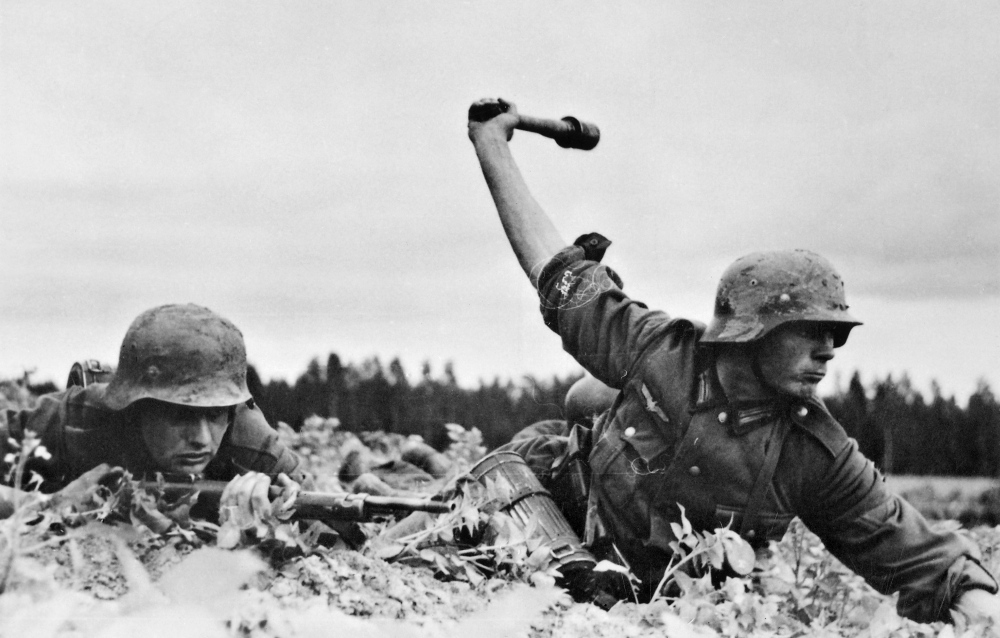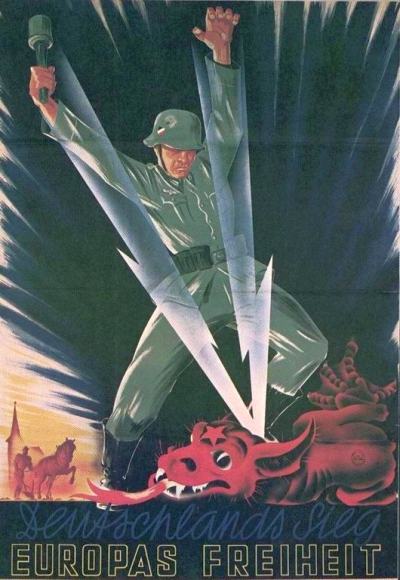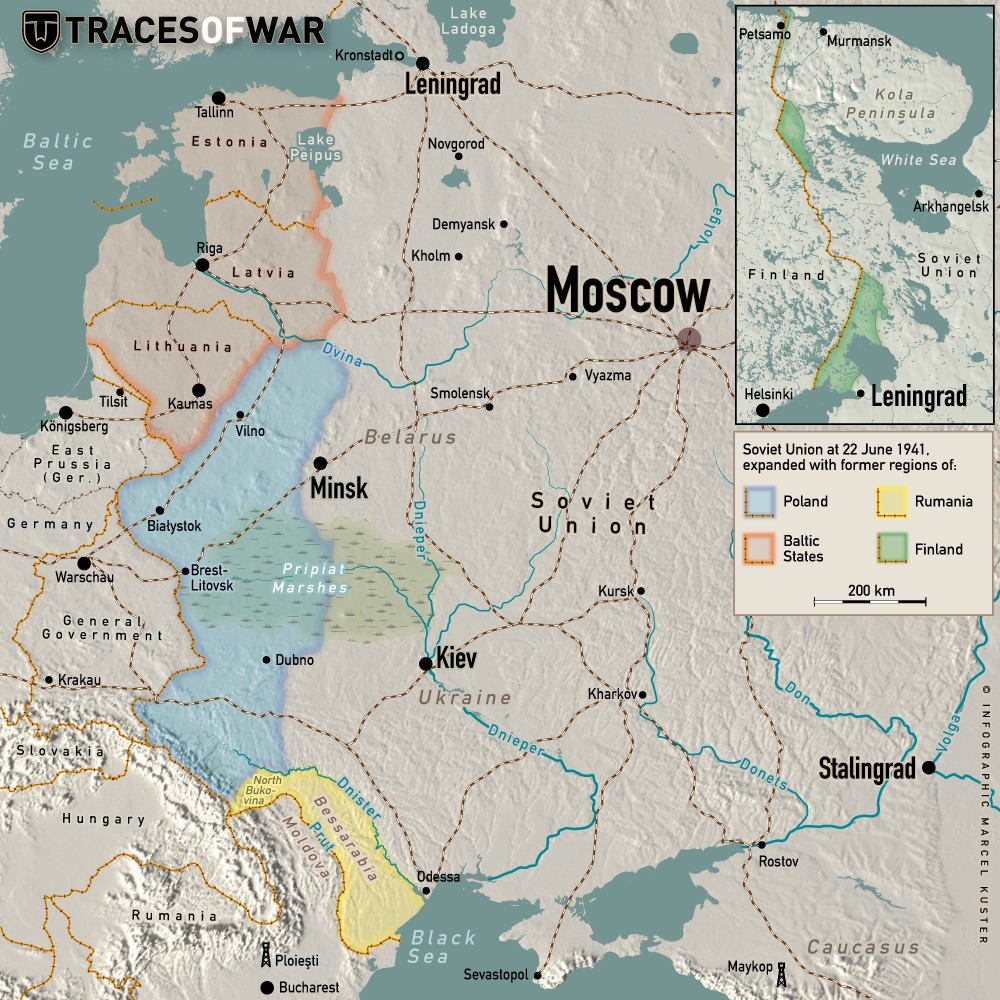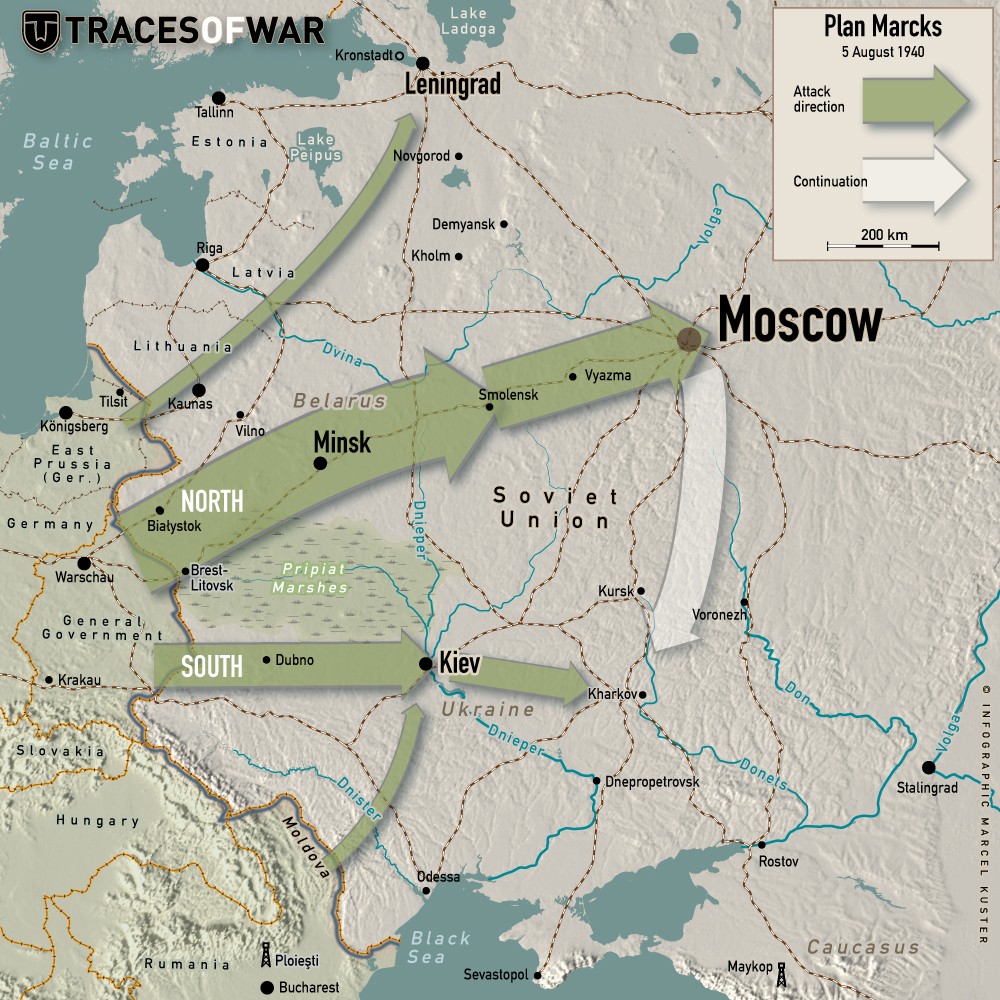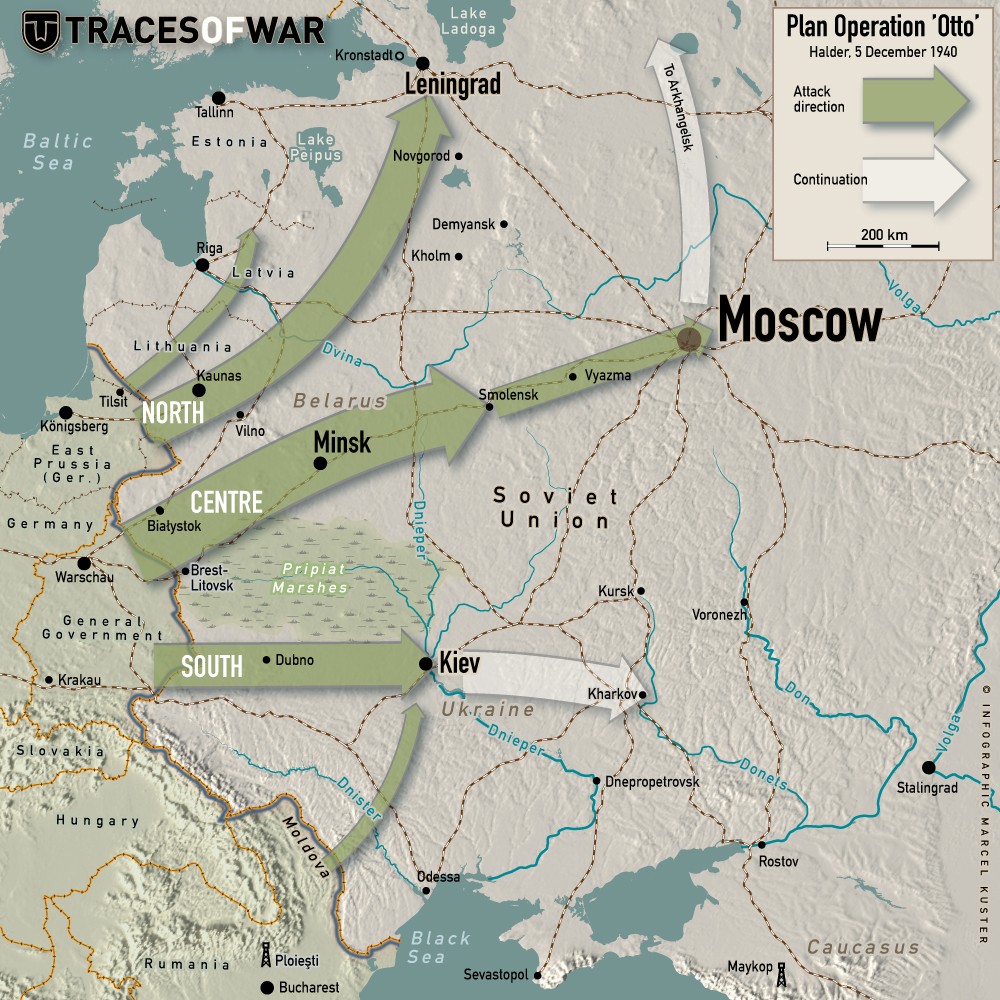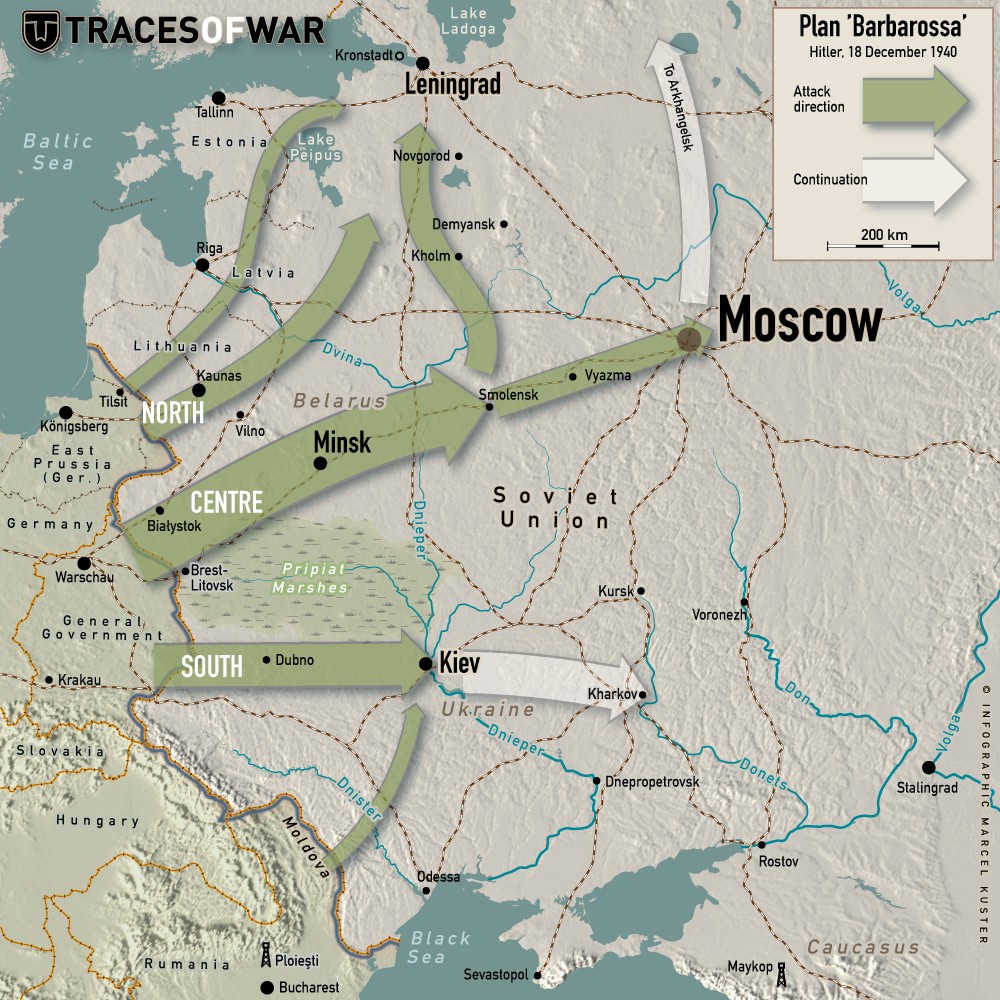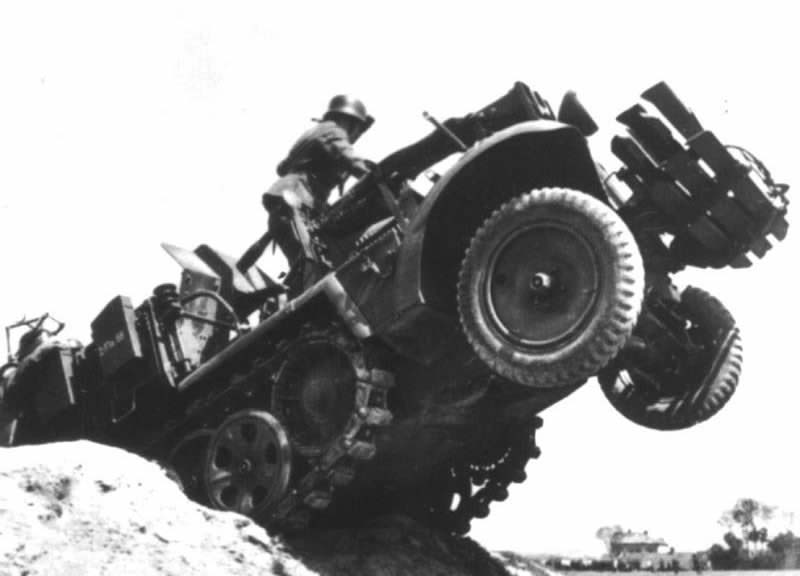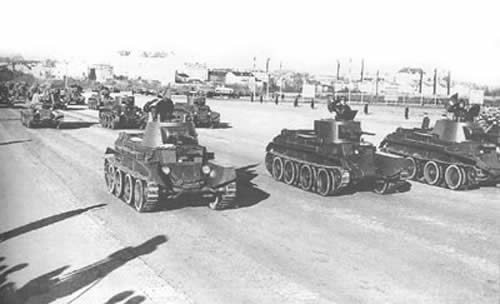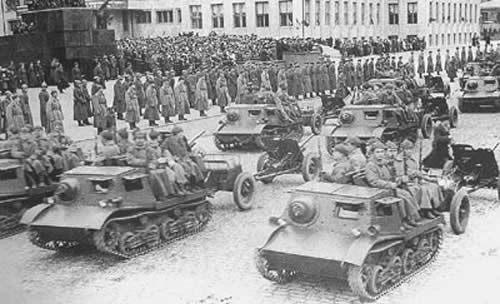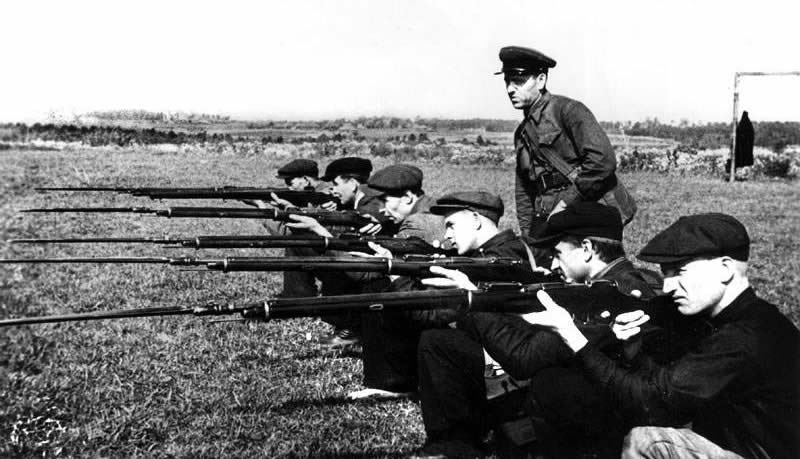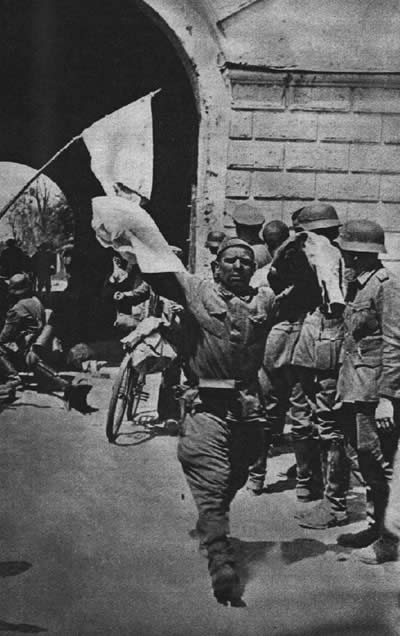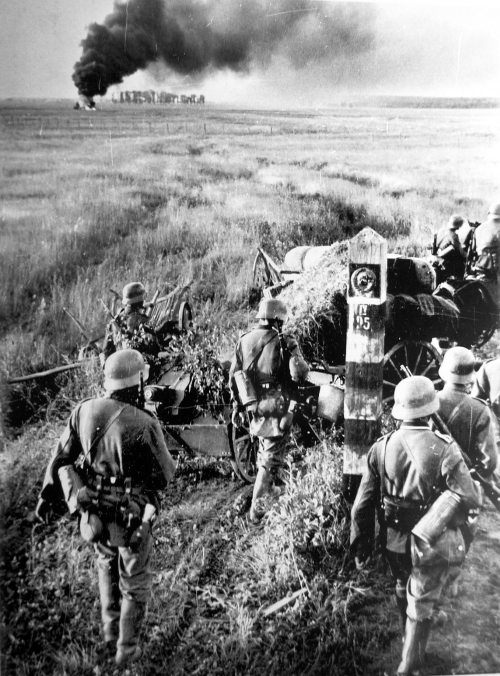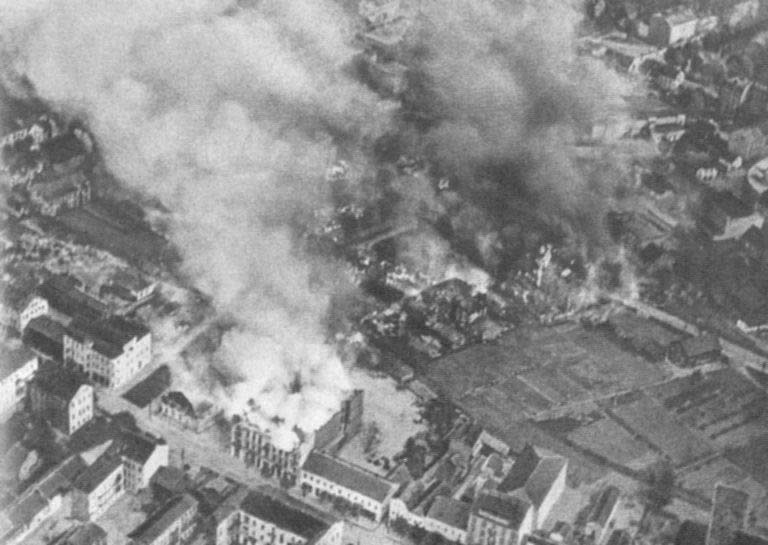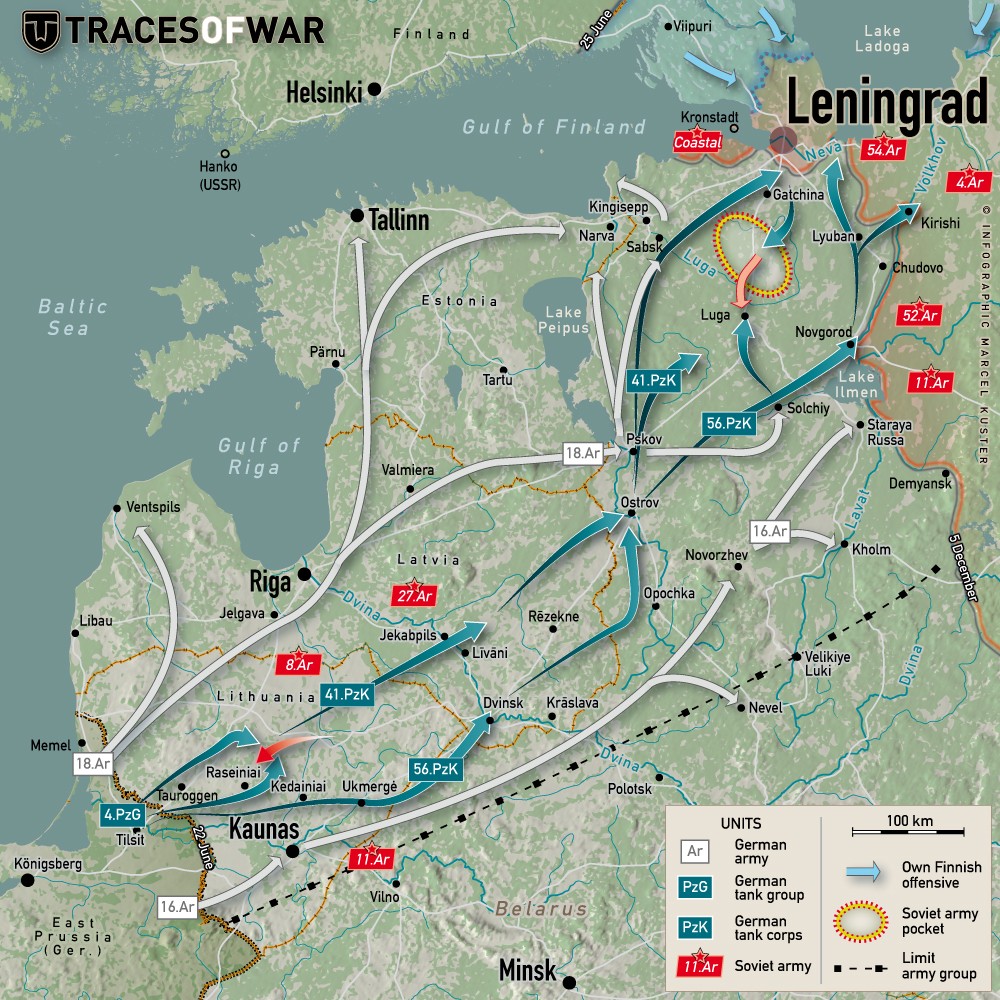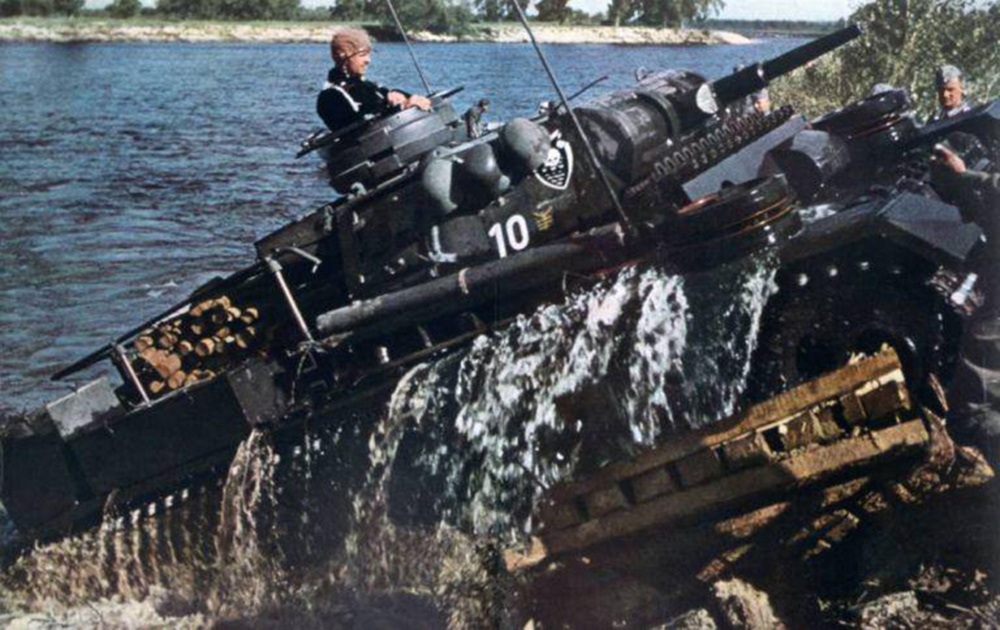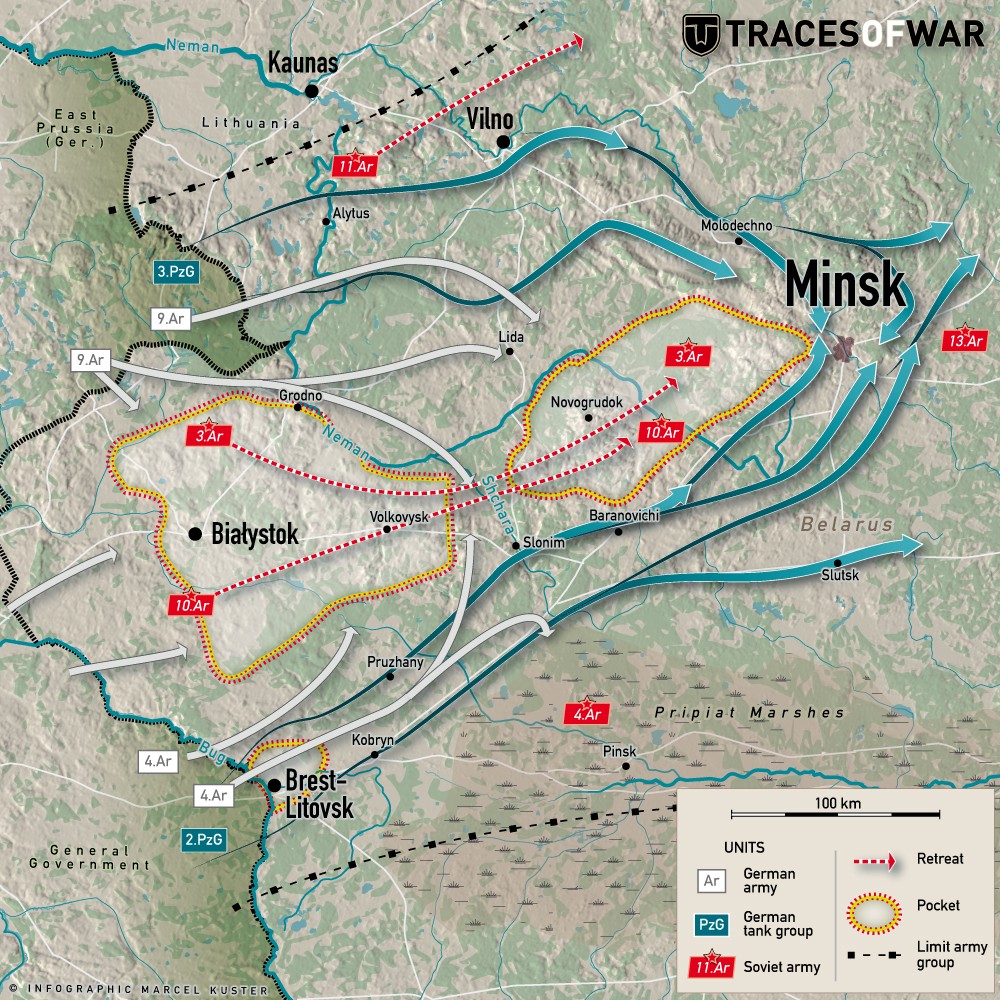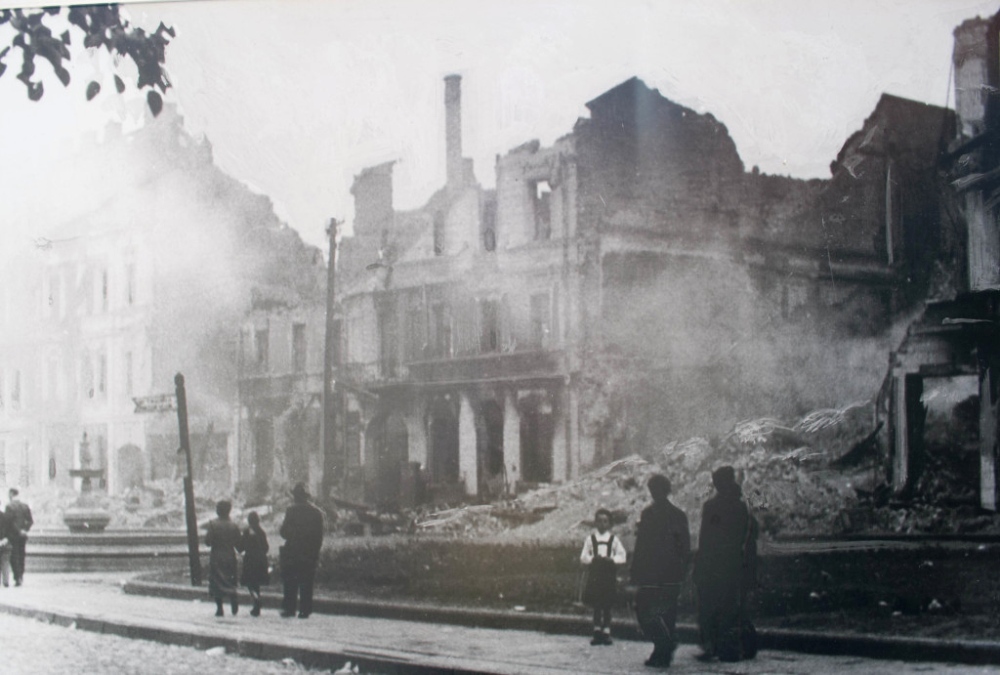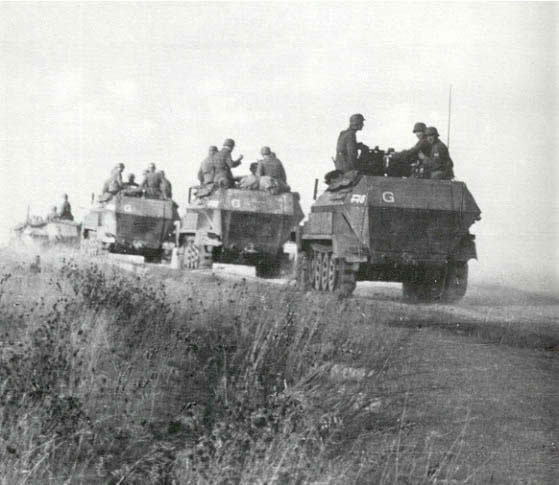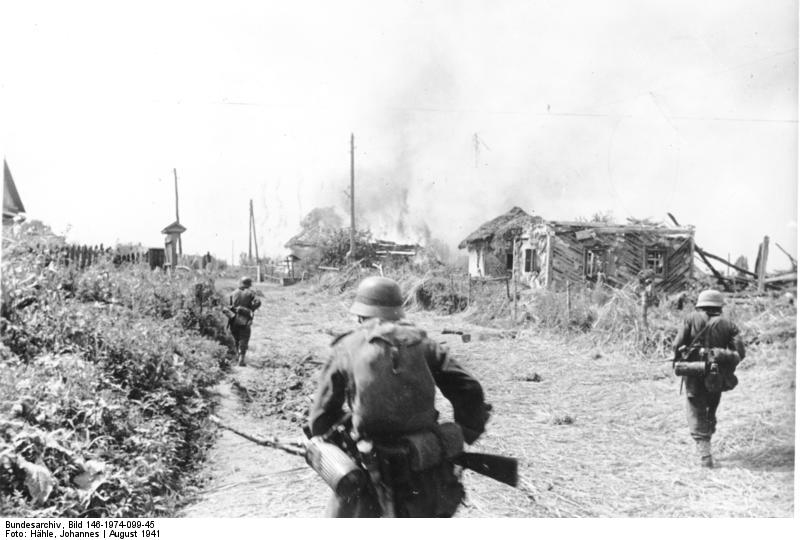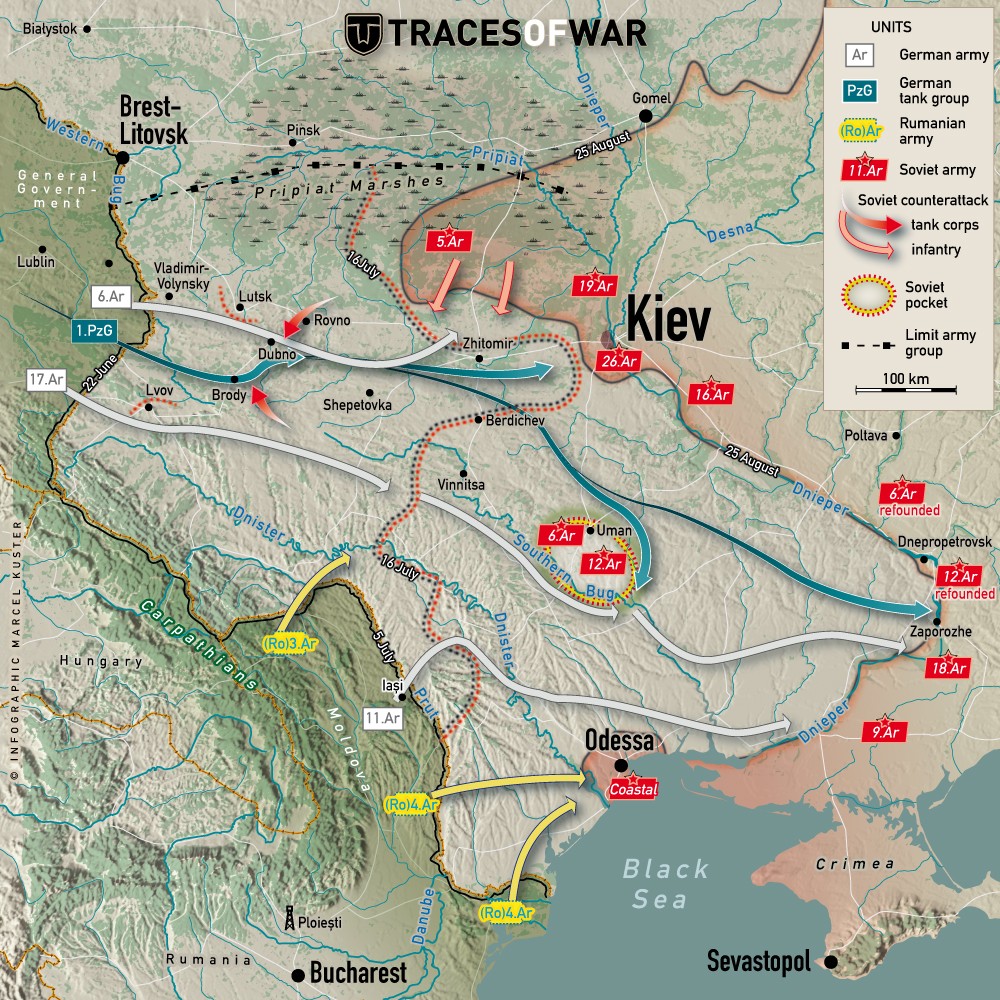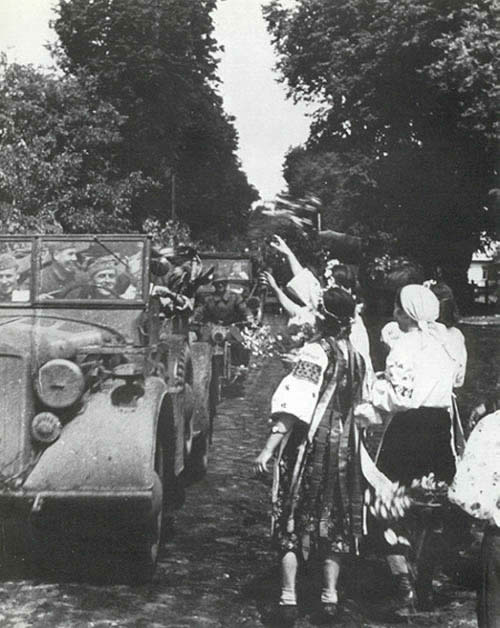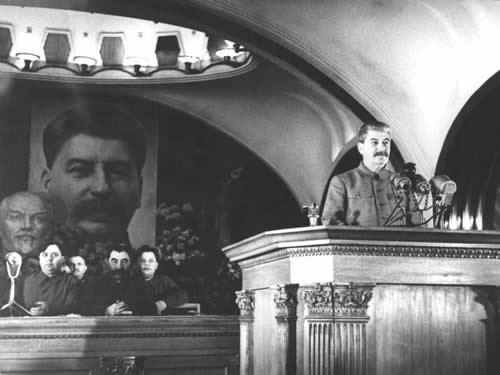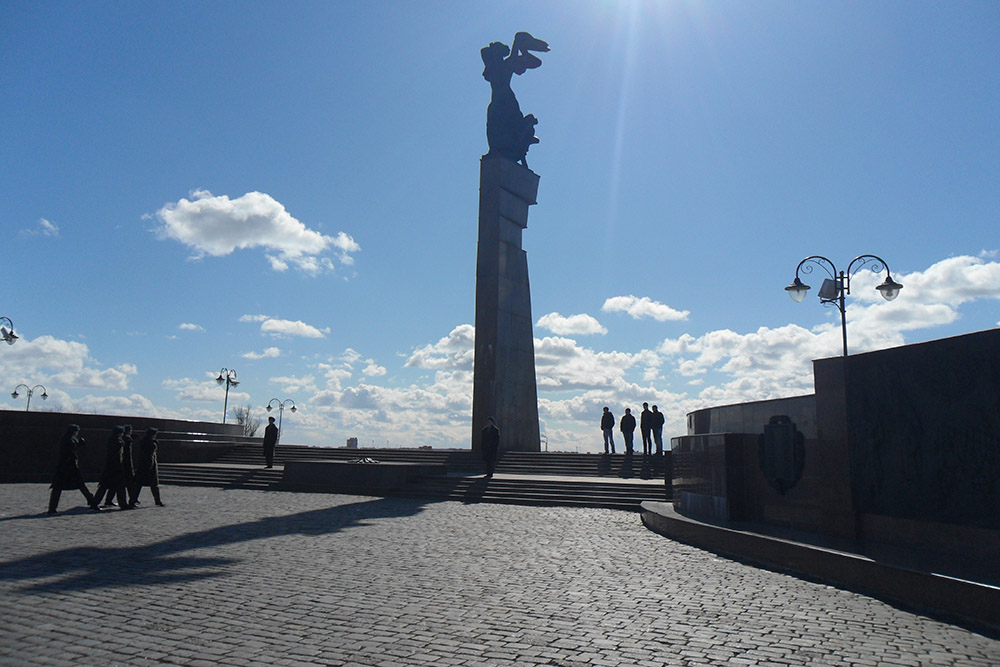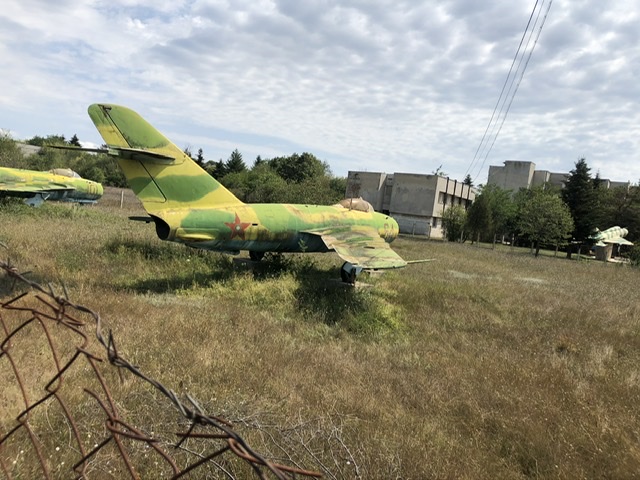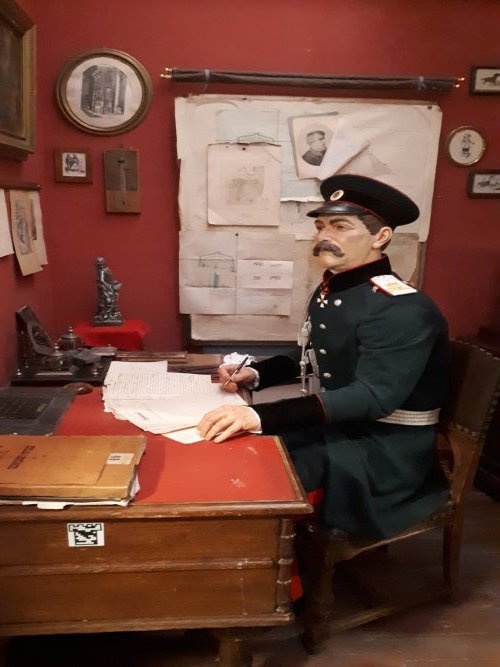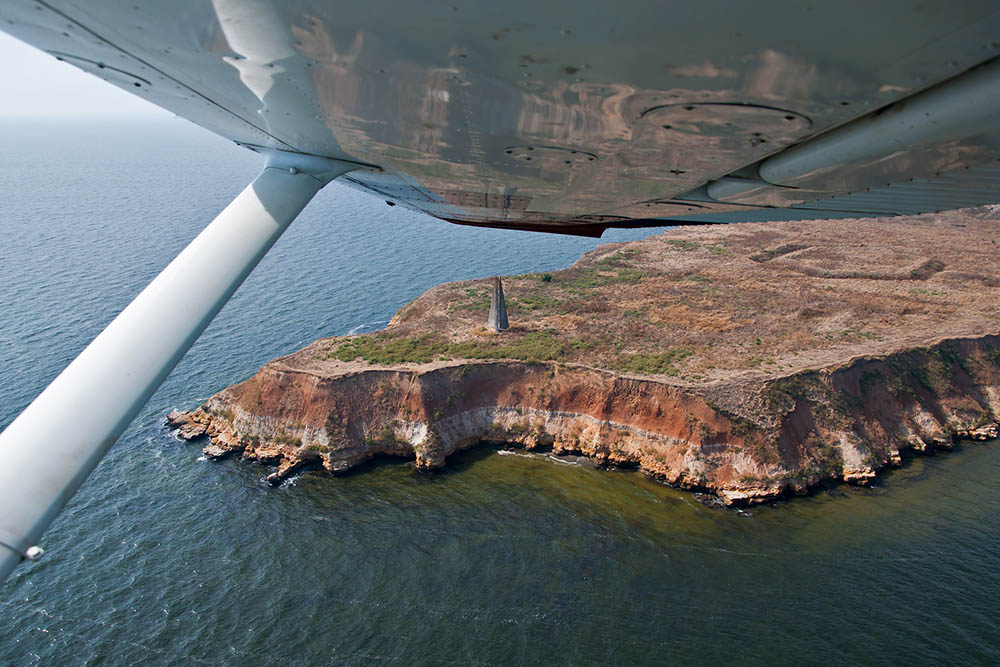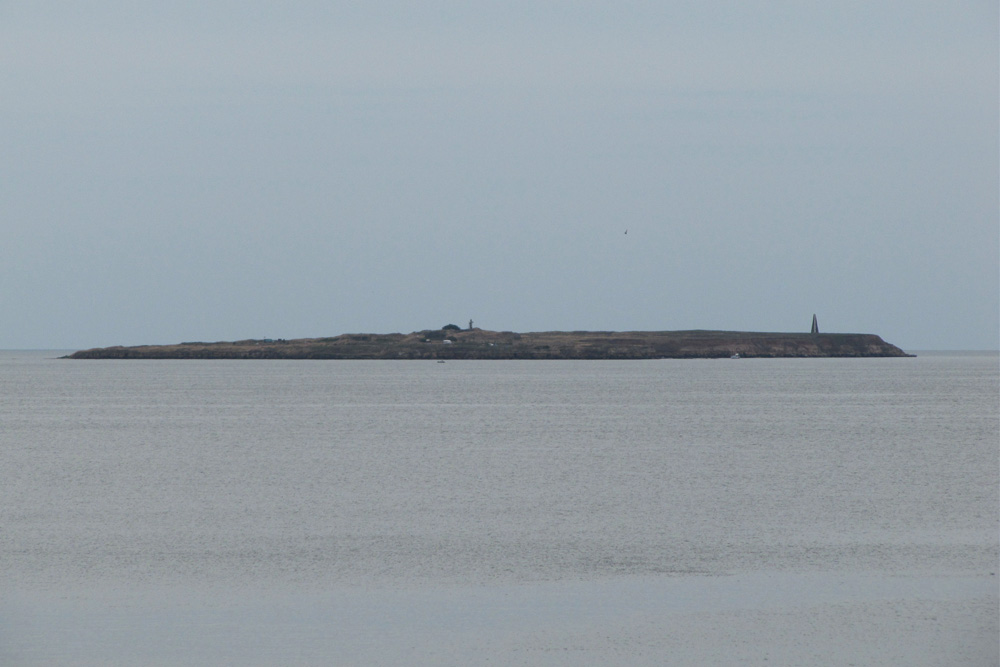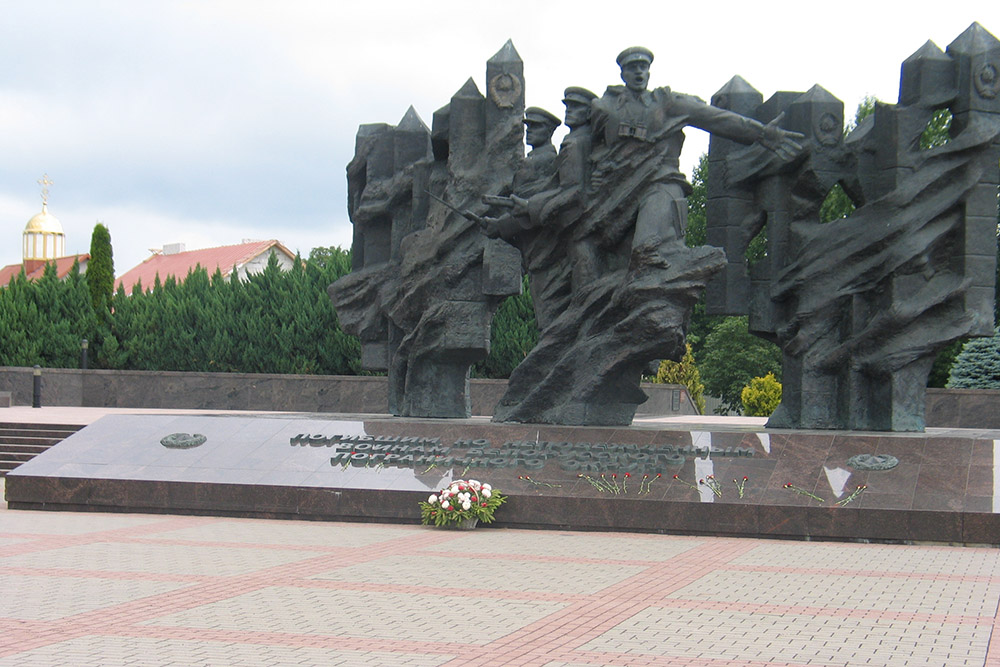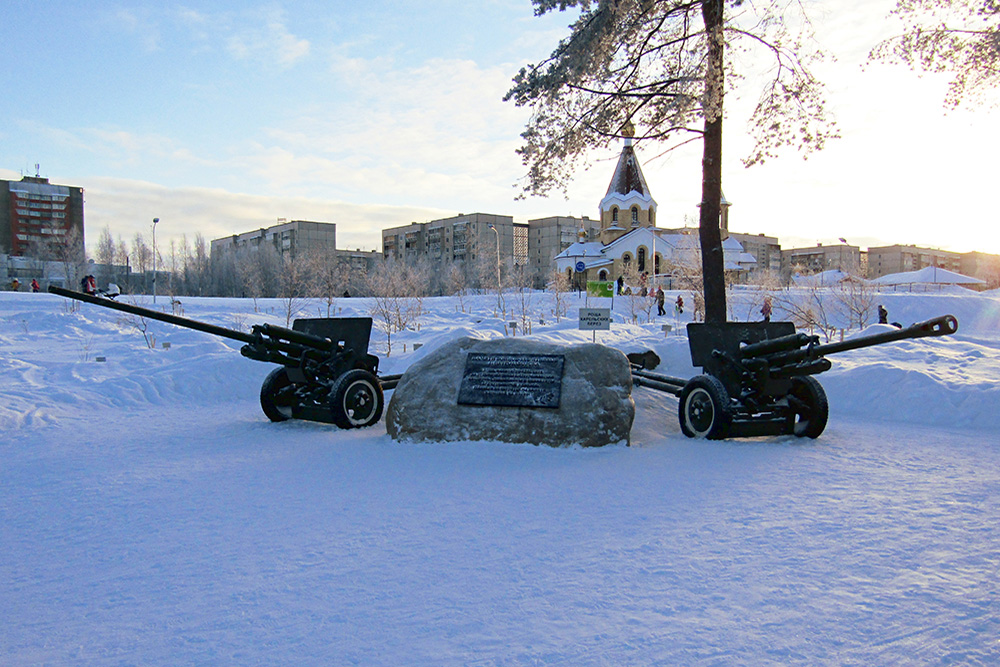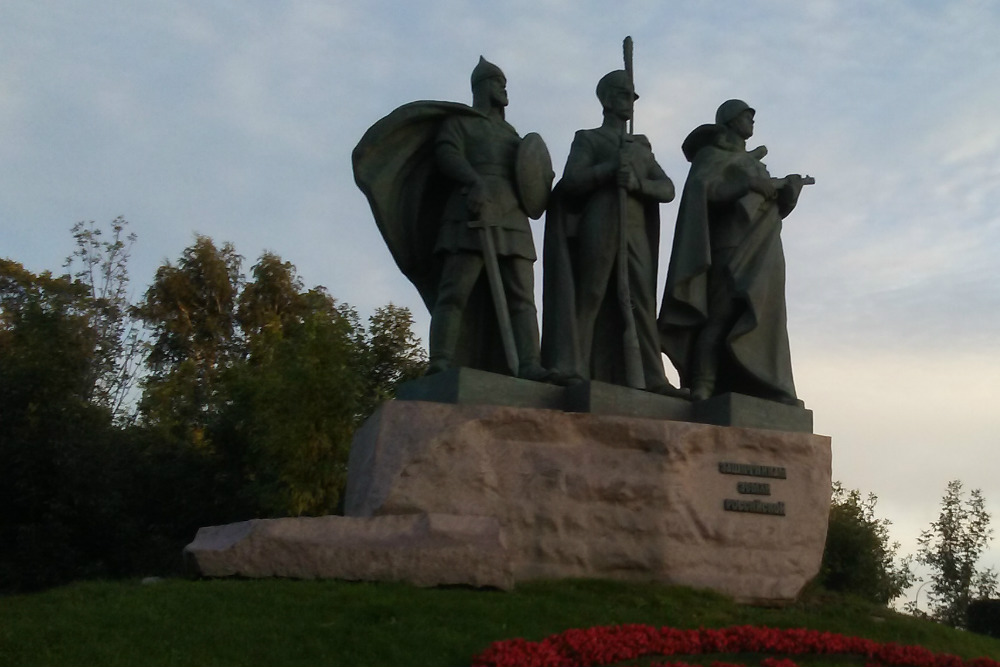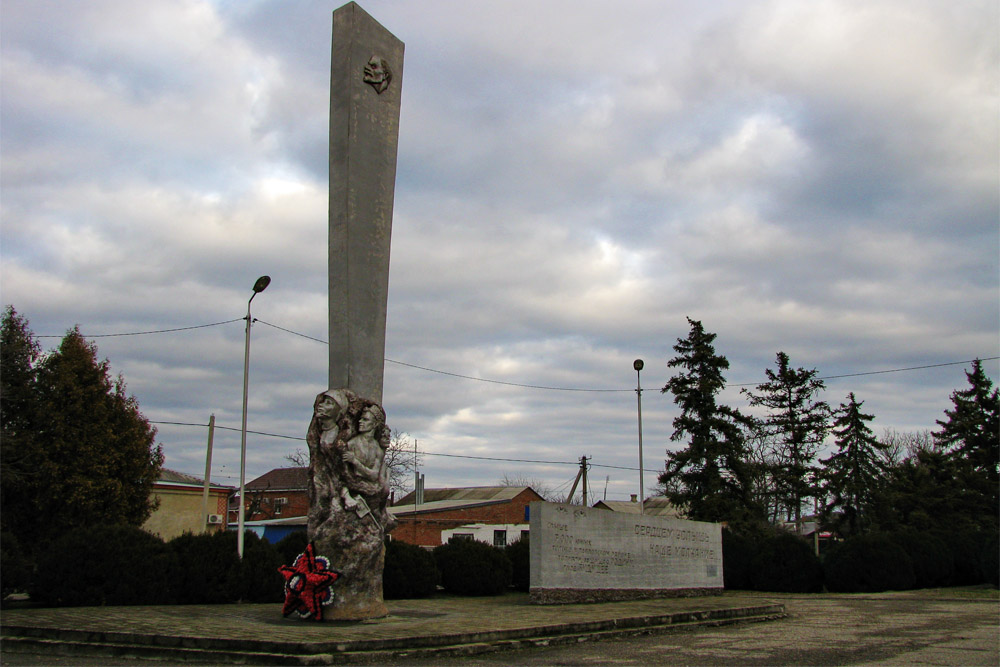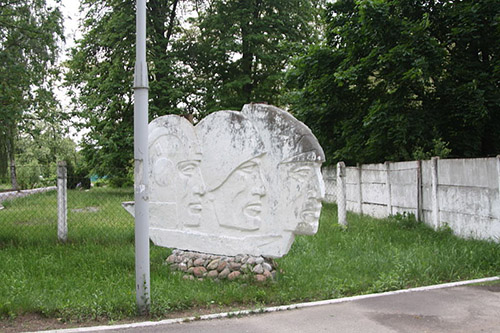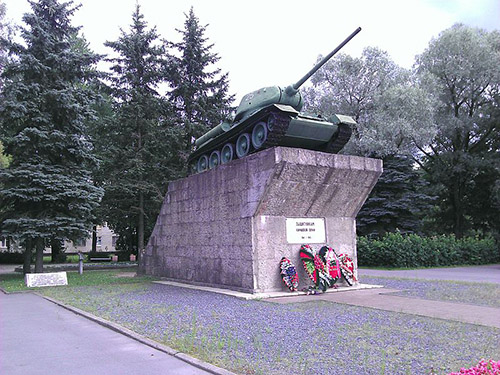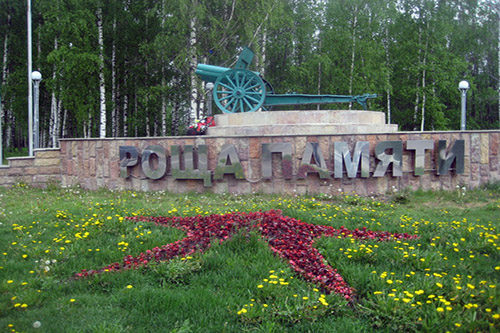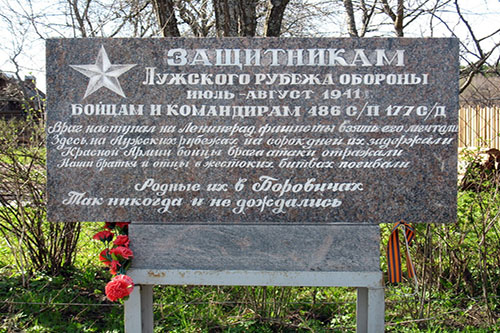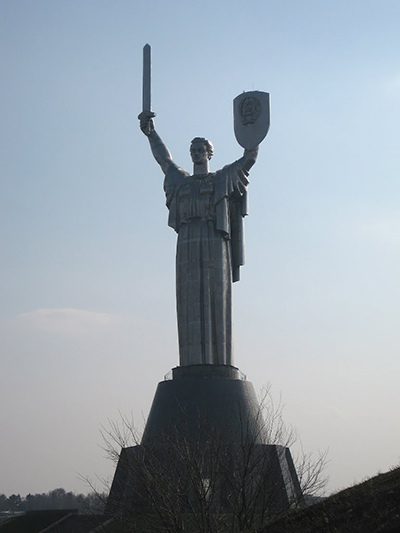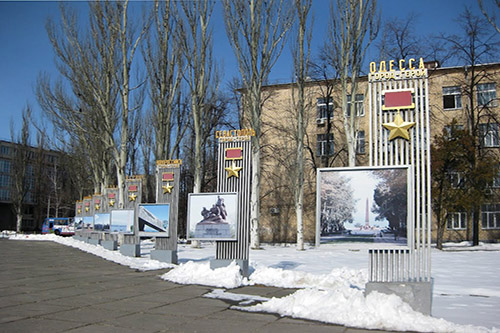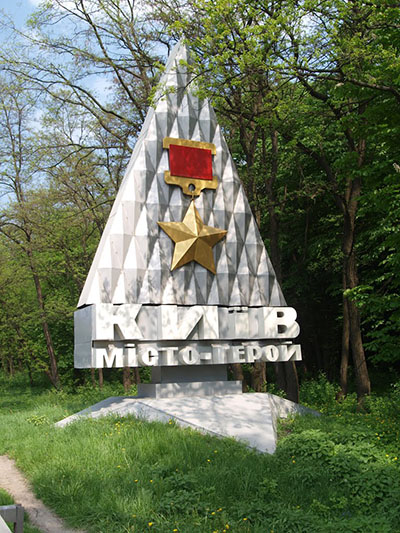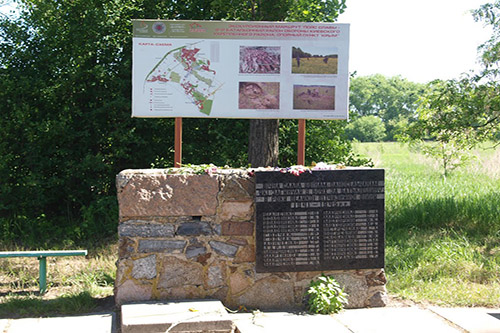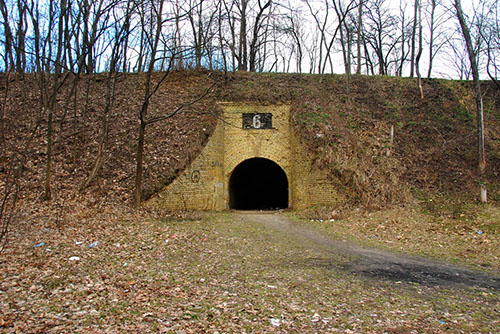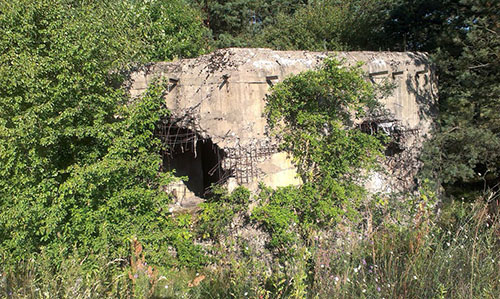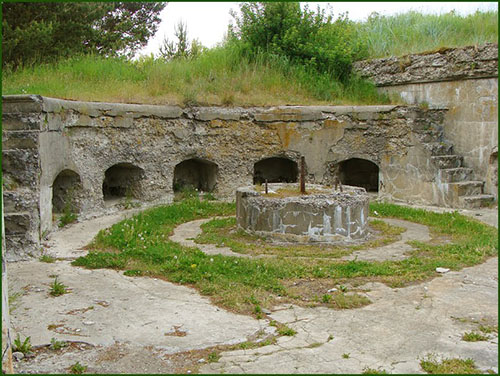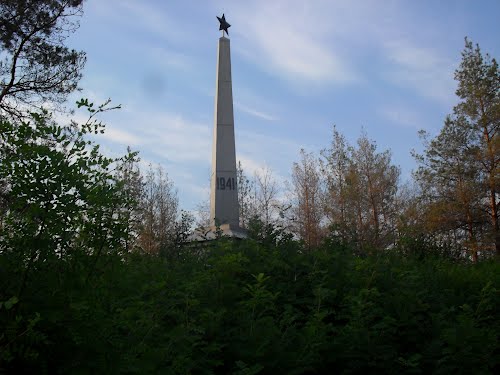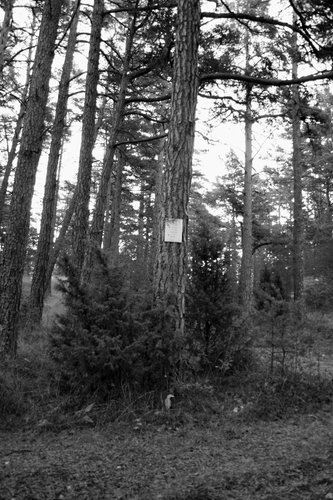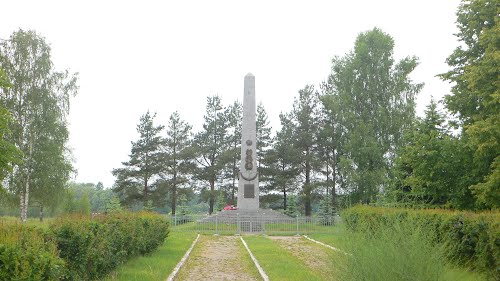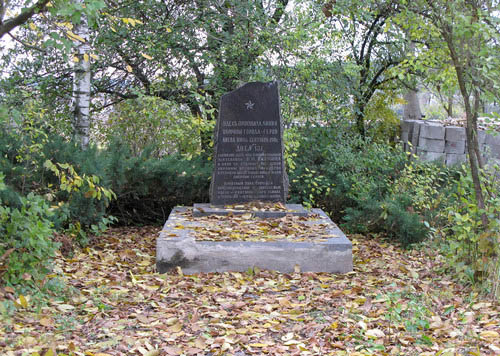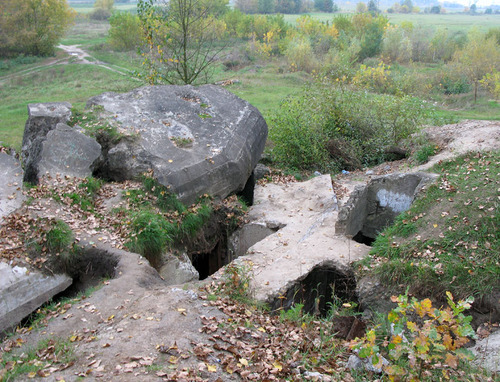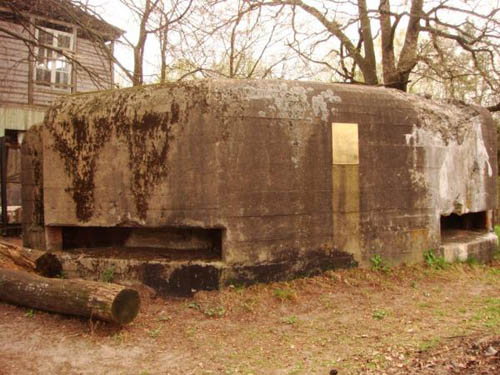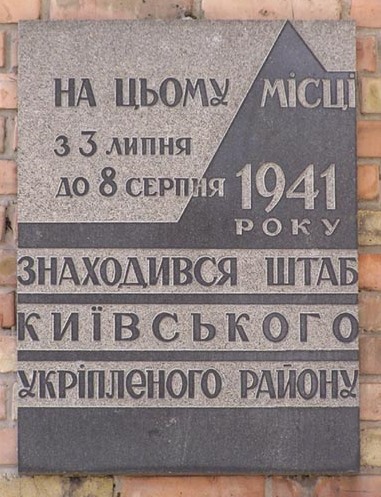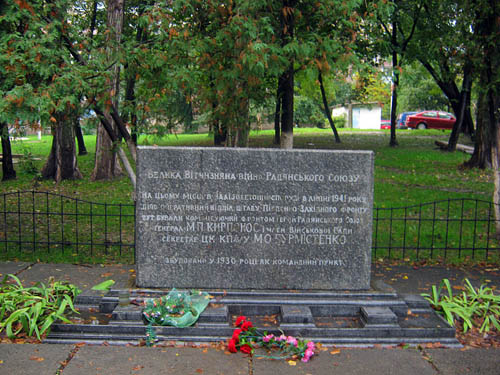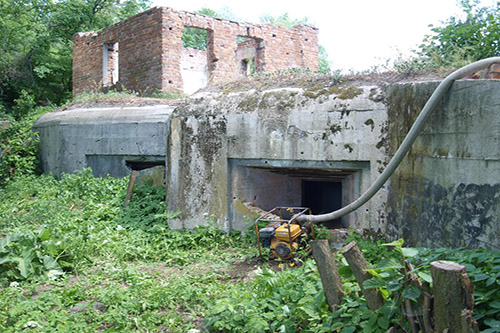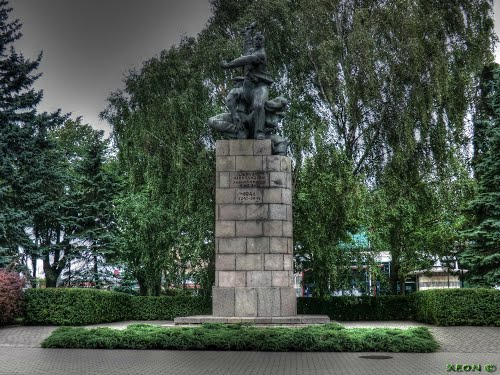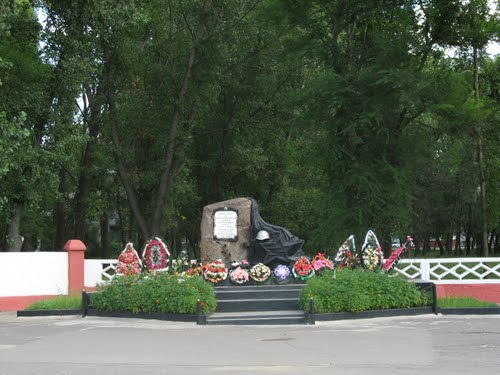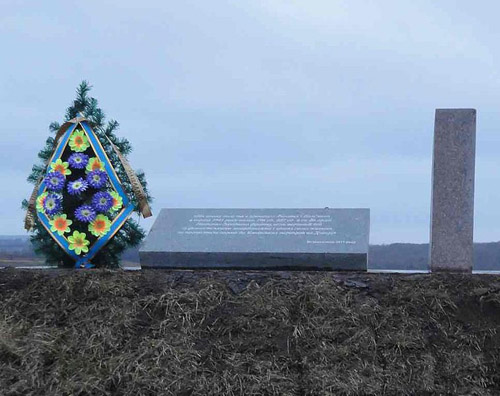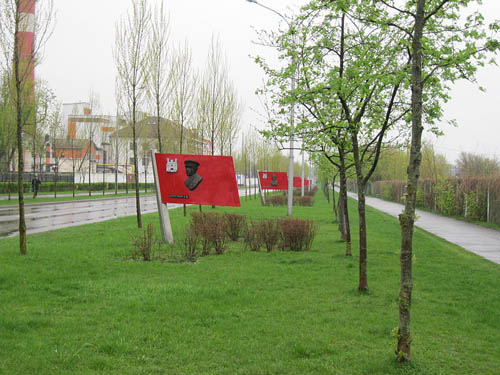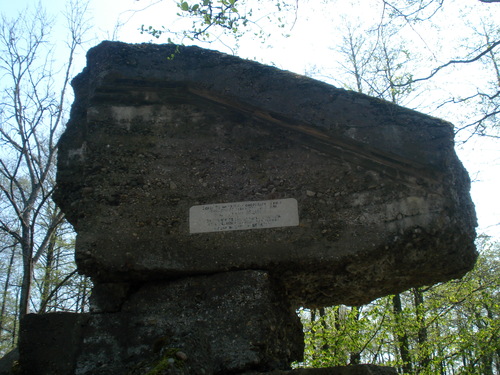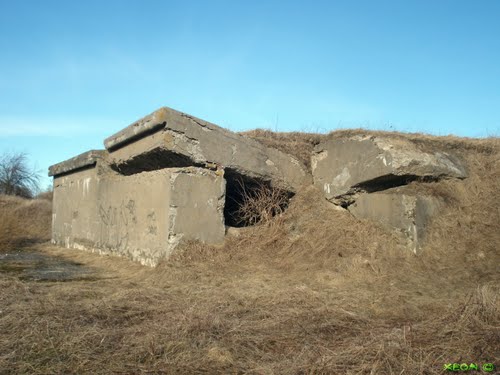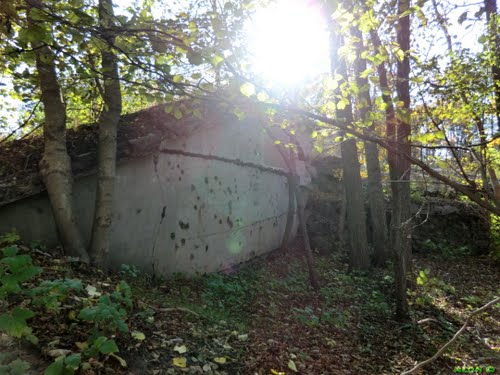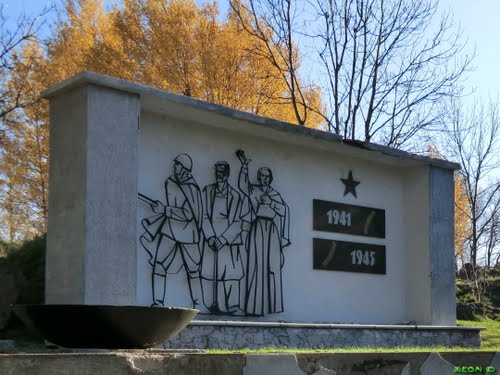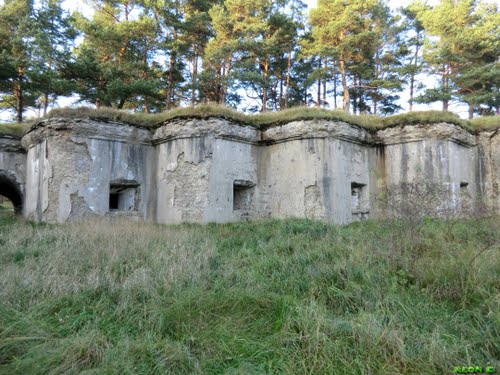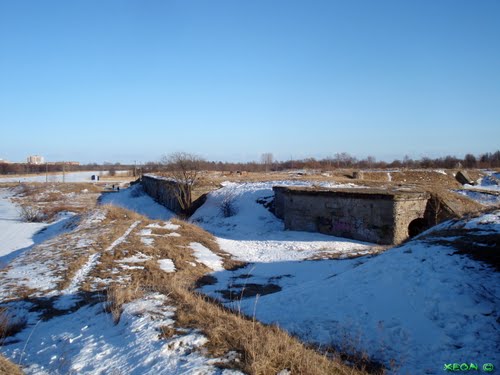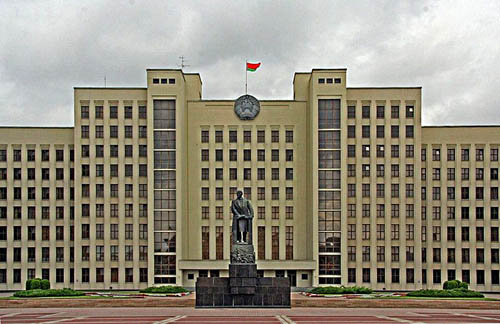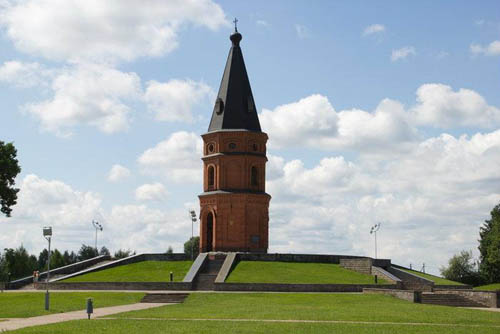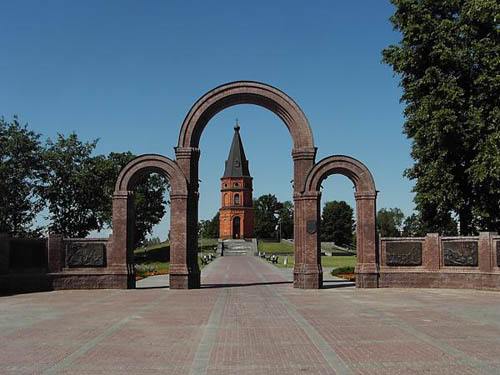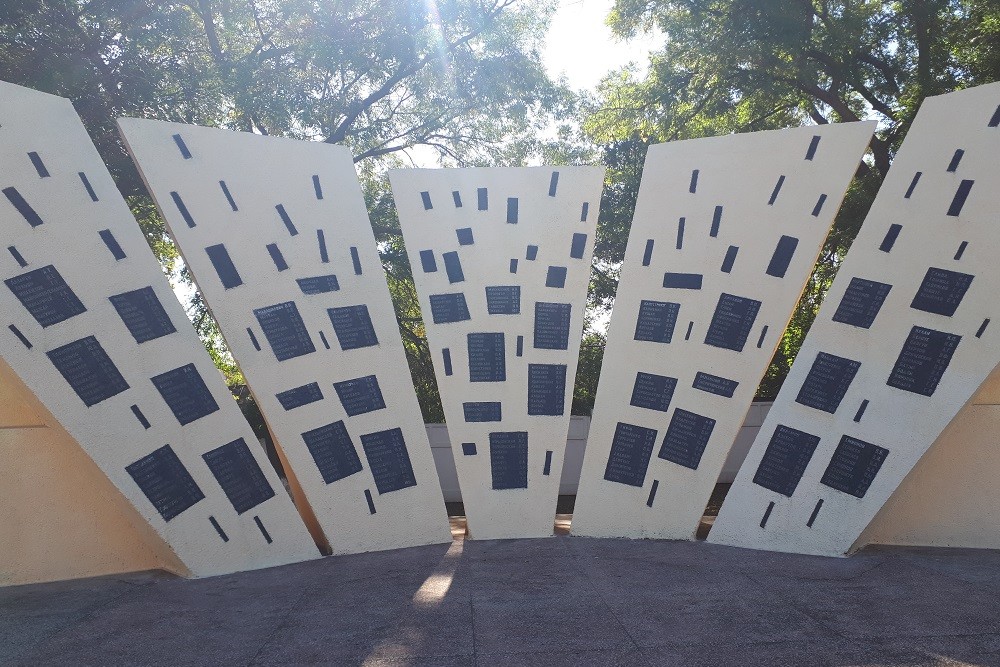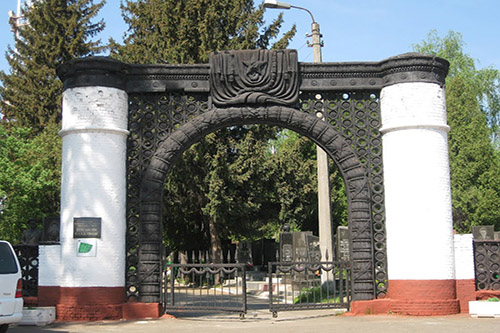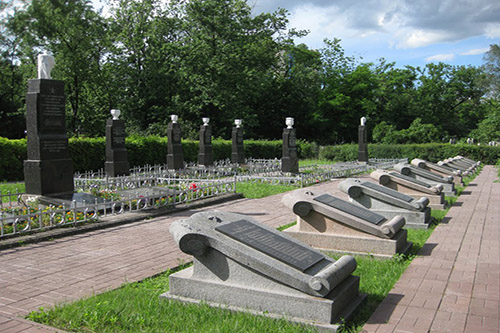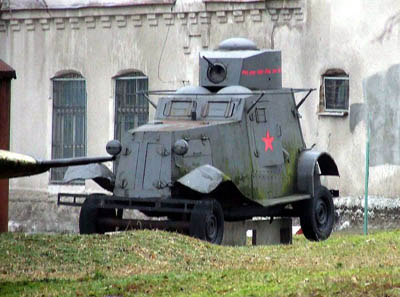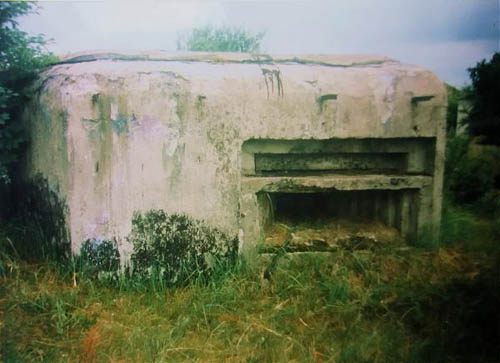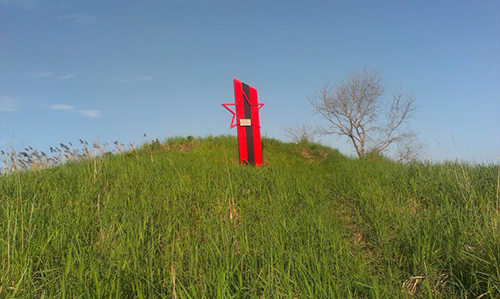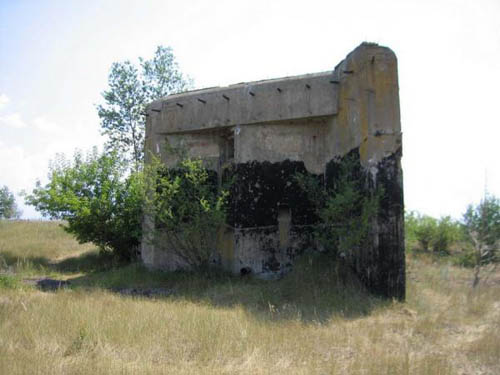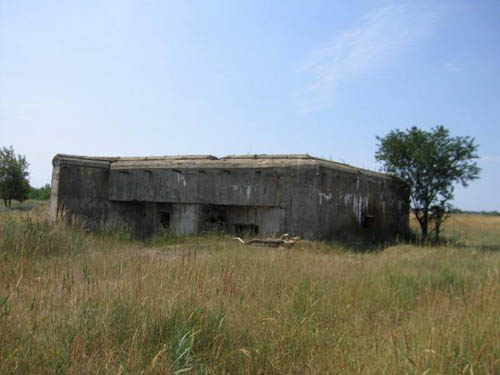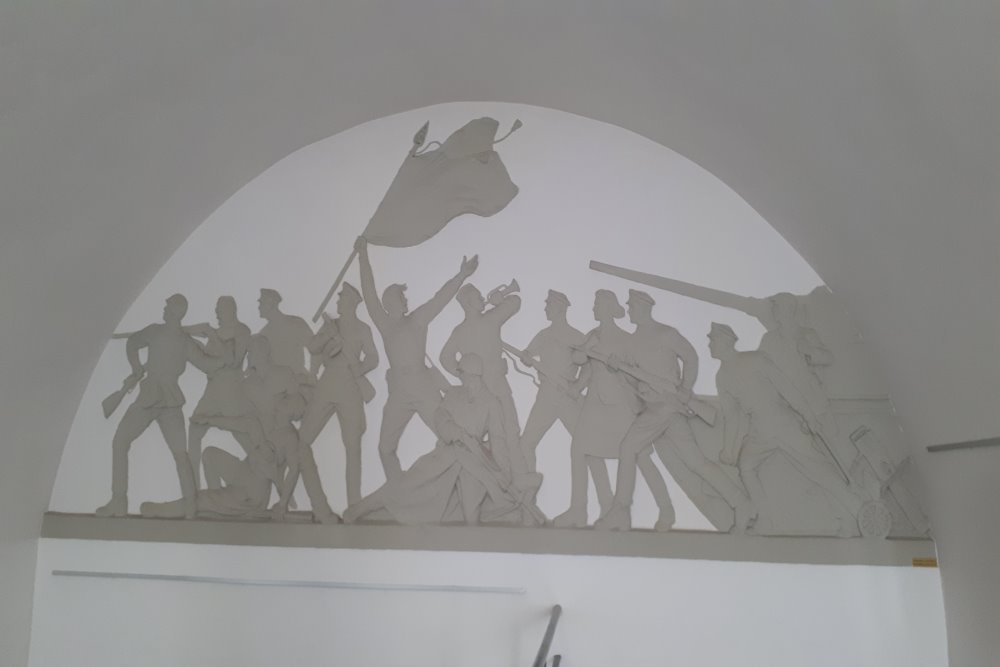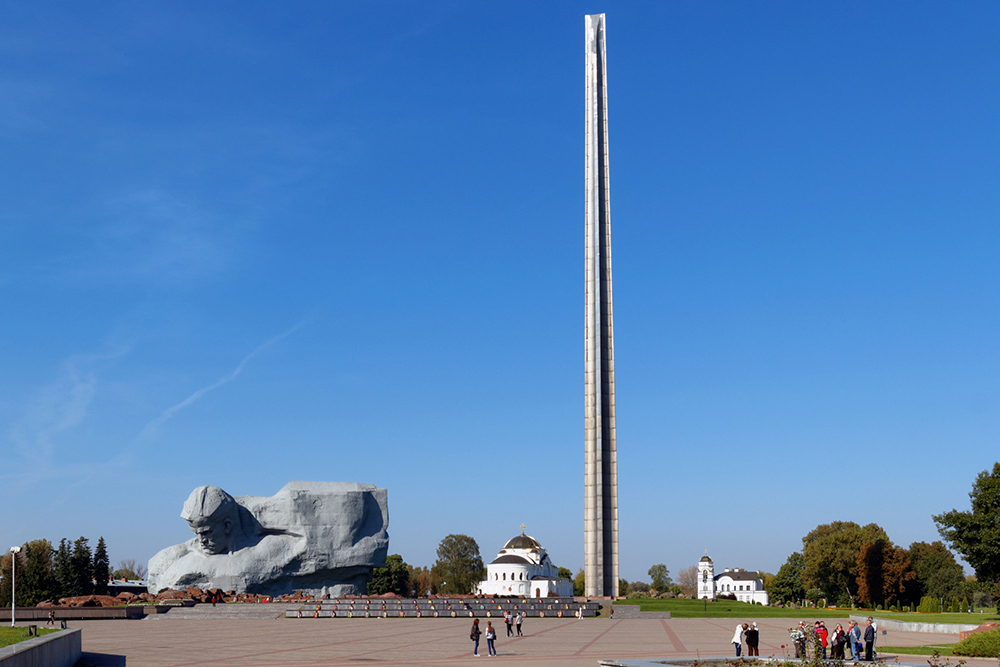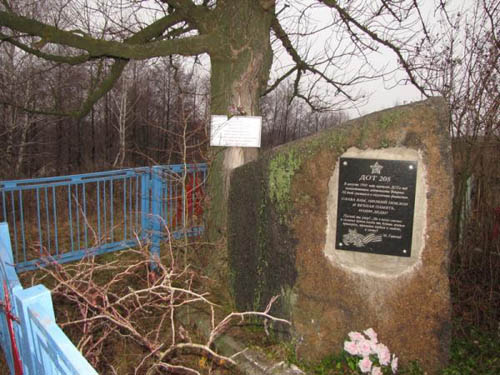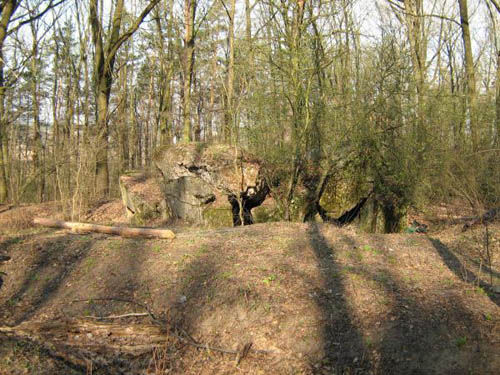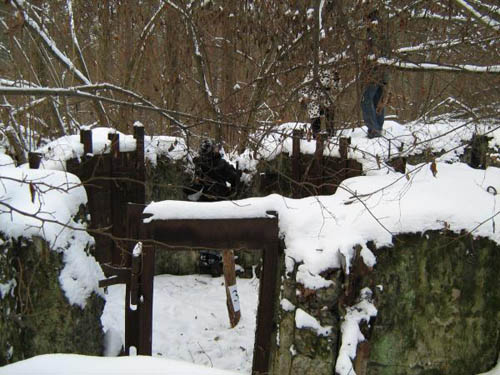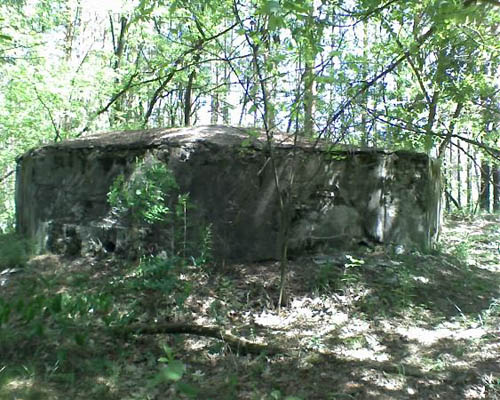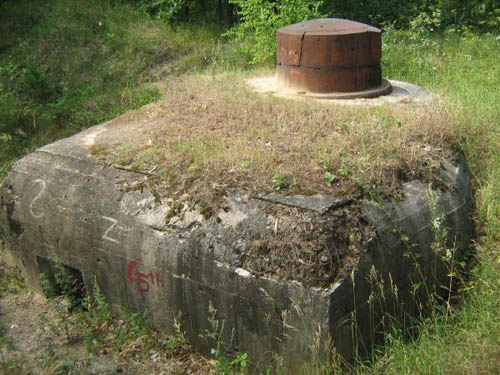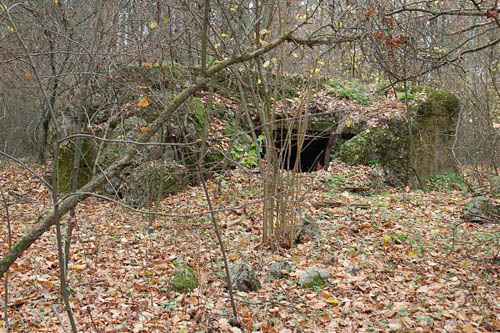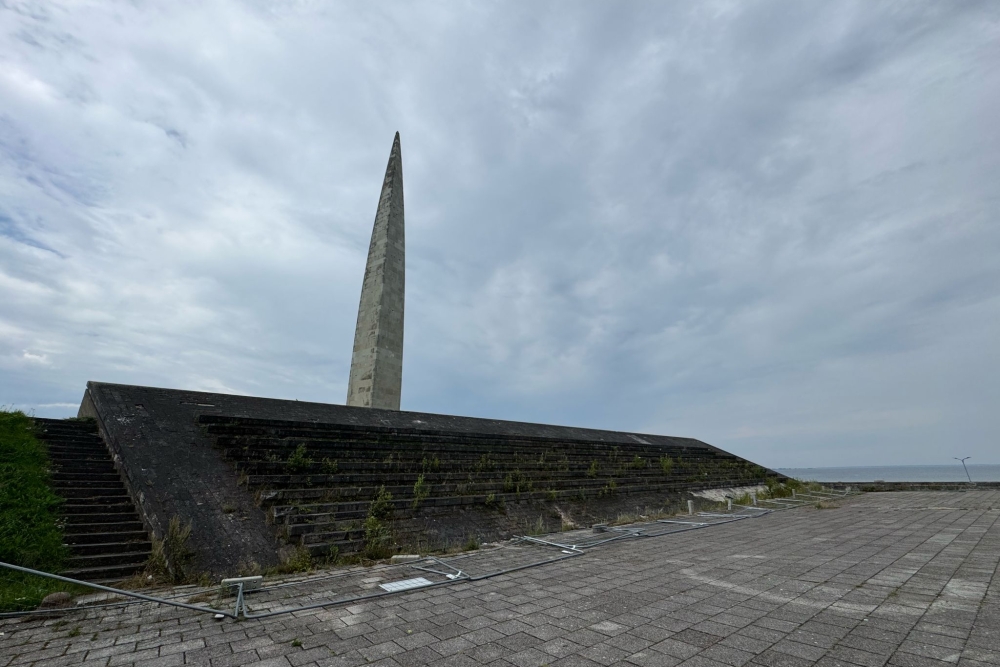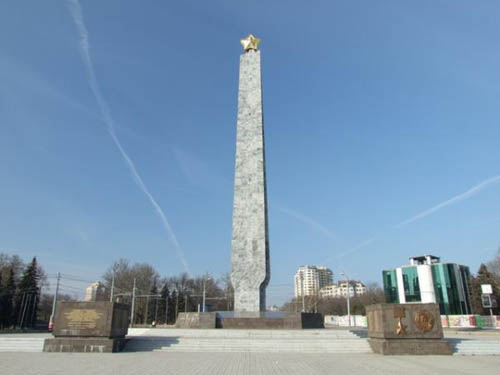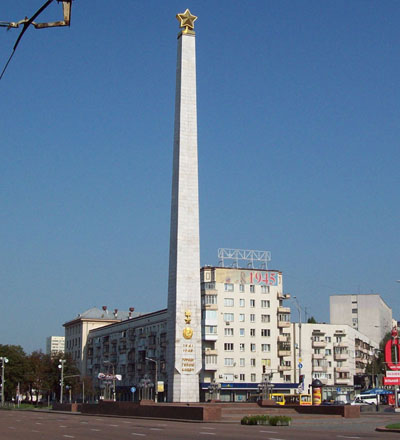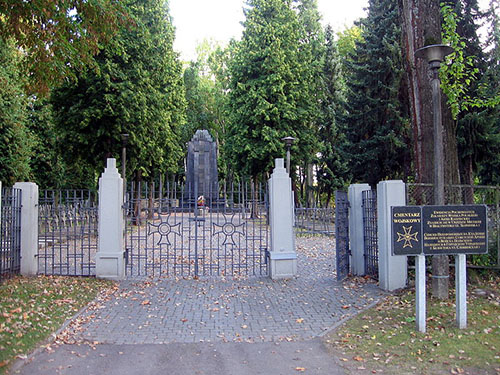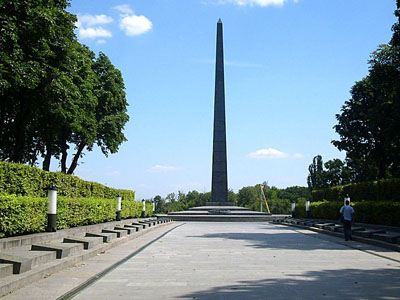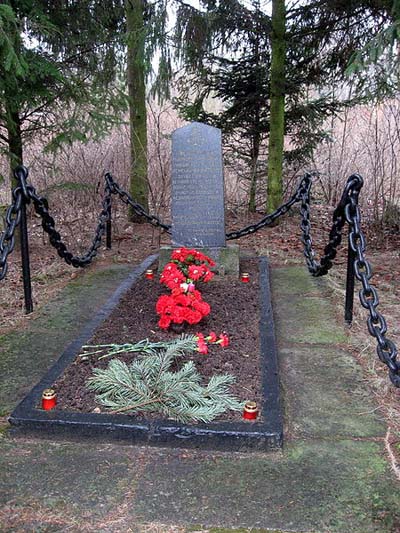Introduction
Operation Barbarossa may well be one of the most intriguing events in military history In any case, the German invasion of the Soviet Union was the largest military operation until then. On June 22, 1941, over 3 million German soldiers in three army groups advanced eastwards in order to eradicate the Red Army once and for all.
Definitielijst
- invasion
- Armed incursion.
- Red Army
- Army of the Soviet Union.
- Soviet Union
- Soviet Russia, alternative name for the USSR.
Prior to the invasion
Hitler’s personal crusade
During the twenties, Adolf Hitler had already indicated in his political testament Mein Kampf that Germany’s ultimate goal lay in the East. There, in his words, would be sufficient space, Lebensraum to meet the needs of the entire German population. In addition, Hitler considered Bolshevism his arch enemy. He claimed Communism was a part of an international Jewish conspiracy. It was Hitler’s intention that the war against the Soviet Union was to be the largest war of extermination in human history. This goal was intensified by the notorious Kommisarbefehl in which captured Soviet Kommissars were to be executed immediately. Moreover, Hitler used the argument that the Soviet Union had neither signed the Geneva Convention, nor the Hague Convention, giving the German soldiers a free hand in committing war crimes on a large scale without having to answer to military courts.
The murderous goals of Barbarossa had been indicated clearly, in contrast to the military objectives. As it was, the Wehrmacht lacked a strategic ultimate goal. The marching orders for Operation Barbarossa only mentioned the necessity to destroy the Soviet armed forces. The geographic ultimate goal became unclear immediately. This caused insecurities about the strategy to be followed between Hitler on the one hand and the general staff of the OKW (Oberkommando der Wehrmacht) and the OKH (Oberkommando des Heeres) on the other hand. The commanders in the field, who actually had the best insight into the strategic situation, had trouble understanding the tasks allocated to them and during the campaign they were at odds with both Hitler and the general staff. In this way Adolf Hitler created insecurities and rivalries between the units concerned and the commanders, perhaps on purpose. Operation Barbarossa clearly was his own personal crusade. This would gradually become clearer as the war against the Soviet Union unfolded.
Joseph V. Stalin had done all he could to prevent the inevitable confrontation between the two totalitarian states. The Molotov-Von Ribbentrop Pact of August 1939 had made Stalin think he could keep the Soviet Union out of the war. In additional secret protocols, Eastern- Europe was divided between Germany and the Soviet Union. In September 1939, Germany had run the gauntlet during the campaign against Poland after which the Red Army advanced into Eastern Pomerania and had demanded its share. While Hitler was sure the Soviet Union wouldn't intervene in a war against France and Great-Britain, Stalin focused on the Baltic States and Finland which had been allocated to the Soviet Union in the secret protocols. Soviet garrisons and naval bases were established in Estonia, Latvia and Lithuania but Finland was unwilling to give in to the Soviet demands and give up territory. Consequently, a military conflict erupted in December 1939 which would be known as the Winter War.
Shame on the Red Army
The Red Army invaded tiny Finland with a majority in men and material. The Finnish troops, extremely well trained, managed to outclass the Soviets however by using guerilla tactics where brigades on skis in the snow covered woods cut the Soviet mechanized columns to pieces (the motti tactics) and destroyed them. Losses on Soviet side were disastrous and in January 1940, changes were made within the Soviet high command. After the arrival of additional reinforcements, the Mannerheim line was finally breached and consequently, on March 13, 1940, a peace treaty was agreed upon. During the Winter War, the Soviet Union may well have achieved her military goals but at the cost of horrendous losses. The Red Army had shown such a lack of efficiency that her reputation, gained during the thirties, was lost for the most part.
Hitler now turned his attention westwards though where in April 1940, the Wehrmacht executed a brilliant operation, Operation Weserübung By the combined deployment of land, sea and air forces, Norway and the French and British forces fighting there, were forced to surrender.
May 1940
Even before hostilities in Scandinavia had ceased, the Wehrmacht struck at Western-Europe as well. On May 10, 1940, German forces invaded the Netherlands, Belgium and Luxemburg, crossing into France within a few days. With this operation, code named Fall Gelb, the German forces lured the Allied armies to the north in order to subsequently separate them from the rest of France by a strong attack through the Ardennes and further along the French-Belgian border.
Not all isolated troops managed to escape during the spectacular evacuation from Dunkirk but they were no longer operational. They had had to leave all their heavy weaponry and other equipment behind on the beaches and there were no replacements. What followed was the battle of France which ended like it had begun: with a French government incapable of taking the initiative and resigning to German control: Vichy France.
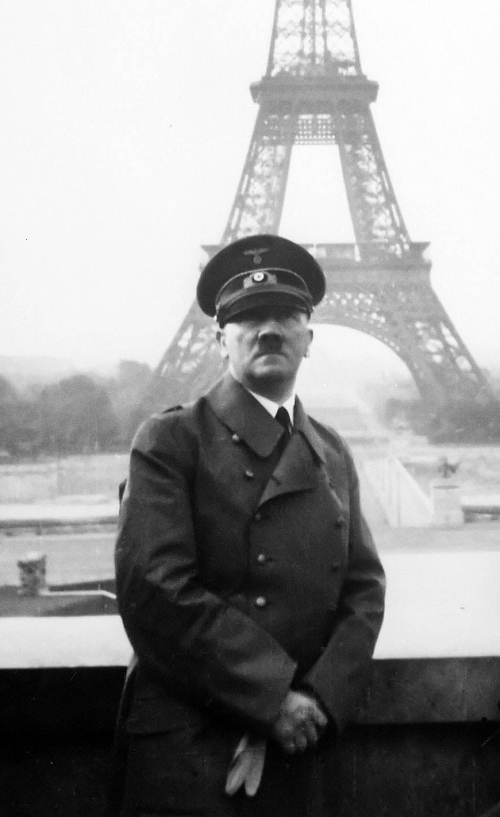
Hitler in Paris at the pinnacle of his power. With Great Britain isolated in the west, the road was clear for conquests in the East Source: National Archives and Rcord Administration
Stalin was stunned by the quick German victories in the west because he had seriously reckoned with a war of attrition. Stalin took precautionary measures and decided to strip the Baltic states of their independency and officially annex Estonia, Latvia and Lithuania in summer. He aroused Hitler’s anger by occupying the German part of Lithuania as well. Subsequently the Soviet Union rushed to gobble up Bessarabia and North-Bukovina as well which wasn’t part of the deal. This way, the Rumanian oil fields came well within range of the Red Army.
Meanwhile Hitler had risen to the pinnacle of his power after the fall of France. He was convinced that the British were as good as defeated and he wanted to attack the Soviet Union immediately. The German generals were stunned and managed to convince Hitler that an attack on Russia in the fall of 1940 would be an impossible undertaking.
The battle of Britain
The Wehrmacht meanwhile had set its sights on Great-Britain. The British had managed to retrieve most of their armed forces during the evacuation from Dunkirk and were preparing for a German invasion. Prior to the campaign against France and the Low Countries, the Germans hadn't drafted any plans yet for an invasion of the British Isles. The Germans had hastily started planning the invasion of Great-Britain, code named Operation Seelöwe. Hitler hardly paid any attention to the campaign against England. During talks on July 21, 1940, with the commander-in-chief of the army, Generalfeldmarschall Walther von Brauchitsch and the chief of staff of the OKH GeneraloberstFranz Halder, Hitler revealed his dark intentions in deepest secrecy: ‘We have to get rid of Russia.
Nonetheless, the battle of Britain kicked off in mid-August 1940 with large scale actions by the Luftwaffe over the Channel and southeastern England. The Germans hoped to destroy the RAF by air strikes and force the country to sue for peace, making a bloody invasion superfluous. British fighter pilots however managed to defeat the Luftwaffe in the nick of time during heroic dogfights over southeastern England, causing the German high command to postpone Operation Seelöweindefinitely
During the battle of Britain, the Germans suffered their first strategic defeat. From then on, Hitler focused all his attention on planning an invasion of the Soviet Union. By defeating the Red Army, he thought to eliminate Great-Britain’s only possible ally on the European continent so ultimately, Britain would be compelled to surrender.
Hitler now intended to do exactly what he had always wanted to prevent in his political and military strategy: wage a war on two fronts. Indeed, the British were incapable to launch an amphibious attack on the European continent on short notice but they had already proved they were not ready to give up the fight.
Overconfident from the previous successes, German staff officers started planning a campaign against the Soviet Union. Some German generals, among them Großadmiral Erich Raeder and Generalfeldmarschall Wilhelm Keitel were very skeptical about an attack on the Soviet Union initially. The defeat of the French war lord Napoleon Bonaparte, who was defeated in 1812 in the cold and vast Soviet Union was still on their minds. But if it had to be done, it should become a quick and decisive victory.
Definitielijst
- Communism
- Political ideology originating from the work of Karl Marx “Das Kapital” written in 1848 as a reaction to the so-called class struggle between the proletariat (labourers) and the bourgeoisie. According to Marx the proletariat would take over power from the well-to-do classes though a revolution. The communist movement aspires an ideal situation where the means of production and the means of consumption are common property of all citizens. This should end poverty and inequality (communis = common).
- invasion
- Armed incursion.
- Lebensraum
- “Living space”. Nazi term indicating the need for the overpopulated German lands to expand.
- Luftwaffe
- German air force.
- Mein Kampf
- “My Struggle”. Book written by Adolf Hitler, outlining the principles of National Socialism.
- mid
- Military intelligence service.
- OKH
- “Oberkommando des Heeres”. German supreme command of the army.
- OKW
- “Oberkommando der Wehrmacht”. German supreme command of the Armed Forces, Army, Air Force and Navy.
- RAF
- Royal Air Force. British air force
- Red Army
- Army of the Soviet Union.
- Soviet Union
- Soviet Russia, alternative name for the USSR.
- strategy
- Art of warfare, the way in which war should be conducted in general.
- war crimes
- Crimes committed in wartime. Often concerning crimes committed by soldiers against civilians.
- Wehrmacht
- German armed military forces, divided in ground forces, air force and navy.
The German plan of attack
On July 31, 1940, Adolf Hitler gave the order to finalize the first plans for the invasion of the Soviet Union. Generaloberst Franz Halder ordered the talented chief of staff of 18. Armee Generalmajor Erich Marcks to start an investigation into the problems which would be encountered during an attack in the east.
The Plan Marcks
On August 5, Erich Marcks submitted his first report to Halder, the first version of the operational plan for the east. According to this Plan Marcks, two army groups were to attack the objectives Moscow and Kiev. The largest army group (with the major part of the armored forces) was to advance on Moscow and at the same time deploy troops to capture the Baltic states and Leningrad. This secondary task should not be detrimental to the main strike towards Moscow. The southern army group was to strike in the direction of Kiev, supported by an army operating from Rumania. After Moscow had been taken, the northern army group would turn south to support the units that were to capture the Ukraine.
The Plan Marcks foresaw a German force of 110 infantry divisions, 24 armored divisions and 12 motorized divisions facing 96 Russian fusiliers divisions, 23 cavalry divisions and 28 mechanized brigades. Marcks had kept 40 divisions in reserve to exploit any breakthrough. Actually, the Red Army had to be destroyed between the rivers Dvina and Dniepr and the entire operation should not take more than 17 weeks. In short, the Red Army had to be destroyed in 4 months and Russian resistance nests be cleared.
The most important characteristic of the plan was the designation of Moscow as the main target. The staff of the OKH was convinced that the Soviets would assemble their main body before Moscow and that the final blow be delivered there. The OKH was of the opinion that after the capture of the capital of the Soviet imperium, chances were high that the Red Army and the Soviet population would end armed resistance.
Aufbau Ost
Not only the OKH was involved in the initial stages of planning a campaign against the Soviet Union. On August 9, the OKW issued the order Aufbau Ost. This entailed the build-up of forces on the eastern border for an attack on the Soviet Union. Roads, railways and air fields were constructed, the communication networks were expanded and stockpiles of supplies and ammunition were established. Moreover, the OKW ordered the German military intelligence service, Fremde Heer Ost with Oberst Eberhard Kinzel in charge, to intensify the activities against the Soviet Union and gather intelligence as to the Soviet armed forces and their locations.
Early September, GeneralleutnantErich Paulus had started planning the coordination of the campaign against the Soviet Union. The German movements of troops eastwards got under way after in early September a deal was closed with Rumania to dispatch a German military mission which was to instruct the Rumanian army. In addition, specialists in the field of air defense were sent to the Ploesti oil fields, followed by German troops in October. In order to appease the Soviet Union, the Nazi government declared that large scale military exercises were being held in the east.
While in the west the fighting during the battle of Britain reached a climax and Hitler began postponing Operation Seelöwe, the OKW finalized its own investigation into the problems of a campaign against the Soviet Union. This plan, drafted by OberstleutnantBernhard Lossberg, called for three army groups. The northern group was to advance on Leningrad, the group in the center via Smolensk to Moscow and finally the southern group was to advance on Kiev. Therefore the army groups were named Heeresgruppe Nord, Mitte and Süd respectively. The main difference between the Marcks plan and Lossberg’s was that the latter wanted to have the army groups advance at the same speed and therefore demanded that Heeresgruppe Mitte would halt near Smolensk in order to allow Heeresgruppe Nord to catch up.
Gathering information
Soviet security made efficient and extended espionage extremely difficult. Therefore, reconnaissance flights over Soviet territory began in October. German aircraft equipped with cameras covered an ever increasing area of European Russia, recording Soviet troop concentrations, gathering details about frontier defenses and pinpointing Soviet airfields. Consequently, German estimates of Soviet troop strength in the center of the potential front had to be adapted accordingly.
At the end of October, German plans for an invasion of the Soviet Union were thwarted by the Italian invasion of Greece. At that time, Adolf Hitler and Stalin had just agreed on an exchange of thoughts to which Vyacheslav M. Molotov, the Soviet People’s Commissioner of Foreign Affairs, would be expected in Berlin on November 12 because Soviet-German relations began to cool down gradually.
That very day, even before the negotiations with Molotov began, Hitler issued a directive indicating that notwithstanding the outcome of the diplomatic talks, preparations for the attack were to continue. The talks with the People’s Commissioner proceeded very roughly and Molotov even had to seek shelter because of a British bombardment on Berlin. Molotov turned out to be a tough negotiator but Hitler and Reichsaußenminister Joachim van Ribbentrop didn't accept the Russian’s demands. Molotov therefore returned to Moscow empty-handed.
At the end of November and the beginning of December strategic map exercises were conducted by the officers who would probably be in charge of the three army groups, supervised by GeneralleutnantFriedrich Paulus. The conclusion was drawn that it would be of great importance to break Soviet resistance on or in front of a line stretching from Kiev to Minsk and further towards Lake Peipus, a conclusion which had already been drawn from earlier research.
Halder’s plan: Operation Otto
On December 5, 1940, Generaloberst Franz Halder revealed the final plans of the OKH. Halder made three offensives of what in the Plan Marcks initially had been two. The entire area of operation was divided in two halves, a northern and a southern separated by the Pripjat marshes considered impassable. Leningrad became the main target of the offensive in the north and the thrust towards Moscow was reinforced at the cost of the offensive against Kiev. The final objective of the operation should be the river Volga and the area around Archangelsk and 105 infantry and 32 armored and motorized divisions would be deployed. This order of battle became known by the name of Otto. Hitler agreed with the sketch and subsequently added a few personal remarks. Although he agreed with the plan in general, he suggested detaching the mobile forces of Heeresgruppe Mitte after a while and direct them northwards.
At this meeting, Hitler hadn't only conducted lengthy negotiations about the proposed military operation against the Soviet Union but also about the strategic consequences of his plans and decisions. As the Italian campaign against Greece was proceeding far from favorably, Hitler meanwhile had decided to launch his own attack on Greece in the spring of 1941. After having defeated the Greeks, the armed forces deployed in the Balkans were to be made available to the campaign against the Soviet Union. Hitler expected Yugoslavia to join the Axis. Finland and Rumania would also be persuaded to join in the attack against the Soviet Union.
The intended policy of occupation
Hitler held the military capacities of the Red Army in low esteem. He claimed: ‘Kick in the door and the whole rotten structure will collapse.’ The timing for an attack on the Soviet Union was, according to Hitler, never as favorable as now. He intended to crush the Red Army in a defeat that was even more humiliating than the defeat of the French armies in 1940. Once the German troops had reached the river Volga the campaign would be over and from this line, raids would held against enemy weapons centers deep in the Russian hinterland. Subsequently, Germany would create buffer states: the Ukraine, Belorussia, Lithuania and Latvia. The General gouvernement Poland would be expanded as well and Finland and Rumania would be rewarded with territorial expansion for their participation in the campaign against the Soviet Union.
It was an enormous vast, aggressive and cruel plan although the military commanders, party big wigs and the SS death squads would have to wait a while before they would learn how monstrously inhumane it would become. Hitler was still pondering the ideological aspect of his ‘anti-Bolshevik and anti-Slavic crusade’, a mixture of Nazi racial concoctions and outright colonialism. The contempt Untermensch (subhuman), the Slavic inferior who escaped actual extermination could expect no other fate than slavery and exploitation.
The power struggle between the various organizations and institutions which were to apply this ‘policy in the East’ had also begun. One by one, the various government departments began interfering in the plans for the exploitation of the captured territories. The departments of Agriculture and Economics, the armaments bureau of the OKW, Reichsminister Hermann Göring and his associates of the Four Year Plan and finally Alfred Rosenberg with his Ostbüro, established in the spring of 1941, all were competing who was to perform which task. Among them Reichsführer-SS Heinrich Himmler who demanded his share as well in the spring.
Towards the end of the first week of December, the OKH had finalized the better part of the plans for the attack on the Soviet Union.General der Artillerie Alfred Jodl now ordered the OKW to include the plans in a preliminary directive. Those were completed on December 16 and were named Operation Fritz, Directive No. 21. The next day, Alfred Jodl handed the draft to Hitler.
Hitler’s new plan: Barbarossa
And then, Hitler came up with a major change in the draft of the directive. As he had indicated during the meeting of December 5, he wanted a part of the mobile forces of Heeresgruppe Mitte to swing north, after the extermination of Soviet forces in Belorussia had been completed, in order to cooperate with Heeresgruppe Nord advancing from Eastern-Prussia towards Leningrad and destroy the enemy formations in the Baltic states. Only after the cleansing of the Baltic area and the fall of Leningrad and the naval port of Kronstadt, the advance on Moscow was to be put in motion.
With this interference Hitler had shoved the major focus of the military planning aside as the direct advance on Moscow had been part of the German plans for attack from the beginning. Urged on by Hitler, this completely different maneuver was included in the directive. Neither the OKW nor the OKH made any attempt to undo the alterations.
On December 18, 1940, Hitler signed Directive Nr. 21 for the attack on the Soviet Union with the sinister codename Barbarossa. Hitler drew his inspiration from Friedrich Barbarossa who had been in charge of the Third Crusade against the Muslim armies of Saladin in 1189. In Hitler’s eyes, Operation Barbarossa was a crusade as well, this time however against the ‘Bolshevist non-believers’, a plan which would soon be executed with similar medieval cruelty.
The directive Barbarossa was long and complicated. The German forces were to ‘crush Soviet Russia’ in a lightning campaign for which the preparations had to be completed on May 15, 1941. The main body of the Red Army was to be annihilated in the western part of Russia and its retreat into the ‘vastness of the Russian territory’ had to be prevented. The final goal of the Germans was the establishment of ‘a line of defense against Asiatic Russia’, stretching from the Volga to Archangelsk. ‘The last industrial area still in possession of Russia in the Ural can subsequently be eliminated by the Luftwaffe’.
Rumania and Finland, spring boards for the attacks on the southern and northern flank, would be ‘possible allies’ and in the north, the Swedish railways would probably be available to facilitate the delivery of supplies to the German forces in Finland.
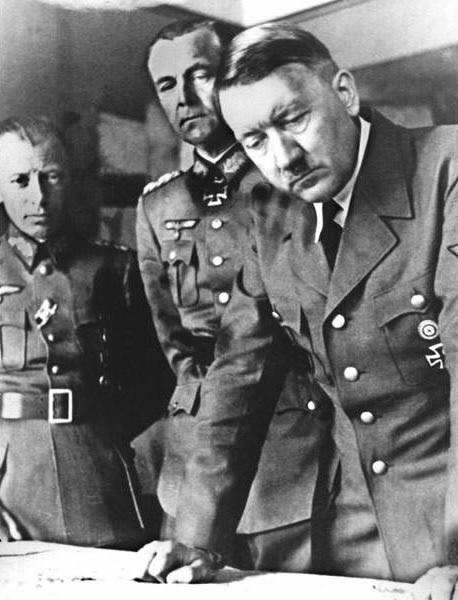
Adolf Hitler during the plannnig of Operation Barbarossa. To his left, Generalleutnat Friedrich Paulus, who was given command of 6. Armee in 1942 which was annihilated in Stalingrad Source: Public domain
Setting up marching orders
As the frame work of Operation Barbarossa was now known, drafting of the marching orders could begin. Heeresgruppe Mitte would be commanded by Generalfeldmarschall Fedor von Bock and was allocated the better part of the armored forces. In the frontline north of the Pripjat marshes, this army group was tasked with the destruction of the Soviet forces in Belorussia. A possibility should be left open to have strong mobile units swing north in order to support Heeresgruppe Nord in its operations. This unit, commanded by Generalfeldmarschall Wilhelm Ritter von Leeb was, on paper, the poorest equipped of the three army groups. It was tasked with trampling the Baltic states of Estonia, Latvia and Lithuania annexed by the Soviet Union, capturing the Soviet naval bases in the area and subsequently push through to Kronstadt and Leningrad.
South of the Pripjat marshes Heeresgruppe Süd, commanded by Generalfeldmarschall Gerd von Rundstedt, was to penetrate the vast Ukraine. This unit was to advance from southern Poland as well as from Rumania. Von Rundstedt was to destroy the Soviet formations in the west of the Ukraine and Galicia and subsequently establish bridgeheads on the eastern banks of the Dniepr and finally advance on Kiev or Rostov.
The role of the allies
In the meantime, Rumania had practically become a German military satellite. While Hitler himself was winning over the Rumanian dictator Marshall Ion Antonescu, a Luftwaffe contingent saw to the defense of the oilfields at Ploesti. A military mission coordinated the reform of the Rumanian army and was setting up plans for a German-led attack by the Rumanians on the Soviet Union.
The Finns held a special place. In the late summer of 1940, they were questioned about a German-Finnish cooperation. Soon after, they joined Germany, not in a real alliance but in a Waffenbruderschaft (brothers in arms). German troops advanced into Finland and the main body of the Finnish army was ordered to cooperate with Heeresgruppe Nord in the attack against Leningrad.
It is extremely odd that the Italians were not involved in the planning of Operation Barbarossa at all. Just one day before the launch of the operation, Fascist dictator Benito Mussolini was informed about the German plans to attack the Soviet Union in a letter written by Hitler himself. The Japanese didn't know about Hitler’s plans either. The Three-Power-Pact was considered a military pact only when it suited Hitler. In April, even a neutrality agreement was signed between the Soviet Union and Japan. An agreement that would have far reaching consequences for Soviet strategy.
On March 17, 1941, Hitler decided Hungary wouldn't be involved in Operation Barbarossa and Slovakia would only be used as a supply base and assembly area. In February German troops had already been given permission for a free passage through Bulgaria; its location being of more importance for the attack on Greece however than for the campaign against the Soviet Union.
More changes in the plan of attack
After December 1940 the German plan of attack was altered in only two ways. German troops were stationed in the extreme north of occupied Norway (AOK Norwegen) in order to launch an attack on Petsamo and subsequently advance on Murmansk in cooperation with the Finns. In this way, Hitler hoped to be one step ahead of possible British amphibious landings and eventually quell them in the bud. This military action was named Silberfuchs
The other change of the plan involved the southern sector. Hitler felt uneasy about a possible British intervention in Greece, causing him to order the relocation of troops of Heeresgruppe Süd to Bulgaria. This robbed Generalfeldmarschall Gerd von Rundstedt of a considerable part of his forces and so he had to abstain from the intended double pincer movement in the Ukraine. On March 17, 1941, Hitler decided that the army group should concentrate its major attack on the left flank of the area of operation. Hitler expected a straight advance towards Kiev out of southern Poland from Heeresgruppe Süd. In the initial stages, 11 Armee on the right flank was to secure the safety of the Rumanian oilfields. After the capture of Kiev, the left flank, (6 Armee and Panzergruppe 1) was to push through to the Black Sea. These changes in the plans were to have decisive consequences for the progress of Operation Barbarossa.
Events on the Balkans
On March 25, 1941, the Yugoslav pro-German government had signed the Three-Power-Pact and in so doing had joined the Axis powers. One day later however, a coup was staged by Serbian officers. Hitler was furious and on March 27, in Führer directive Nr. 26, he ordered the capture of Yugoslavia. The Serbian people had a long standing and good relationship with Russia and consequently on April 5, a non-aggression pact was signed between the new Yugoslav government and the Soviet Union. One day later, Belgrade was bombed by the Luftwaffe in Operation Bestrafung and German troops invaded both Yugoslavia and Greece.
The Wehrmacht having to take unexpected action in Yugoslavia caused Hitler to postpone Operation Barbarossa. After the end of operations in the southeast, it would take four to six weeks before the campaign against the Soviet Union could begin. It is an open question however whether the attack against Russia could have been launched earlier because of the extremely heavy rainfall in the spring of 1941, making the Russian roads impassable and crossing the rivers would have caused serious problems as they had swollen to well beyond their banks.
After the capture of the Balkans, the German formations which were to take part in the conquest of the Soviet Union returned to their original jump-off points on the Russian border. On June 5, Hitler approved the new time table. Operation Barbarossa was to be launched on June 22, 1941 at 03:15 hours.
Definitielijst
- Armee
- German unit. Mostly consisted of three to six army corps and other subordinate or independent units. An Armee was subject to a Heeresgruppe or Armeegruppe and had in theory 60,000-100,000 men.
- cavalry
- Originally the designation for mounted troops. During World War 2 the term was used for armoured units. Main tasks are reconnaissance, attack and support of infantry.
- Four Year Plan
- A German economic plan focussing at all sectors of the economy whereby established production goals had to be achieved in four years time.
- Führer
- German word for leader. During his reign of power Adolf Hitler was Führer of Nazi Germany.
- Heer
- German army or land forces. Part of Wehrmacht together with “Kriegsmarine” and “Luftwaffe”.
- Heeresgruppe
- The largest German ground formation and was directly subordinate to the OKH. Mainly consisting of a number of “Armeen” with few directly subordinate other units. A Heeresgruppe operated in a large area and could number several 100,000 men.
- infantry
- Foot soldiers of a given army.
- invasion
- Armed incursion.
- Luftwaffe
- German air force.
- Nazi
- Abbreviation of a national socialist.
- neutrality
- Impartiality, absence of decided views, the state of not supporting or helping either side in a conflict.
- non-aggression pact
- Agreement wherein parties pledge not to attack each other.
- offensive
- Attack on a smaller or larger scale.
- OKH
- “Oberkommando des Heeres”. German supreme command of the army.
- OKW
- “Oberkommando der Wehrmacht”. German supreme command of the Armed Forces, Army, Air Force and Navy.
- Red Army
- Army of the Soviet Union.
- resistance
- Resistance against the enemy. Often also with armed resources.
- Soviet Union
- Soviet Russia, alternative name for the USSR.
- strategy
- Art of warfare, the way in which war should be conducted in general.
- Wehrmacht
- German armed military forces, divided in ground forces, air force and navy.
The Wehrmacht in 1941
During the campaigns in Poland in 1939 and France and the Low Countries in 1940, the Germans had proved to possess one of the best war machines in the world. The Wehrmacht had inflicted a massive defeat on the Western Allies in lightning campaigns. Poland was defeated in a month and France fell within six weeks. Therefore the morale of the German soldier was higher than ever. In the spring of 1941, the German forces, in the campaigns against Yugoslavia and Greece, had proved once again they could defeat almost any opponent.
The decisive factors in the German victories had been supremacy in the air over the battlefield and the flexibility of the armored forces. In the campaign against the Soviet Union, the entire German strategy hinged on the speed of the tanks once again.
The armored forces
For an efficient execution of Operation Barbarossa however, the Germans needed more tanks than were available in the summer of 1940. On September 10, Hitler personally ordered a reorganization of the armored divisions and the number was doubled. This however at the cost of the numerical strength. The Panzerdivision of 1941 consisted of just one regiment of two battalions, although six divisions consisted of three. The tank battalions consisted of two companies of light and one company of medium tanks, while the infantry brigade in each tank division consisted of two motorized regiments, a battalion motorbikes, three medium artillery battalions and a battalion anti-aircraft guns equipped with the excellent 88mm weapon. Hence each tank division was made up of between 150 and 200 tanks which was half the numerical strength of the original tank division. All told, there were 46 tank battalions for the 20 tank divisions of the German army. For Operation Barbarossa no less than 19 of the 20 tank divisions were being deployed.
On June 22, the Germans had some 3,750 tanks at their disposal. The majority consisted of the PzKpfw III and PzKpfw IV (Panzerkampfwagen). During the campaigns in France and the Low Countries, these tanks had proved they met the demands of modern warfare. There was however a high number of obsolete light tanks in use, such as the PzKpfw I, PzKpfw II and the original Czech PzKpfw (35)t and the PzKpfw (38)t. These old models had turned out to be extremely vulnerable to enemy anti-tank fire during previous German campaigns and were in urgent need of replacement. Due to shortage of tanks however, the Germans were compelled to deploy these light tanks once more. More disturbing for the Germans was the fact that the production numbers of the PzKpfw III and PzKpfw IV were far below the number required. In the course of the campaign, this would cause problems for the Wehrmacht as Soviet production numbers were considerably higher. The German high command was very aware of this, notwithstanding Hitler’s disregard of reports about a massive Soviet strength in tanks. Moreover, it was assumed the Red Army possessed a new type of tank, even heavier than the PzKpfw IV. Despite these problems, the German army put its faith in the technical superiority of its equipment and the capabilities of its tank commanders.
The infantry
In contrast to what is often assumed, during World War Two the German army was for from an entirely motorized force. As the country had an acute shortage of motorized vehicles, only a limited number of formations was fully motorized. The better part of these formations was allocated to the armored forces, although for Operation Barbarossa the Germans had 15 motorized infantry divisions at their disposal. These divisions, thanks to their speed and flexibility, were able to gain successes at the forefront and in occupied areas and to consolidate junctions in the rear of the enemy. A serious disadvantage however was that these divisions were for a part equipped with French trucks, captured in 1940 which were not so well suited to the harsh conditions in the Soviet Union as their counterparts produced in Germany.
Part of the motorized divisions belonged to the Waffen-SS. These divisions, the SS-Leibstandarte, SS-Das Reich, SS-Totenkopf and SS-Wiking were part of the order of battle of the Wehrmacht in 1941. In previous campaigns, the Waffen-SS had proved itself equal to the regular troops. Although the average losses of these SS units were considerably higher than in other units, the Waffen-SS had displayed exceptional courage and endurance and in Yugoslavia and Greece, they had even claimed the leading role.
The majority of the infantry formations wasn't motorized however and they had to cover the immeasurable distances in the Soviet Union on foot. Moving supplies and artillery pieces was largely done by horses. Prior to the launch of Operation Barbarossa, the German army had 600,000 horses at its disposal. After Hitler had decided to attack the Soviet Union, the number of infantry divisions was increased. All told, for the campaign against Russia, Germany had 119 infantry divisions at her disposal. Earlier campaigns had already indicated that the enemy could often escape from an encirclement created by the tanks if the infantry couldn't reach them in time to shut the trap. As highly successful as the armored forces could be, success of the German advance still depended on the speed with which the infantry could advance.
The fighting in France had shown that that German infantry had serious trouble in the defense against enemy tanks. The 3,7cm anti-tank piece appeared not to be powerful enough to disable a reasonably armored tank. After the campaign in France it was decided to replace the 3,7cm gun with a more powerful 5cm one. In June 1941 however, the majority of the German infantry divisions was still equipped with the 3,7cm gun.
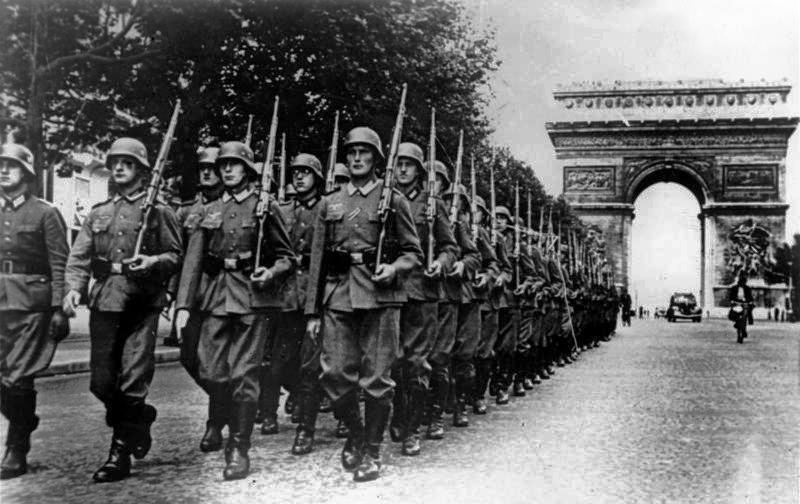
The glorious Wehrmacht marching through Paris in the summer of 1940 Source: Bundesarchiv, Bild 146-1994-036-09A/CC-BY-SA
The Brandenburger units were tasked with special operations in the rear of the Soviets. These highly trained commandoes were to create confusion and chaos in Soviet communications or secure special tactical objects like bridges and road junctions. These commandoes infiltrated in the Soviet lines in the night prior to the invasion or were parachuted behind enemy lines. Moreover, in the months prior to Operation Barbarossa, the German secret service recruited Ukrainian nationalists who were also tasked with actions of sabotage, the Nachtigal Regiments). In the Baltic states, where the Soviet regime had only recently been established, the German secret service also made contact with resistance groups who were willing to cooperate with the German plans to disrupt the Soviet rear.
The Luftwaffe
In the previous campaigns the German Luftwaffe had played a major part in the battles. In Operation Barbarossa 2,770 aircraft (65% of the total number at the disposal of the Luftwaffe) were allocated to gain air supremacy and destroy the Red Air Force. Moreover, the Luftwaffe played an indispensable role in support of the German ground forces.
The Luftwaffe’s standard fighter was the Messerschmitt Bf 109. This was a formidable fighter. Although the Germans had a superb fighter at its disposal, other German aircraft were outdated. The notorious Junkers Ju 87 depended on air supremacy in order to survive while the Heinkel He 111, Dornier Do 17 and the Junkers 88, Germany’s most important bombers, were all short on payload and range.
During the Battle of Britain, the Luftwaffe had suffered painful losses and the German aircraft industry hadn't compensated those yet. In June 1941, the Luftwaffe was short of 200 aircraft as compared to the previous year. Consequently, these shortcomings and the need to operate from improvised air fields made it extremely difficult for the pilots to achieve supremacy, also because the air space over the Soviet Union was so vast. In the thirties, the Luftwaffe had been established as a tactical air force which was more than able to provide short range ground support but due to the total lack of long range bombers it was unable to stage an effective campaign against far off enemy targets.
The Kriegsmarine played a supporting role in Operation Barbarossa. It was tasked with mine laying in Russian territorial waters, establish blockades and played a major part in support of the artillery of Heeresgruppe Nord in attacks against Soviet ground forces in the Baltic.
Rumanian troops
Germany’s most important ally was Rumania, headed by dictator Marshall Ion Antonescu who was also Commander-in-Chief of the Rumanian armed forces. From October 1941 onwards, a German delegation had assisted in restructuring the Rumanian army. Despite efforts to increase the striking power of the Rumanians, they army lagged far behind the German troops where fighting quality was concerned. The Rumanian army participated in Operation Barbarossa by deploying 358,140 men, divided into two armies. Those two, the Third and Forth Army together with the German 11. Armee made up Heeresgruppe Antonescu.
In accordance with the agreement with Finland, German troops were stationed in the north who, in collaboration with the Finnish army commanded by Field Marshall Carl Mannerheim, would launch operations to regain the territory lost in the Winter War of 1939-1940. In the extreme north of Norway and Finland, troops had been stationed to launch an attack on Murmansk. This would also be a combined German-Finnish operation. All told, the Finns deployed 302,600 men to undertake offensive operations against the Red Army.
Vernichtungskrieg
Adolf Hitler had already indicated in a speech to his generals on March 30. 1941, that Operation Barbarossa was to become a war of annihilation. The responsibility of the army was limited to the area of operation. Hence the military had to determine the limits of their consciousness ….. or ignore them. In the notorious Kommissarbefehl of June 6, 1941, this policy was emphasized once more. Communist Kommissars and authorities, whether civil or military, were outlawed entirely. They were to be sentenced to death on the spot without any sort of trial. Early March 1941, Hitler had already ruled that courts marshal would only handle military cases. As soon as they were captured, Kommissars were to be executed immediately. If German fighting forces hadn't already done so, the murder squads would see to it.
These squads, better known as Einsatzgruppen had been established in 1941 by Reinhard Heydrich, Heinrich Himmler’s right-hand man. To each army group, one murder brigade was allocated. Although they operated independently from the army and were only answerable to Heinrich Himmler, they actually collaborated closely with the command of the army, which was responsible for instance for their transport and care. The main task of these Einsatzgruppen was to exterminate the Jewish population in the captured areas of the Soviet Union.
Logistical problems
Germany’s main weakness was logistics. In the vastness of the Soviet Union there were hardly any paved roads and the Russian track gauge differed from that in Germany. Hence, the Wehrmacht depended on captured Russian rail equipment for its supplies. Moreover, the diversity of German weaponry required a large maintenance and repair system. In the planning of Operation Barbarossa, this had hardly been taken into account.
Perhaps Germany’s most serious mistake was that she hadn't adapted its economy at all to the circumstances of war. Shortages of raw materials and fuel formed a serious disadvantage for German industry. In June 1941, German industrial economy had come to depend on 3 million foreign forced laborers and due to mandatory conscription, these shortages only increased. Just like in previous operations, Hitler reckoned on a lightning victory and so, an eventual prolongation of the war during the winter wasn't taken into account at all. It would be and had to be a swift victory, otherwise the Third Reich would soon be facing serious problems.
Definitielijst
- brigade
- Consisted mostly of two or more regiments. Could operate independently or as part of a division. Sometimes they were part of a corps instead of a division. In theory a brigade consisted of 5,000 to 7,000 men.
- collaboration
- Cooperation of the people with the occupying forces, more generally spoken the term for individuals who cooperate with the occupying force is collaborator.
- Heeresgruppe
- The largest German ground formation and was directly subordinate to the OKH. Mainly consisting of a number of “Armeen” with few directly subordinate other units. A Heeresgruppe operated in a large area and could number several 100,000 men.
- infantry
- Foot soldiers of a given army.
- invasion
- Armed incursion.
- Kriegsmarine
- Germa navy. Part of the Wehrmacht next to Heer and Luftwaffe.
- Leibstandarte
- Elite troops, originally Hitler’s body guards. Starting as a motorized infantry regiment it grew into a Panzer division.
- Luftwaffe
- German air force.
- marshal
- Highest military rank, Army commander.
- mine
- An object filled with explosives, equipped with detonator which is activated by either remote control or by colliding with the targeted object. Mines are intended to destroy of damage vehicles, aircrafts or vessels, or to injure, kill or otherwise putting staff out of action. It is also possible to deny enemy access of a specific area by laying mines.
- offensive
- Attack on a smaller or larger scale.
- Red Army
- Army of the Soviet Union.
- regiment
- Part of a division. A division divided into a number of regiments. In the army traditionally the name of the major organised unit of one type of weapon.
- resistance
- Resistance against the enemy. Often also with armed resources.
- Soviet Union
- Soviet Russia, alternative name for the USSR.
- strategy
- Art of warfare, the way in which war should be conducted in general.
- Totenkopf
- “Death’s head”. Symbol that was used by the SS. Also the name of an SS Division.
- Waffen-SS
- Name of Military section of the SS.
- Wehrmacht
- German armed military forces, divided in ground forces, air force and navy.
The Red Army in 1941
Facing the best army in the world was a force that in 23 years had gained stormy and turbulent organizational, theoretical and operational experiences. During the first stages of the Russian revolution, and the subsequent civil war, the Bolshevist leadership needed armed forces to defend its seizure of power. Based on voluntary participation and other willing defenders of the regime, the Red Army of Workers and Farmers was formed (RKKA: Raboche Krestyanskaya Krasnaya Armia) in short, the Red Army
In order to have a sufficient number of men at his disposal, Lenin decided to introduce conscription. The Red Army grew into an army with 5 million men but owing to the prevalent war weariness and the strong prejudices against discipline and the orthodox military organization, desertion was wide spread, causing units to be disbanded and reestablished, depending on the mood of the local farmer-soldiers.
Irregular band of thugs
In general, the Red Army looked more like an irregular band of thugs that was kept together somehow by political commissars. A professional staff in Moscow, consisting of former Czarist officers, was in command of this army.
The Civil War was one of mobility in which the cavalry of both sides penetrated deep into territory occupied by the enemy in order to stage raids and cause confusion in the rear of the enemy. The poorly equipped infantry saw to the clearing of resistance nests. Eventually, the Red Army managed to gain the upper hand, causing the Communist regime to retain its seat in Moscow.
Following the Civil War, the Red Army was partially disbanded and reorganized. The major units were deployed along the borders and in densely populated areas while large cavalry formations were kept in reserve to stage offensive operations. It was the era of the semi-educated ‘red commander’, the ex-guerilla warrior who pulled the strings. The real military specialists, generally without a proletarian background, played an insignificant role. This situation was changed by the publications of M.V. Frunze, a successful army commander from the Civil War. He developed an entirely new way of military thinking which was to have a profound influence on the doctrine of the Red Army. The main characteristics of his thinking were to enforce world revolution by offensive operation and ideological education. Frunze also made an important contribution to the actual modernization of the Soviet armed forces. The authority of the political Kommissars in operational command was severely limited, thanks to Frunze.
Secret agreement with Germany
After the First World War, limitations were imposed on Germany by the Treaty of Versailles, drafted by the Western Allies. Development and production of certain types of weapons were prohibited. As Germany as well as the Soviet Union had reached an isolated position internationally, on April 16, 1922 in Rapallo, Italy, a political treaty was signed in which Germany recognized the Soviets as the official government of the Soviet Union. In secret though, economic and military agreements had been signed as well. German armaments factories were built in the Soviet Union and moreover, training facilities were set up by officers of the Reichswehr. In exchange, Soviet military were given the opportunity to take technical and tactical courses.
Although M.V. Frunze passed away in 1925, a new generation military intellectuals developed his ideas into useful strategies. Inspired by the lessons they had learned from German officers, solutions were sought to prevent trench warfare like during the First World War. The Soviets also used the lessons they had learned in the Civil War as to exploiting a breakthrough by cavalry formations. The final solution was found in the establishment of mechanized and motorized formations. In this context, people like Svechin and Triandafilov worked out a strategy which became known as the ‘in-depth attack’Gluboki Boy. In this theory, a victory should be achieved in a combined deployment of infantry, cavalry, tanks and aircraft. Tukhachevsky, one of the most influential red commanders saw to it that these revolutionary doctrines would be adopted by the Red Army and submitted requests to Stalin for the necessary weapons.
The Five Year Plans
Joseph V. Stalin introduced the Five Year Plans which were to provide the future units with these weapons. The Red Army however hardly had any experience in the production of tanks. A license was bought from Great Britain to produce the Vickers tank in the Soviet Union, which was developed further and later on produced as the T-26. The Soviet Union bought the Christie tank in the United States which would be developed further into the BT-2 and later into the BT-5 and BT-7
In 1930, the first tank brigade was established and in 1932, this number had increased to 4. Because of the increased production of tanks, in 1936, the Soviets were able to establish no less than 4 mechanized corps. Moreover in 1936, there was an abundance of mechanized brigades, tank regiments and tank battalions. In that year a mechanized corps was made up of over 560 tanks and 12,700 men. Cavalry corps and cavalry divisions were kept in reserve but these units were expanded with tank formations.
The Soviets were also the first to acknowledge the advantage of the deployment of air borne troops on a large scale. Experiments with those forces began during the thirties. It was decided to introduce the use of air landings in the rear of the enemy in Soviet military doctrine. After the army high command had been convinced of the benefit of air landings, establishment of air landing brigades was started that were even expanded to full size corps in the early fourties.
Halfway through the thirties, the Red Army yearly held large military maneuvers in the summer. Western observers were deeply impressed by what the Red Army displayed during these large-scale military exercises. In 1934, personal ranks were introduced and the authority of the political Kommissars was limited further. Moreover, a new general staff was appointed with the necessary training facilities. It may well be said that the unorganized band of thugs from the twenties had come of age which halfway through the thirties had grown into one of the most progressive armies in the world.
Experiments in Spain
In 1936, the Civil War broke out in Spain and Germany and Italy supported the Nationalists led by Franco in their struggle against the Republicans by delivering weapons and troops. Stalin thereupon decided to support the Republicans and dispatched aircraft, tanks and ‘advisors’ to Spain. During the fighting near Guadalajara a Soviet unit of tanks, commanded by Dimitri G. Pavlov, defeated two Italian motorized divisions. From this Pavlov drew the conclusion that the French way of using tanks in direct support of the infantry was the best way and that the Soviet theories about motorized units were flawed. On his return to the Soviet Union, he presented his ideas to the People’s Kommissar of Defense, Kliment E. Voroshilov who wasn't convinced anyway of the progressive ideas within the intellectual top of the Red Army. In accordance with the experiences in Spain, the mechanized formations were disbanded and the tanks distributed among the infantry formations and separately divided into small scale tank brigades which hardly had supporting units at their disposal.
Cleansing of the officers’ corps
At that time, the armed forces were struck by Stalin’s cleansing. Few events had more influence on the Red Army in 1941 than this systematic destruction of the high command that Stalin implemented between 1937 and 1939. Stalin’s motives for cleansing the army were first and foremost to secure his position as absolute ruler of the Soviet Union. As the army had weapons at its disposal and, moreover, there were leaders who owed their position, authority or prestige to Stalin, those leaders had to be eliminated just like it had happened in the Party. Three out of the five marshals, among them Tukhachevsky, 11 delegated Commissioners of Defense, 13 out of the 15 army commanders and all military leaders of districts in May 1937, as well as the most prominent members of the staffs of navy and air forces were executed in this period or vanished without a trace. The political apparatus, which was supposed to advice the career military, met the same fate. A total of 54,714 officers were ousted of which 15,000 were executed or disappeared forever. The rest was sentenced to long terms in prisons or labor camps. At the same time, some of the progressive ideas about the way to wage a war went down the drain. In fact, the Red Army was robbed of its brains.
Part of the military doctrine was retained but few officers were left over who could implement the revolutionary tactics. The officers ousted were replaced by politically dependable but inexperienced and mostly incapable commanders. This had grave consequences for the organization, coordination and the efficiency of the Soviet armed forces. Fear of the Stalinist regime prevented the remaining and newly appointed commanders from taking the initiative. In order to tighten his grip on the Red Army, Stalin had reinstated the authority of the Kommissars. Any order given by an officer had to be approved by them.
Experiences in the Far East, Poland and Finland
Since the early thirties, the Red Army had deployed a well-trained force on the eastern borders of the Soviet Union because of the threats by the Japanese. In 1938 and 1939, large scale border fights had raged between Siberian Soviet soldiers and the Kwantung Army. As Moscow had less influence on the command in the Far East, corps commander Gheorghy K. Zhukov, managed to defeat the Japanese with his troops in a combined deployment of tanks, infantry, artillery and fighter aircraft.
In the west, the Red Army swung into action as well in September 1939. Although Poland had been as good as defeated by the Germans, on September 17, the Red Army demanded its share of the Polish territory. This had been agreed upon in secret additional protocols in the Molotov-Von Ribbentrop Pact, signed on August 23 the same year. During the capture of eastern Poland serious problems became evident in the motorized units. Two tank corps participated in the advance to the west. These however were continuously held up by mechanical and logistic problems.
In December 1939, a conflict with Finland erupted, known as the Winter War. The achievements of the Red Army during the first month of the conflict didn't meet expectations and disastrous losses were suffered, without the pre-selected goals being achieved. The performance of the armored formations was poor. Many vehicles were lost to mechanical failure and logistics fell far short as well. Hence, armored formations were mainly deployed in support of the infantry.
Reforms
Regarding the German successes in Poland and Norway and the poor performance of the Red Army in Finland, a massive reorganization was put into motion in May 1940. First, changes in the overall command were made to the highest ranks of the military apparatus. The incompetent Marshal Kliment E. Voroshilov, People’s Commissioner of Defense, was replaced by Marshal Semyon K. Timoshenko and the chief of the general staff, Marshal Boris M. Shaposhnikov was replaced by Colonel-general Kiril A. Meretskov. Timoshenko sharpened discipline by imposing severe penalties for relatively minor violations. The rank of general, habitual in the Czar era, was reinstated and some of the ousted officers were rehabilitated, the best example being the release of the later Marshal Konstantin K. Rokossovsky. In June, some 1,000 officers were promoted. As a result, an officer generally held a position which was two ranks higher than what he had been trained for.
After the German victories in western Europe and the growing tension with the Nazis, it became clear in the Soviet Union that something had to be done in case a German invasion had to be repulsed. Hence it was decided towards the end of 1940 to reinstate the mechanized corps. Those corps however were larger than those in the thirties. In theory, in 1941 a mechanized corps consisted of had 1,031 tanks and 36,080 men. Yet these corps were hardly comparable as to organization and structure to the flexible yet complicated German armored formations.
Marshal Semyon K. Timoshenko worked out plans for an expansion of the Red Army which was to be completed in 1942. The outdated tanks were to be replaced by models which met the requirements of the modern battlefield. These new vehicles were to be allocated to no less than 29 mechanized corps. These were build up around the cadres of existing infantry formations and would be temporarily equipped with the newer models of the T-34 and the KV-1. In order to guarantee mobility of the motorized infantry formations, belonging to the mechanized corps, trucks and tractors were taken away from the artillery formations of the regular divisions. The major problem of the motorized units of the Red Army was the lack of communication. Men were poorly trained (military vehicles were secret so training had hardly been begun) and only a few vehicles were equipped with communication equipment. Sending messages was still done with signal flags.
Infantry formations
As early as 1939, a massive expansion of the Red Army was put in motion, owing to the increasing international tensions. Although the emphasis in mobile warfare lies on the mechanized formations, yet the majority of the Red Army still consisted of infantry units, in 1939, some 65% of the total of ground forces. Due to Stalin’s cleansing, far too few officers were left over who could train and lead them in a professional way.
On August 16, 1940, it was decided to revise the existing plans for mobilization. A special commission was installed, chaired by Alexandr M. Vasilevsky, member of the general staff. The new plans became known by the name of MP-41 (Mobilization Plan 41) and would continuously be adapted in the course of 1941. MP-41 entailed a secret process of mobilization where a limited number of reservists were drafted under the guise of training maneuvers which was put in motion in 1941, far too late. When German troops invaded the Soviet Union on June 22, the Red Army had only 2,901,000 men under arms in the western military districts.
On paper a Soviet division was almost equal to a German infantry division with a total of 4,483 men, split into three regiments of three battalions, two artillery regimens, a battalion of light tanks and supporting units. In 1941 however, the Fuselier divisions were highly undermanned and generally consisted of less than 8,000 men under arms. As in May 1941, 800,000 reservists were called upon, the divisions were supplemented piece-meal but these reservists lacked experience. In June 1941, a Soviet army consisted of three Fuselier corps, each of them made up of two to three Fuselier divisions. In fact, a Soviet army in 1941 consisted of only six to ten divisions, supported by an undermanned mechanized corps and with a huge shortage of supporting and communication units.
Additional ground forces
The Soviet forces facing the Germans in 1941 were not only made up of regular army units. On the borders, special units of the Russian security service, NKVD Narodniy Kommissariat Vnutrennikh Del were deployed; lightly armed forces mainly tasked with border protection, comparable to the modern customs. These units were directly answerable to Moscow and the commanders of districts and the army were kept out of this structure. The Soviets also had a special unit within the armed forces, the POV Strany Voiska Protivovozduchnoi Oboroni. It was responsible for the manning the anti-aircraft defense around the cities and strategically important targets like airports. It even had its own air force at its disposal.
The Red Air Force
In June 1941, the Soviet Air Force RKKVF, Raboche Krestyanskaya Krasnaya Armia was the largest air force in the world in terms of numbers, 19,533 aircraft of which 7,133 aircraft were based in the western military districts. The majority of the planes however was hopelessly outdated and the cleansing of the officers’ corps had also had disastrous consequences for the Red Air Force. Talented and progressive designers had also been cleansed by order of Stalin.
The better part of the Soviet fighters consisted of the Polikarpov I-16 which was no match at all for its German opponent, the Messerschmitt Bf 109. In June 1941, biplanes like the Polikarpov I-15, I 152 and I-153 were still in service in the Red Air Force. Along with the decision to renew the equipment of the Red Army, large scale reforms were also put in motion in the Red Air Force.
At the end of the thirties, Russian designers had started developing modern monoplanes like the Mikoyan-Gurevich MiG 1 which would ultimately evolve into the Mig-3. In the spring of 1941 the Lavochkin LaGG- and the Lavochkin LaGG-3, made entirely of wood, began entering the squadrons. The Yakovlev Yak-1 and the Yak-3 were also distributed in small numbers among the Soviet fighter regiments. Production of new aircraft progressed slowly however and there was a shortage of pilots to fly these new aircraft.
The bombers of the Red Air Force were hopelessly outdated as well; the most aircraft in service were the Tupolev SB-2, the Sukhoi SU-2 and the Ilyushin Il-4 (DB-3F). In 1940, production of the new and improved types which would distinguish themselves later in the war, like the Petlyakov PE-2 and the formidable Ilyushin Il-2 Shturmovik, progressed slowly however. Hence, in June 1940 only a few of these aircraft were available. The bomber squadrons also severely lacked trained crews to fly these new planes. Moreover, the majority of the aircraft was not even equipped with radio.
Due to the expansion of territory to the west, new airfields were to be constructed. In June 1941, only a few air bases were fully operational. The majority of the aircraft was still parked in the open air as there were too few hangars to hide the planes from the spying eyes of the Luftwaffe and protect them from the weather. The air bases also suffered from a huge shortage of anti-aircraft guns.
Command of the Red Air Force was very confusing as well. Some air divisions were tasked with supporting ground forces (armies and fronts), others were directly commanded by the general staffs while still others were allocated to a command structure of regional air defense (PVO). The Red Air Force lacked a coordinated command structure which made it difficult to realize a combined deployment of air and ground forces. Moreover the existing tactics were hopelessly outdated.
The Red Navy
The Red Navy ( RKKF= Raboche Krestyanskaya Krasnaya Flot ) had also suffered heavily from the cleansing in its command. Just like the ground forces, the Red Navy embarked on large scale reorganizations in 1940. The traditional ranks from the Czarist era, those of admiral and vice-admiral, were reinstated.
The Red Navy was responsible for the defense of the Baltic Coast (the Baltic Fleet based in Kronstadt), the coast in the extreme north (the Northern Fleet based in Murmansk) and the Black Sea Fleet, based in Sevastopol responsible for the defense of the Russian coast on the Black Sea. Due to the annexation of the Baltic states, the navy gained a number of new bases which improved her position, strategically speaking, to take on the Kriegsmarine in the Baltic in the event of war. It was compelled however to develop a defensive strategy in case of a war with Germany. The better part of the production facilities was allocated to the construction of submarines. The Red Navy, by the way, did have its own air and ground forces to defend its home bases and to undertake amphibious landings.
The Soviet Union was invaded on June 22, 1941 at a time when she was in fact at her weakest. The huge shortage of well-trained officers, the fear to deploy own initiatives which resulted from the cleansings, the halfhearted mobilization and the lack of modern means of communications contributed for a large part to the disastrous defeats suffered by the Red Army in the first year of the German-Russian war.
Definitielijst
- brigade
- Consisted mostly of two or more regiments. Could operate independently or as part of a division. Sometimes they were part of a corps instead of a division. In theory a brigade consisted of 5,000 to 7,000 men.
- cavalry
- Originally the designation for mounted troops. During World War 2 the term was used for armoured units. Main tasks are reconnaissance, attack and support of infantry.
- First World War
- Took place from 1914 till 1918 and is also named The Great War. The conflict started because of increased nationalism, militarism and neo-colonialism in Europe. Two alliances battled one another during the 4-year war, which after a dynamic start, resulted into static trench warfare. The belligerents were the Triple Alliance (consisting of Great-Britain, France, and Russia; later enlarged by Italy and the USA, amongst others) on the one hand and the Central Powers (consisting of Germany, Austria-Hungary, Bulgaria and the Ottoman empire) on the other hand. The war was characterized by the huge number of casualties and the use of many new weapons (flamethrowers, aircraft, poison gas, tanks). The war ended in 1918 when Germany and its allies surrendered unconditionally.
- Fuselier
- In World War 2 the name of an infantry man armed with a rifle in, among others, the Dutch and Belgian armies. The soldiers of the Dutch guards regiment “Prinses Irene” are still called fusiliers.
- infantry
- Foot soldiers of a given army.
- invasion
- Armed incursion.
- Kriegsmarine
- Germa navy. Part of the Wehrmacht next to Heer and Luftwaffe.
- Luftwaffe
- German air force.
- Marshal
- Highest military rank, Army commander.
- mobilization
- To make an army ready for war, actually the transition from a state of peace to a state of war. The Dutch army was mobilized on the 29 August 1939.
- offensive
- Attack on a smaller or larger scale.
- Red Army
- Army of the Soviet Union.
- Reichswehr
- German army during the Weimar republic.
- resistance
- Resistance against the enemy. Often also with armed resources.
- revolution
- Usually sudden and violent reversal of existing (political) the political set-up and situations.
- RKKA
- Official name of the Red Army, the army of the Soviet Union. In full “Rabotsje Krestjanskaja Krasnaja Armiya”, meaning Red Army of workers and peasants.
- RKKF
- Official name of the Red Fleet, the fleet of the Soviet Union. In full “Rabotsje Krestjanskaja” meaning Red Fleet of workers and peasants.
- RKKVF
- Official name of the Red Air force, the air force of the Soviet Union. In full “Rabotsje Krestjanskaja Vozdoesjny Flot”. Meaning, Red airfleet of workers and peasants.
- Soviet Union
- Soviet Russia, alternative name for the USSR.
- strategy
- Art of warfare, the way in which war should be conducted in general.
Soviet plans for defense
The Soviet plans for defense prior to the German invasion have been the subject of heated arguments and discussions for decades. Stalin had been informed about the imminent German invasion by dozens of sources and it is therefore hardly imaginable that the Red Army was overwhelmed as it was in the early stages of Operation Barbarossa. There was however more than one cause for the disaster that struck the Soviet Union in June 1941. This catastrophe was a confluence of events in which Stalin’s personal intervention played a significant role.
Just like German after the First World War, the Soviet Union found itself in an isolated position at international level. In Europe, there were few governments that had cordial and open diplomatic relations with the Soviets and as international tension was mounting halfway through the thirties, a start was made with the development of plans for defense and mobilization.
The first detailed plans for defense
As early as 1935, Marshal Mikhail N. Tukhachevsky recognized the danger of the threat emanating from Nazi Germany. One year later he proposed to the general staff to organize special war games to investigate what the situation would be in case of a German invasion. Tukhachevsky envisaged a joint invasion by Germany and Poland in which troops would be concentrated north of the Pripjat marshes in order to advance on Moscow via Smolensk. In hindsight, an alliance between Germany and Poland seems unlikely, given the fact that Germany and Poland had signed a non-aggression pact in 1934. Based on the results of the investigation, Tukhachevsky declared in early 1934: ‘Operations will inevitably be more intense and fiercer than during the First World War. At that time the fighting on the borders in France took just two days. Now, offensive operations in the first stages of a war may last for weeks. The Blitzkrieg the Germans continuously boast about in their propaganda, can only be expedient if the opponent lacks the will to strike back. Should the Germans meet an opponent who takes the initiative, the entire course of the situation will change.’
Based on these findings, Tukhachevsky developed a plan for defense in cooperation with the general staff. The first echelon should be deployed on the borders, the so-called shield. This first echelon should consist of so-called ‘fortified regions’ UR= Ukreplenny Raion , predominantly made up of infantry. These regions were tasked with absorbing, delaying and ultimately halting the enemy offensive. The second echelon, the ‘secret operational groups’ would be made up of a combination of mechanized corps and shock troops. The second echelon, designated the hammer by Tukhachevsky, was to launch a massive counter attack once the first echelon had delayed the enemy offensive, expel the enemy from Soviet territory in order to annihilate him on the other side of the border.
Based on this strategy, the Red Army was being prepared for war. Fortified regions were established on the western borders of the Soviet Union. This line of defense would become known as the Stalin line. However, six months after Marshal Tukhachevsky had drafted his plans for defense, he was executed along with his most prominent associates. This was the beginning of the wave of terror that would cripple the Red Army.
Dismantling the Stalin line
After the officers’ corps had been decimated and the tension in Europe was mounting, Hitler and Stalin signed a non-aggression pact, the notorious Molotov-Von Ribbentrop Pact. In a secret clause of the pact, Eastern-Europe was divided between the two totalitarian powers. With this pact, Joseph Stalin attempted to keep the Soviet Union out of the war and by annexing the Baltic states to create an additional buffer zone. The occupation of Eastern-Poland and the annexations in the Baltic meant that Germany and the Soviet Union shared a common border, actually making the Stalin line redundant. After the borders had been redrawn hundreds of miles to the west, the fortifications on the Stalin line were also dismantled and the Red Army took up defensive positions on the new borders. All this meant that the existing plans for defense had to be revised.
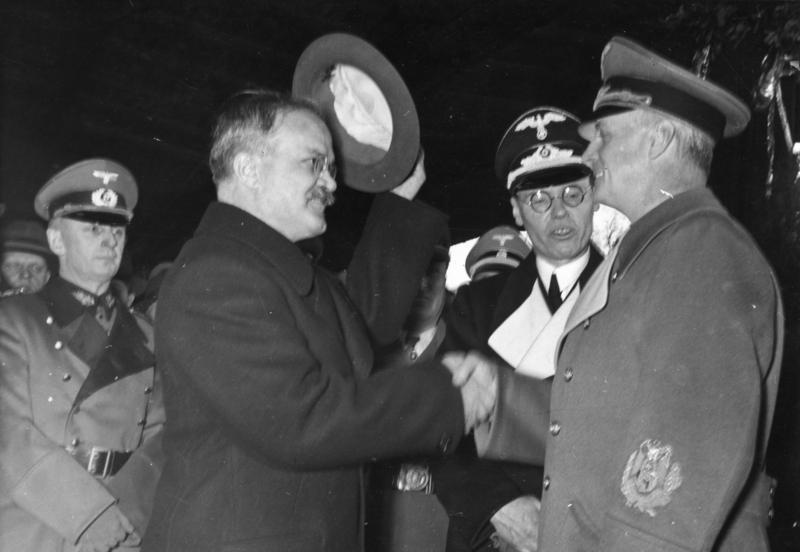
Von Ribbentrop bids goodby to Molotov after his visit to Berlin, November 14, 1940 Source: Bundesarchiv, Bild 183-1984-1206-523 / CC-BY-SA 3.0
Contrary to Stalin’s expectations, the Germans overwhelmed the Benelux and France in May and June 1940. The Soviets had seriously reckoned with the possibility that the war in the west would turn into a battle of attrition but instead, it ended in a lightning German victory. In July 1940, the general staff hastily started to revise the plans for defense, designating Germany as the most probable potential opponent. The staff named the region north of the Pripjat marshes as the most likely location were the Germans would concentrate their main force.
In the meantime, Stalin had to prevent the Soviet Union from entering into a conflict with Germany at all costs. On November 12, 1940, People’s Commissioner of Foreign Affairs, Vyacheslav M. Molotov paid a visit to Berlin to negotiate with Hitler and Von Ribbentrop. Molotov reacted reluctantly to a German proposal to sign an agreement between the Soviet Union and the members of the Axis powers. Molotov voiced Stalin’s concern about the German intervention on the Balkans and in Finland and demanded guarantees and concessions from the Germans. Moreover, Molotov asked for permission to establish naval bases in the region of the Bosporus and the Dardanelles, giving the Soviet Union control over the passage to the Black Sea. The negotiations proceeded awkwardly and Molotov eventually returned to Moscow empty-handed. These were the first clear indications that tensions between the two super powers were mounting.
Information about German plans
As early as January 1941, agents of the GRU, Glavnoye Razvedivatel' noye Upravlenye , the Soviet military intelligence service, were collecting information on Hitler’s intentions and German troop movements to the east. The NKVD also had its own department which occupied itself exclusively with gathering information, the GUGBEZ Glavnoye Upravlenye Gosudarstvennoi Bezopasnosti . This organization had established a vast network of spies in Nazi- occupied Poland and Czechoslovakia and was well aware of the German build-up of forces on the borders. But indications also flowed into Moscow from foreign countries as to Hitler’ s intention to attack the Soviet Union. From Washington, London and Stockholm Stalin was alerted to a German surprise attack in the coming spring.
Later that month, secret war games were held to test the existing defensive plans. The plan submitted to Stalin by the chief of the general staff, Kirill A. Meretskov, probably did not meet expectations and Meretskov was relieved of his function as he reckoned with a German attack north of the Pripjat marshes. He was replaced by the young, gifted but aggressive army commander Gheorghy K. Zhukov because Meretskov envisaged a German attack north of the Pripjat marshes. Just like Marshal Semyon K. Timoshenko and General Zhukov, Stalin was convinced that the main body of an eventual German invasion would be launched south of the Pripjat marshes. They assumed Hitler was targeting the rich grain fields and industrial areas in the Ukraine. This meant that Soviet strategy had to be revised entirely. Zhukov was given the task to work out the defensive plan and to coordinate the required troop movements.
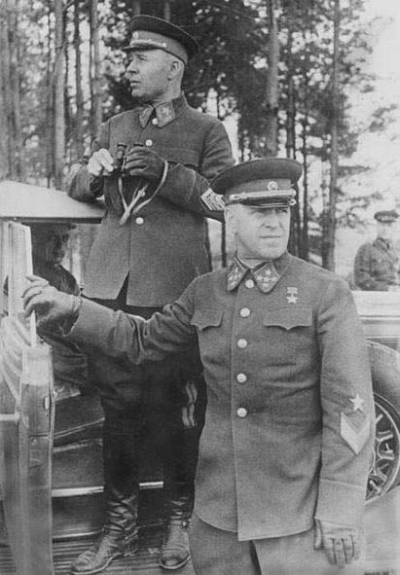
People’s Commissioner of Defense Marshal of the Soviet Union S.K. Timoschenko (left) and chief of the general staff General G.K. Zhukov Source: Public domain
State plan for defense 41
General Zhukov quickly went to work on State Defense Plan 41 (DP 41). He referred to the old and trusted defense plans of Marshal Tukhachevsky who had been executed. In the opinion of the new chief of staff, the all decisive fighting on the border should take 10 to 15 days. During these engagements, the Red Army should adopt a defensive tactic in order to subsequently launch a massive counter attack after which the battle should proceed west of the border. As Tukhachevsky had already proposed in the thirties, two echelons were established. The majority of the divisions should be deployed in the forward belt of defense, the shield, in particular in the Special Baltic Military District (Colonel-general Fyodor I. Kuznetsova), the Special Western Military District (Colonel-general Dimitry G. Pavlov), the Special Military District Kiev (Colonel-general Mikhail P. Kipronos) and the independent 9th Army (Lieutenant-general Cherevichenko). As soon as the war broke out, these would be renamed the Northwestern Front, the Western Front, the Southwestern Front and the Southern Front respectively. The first belt of defense should be deployed in three defensive lines along the new borders. The first defensive belt (in total 57 divisions) would consist of lightly armed infantry formations and NKVD border troops while the second belt (52 divisions) and the third belt (62 divisions) were made up of shock troops and mechanized corps to launch local counter attacks. The second strategic echelon (the hammer) would consist of 57 divisions, spread over five armies which were deployed along the banks of the Dnepr and the Dvina. It was tasked with launching the great counter offensive in collaboration with the second and third defensive belt of the first echelon. The German intelligence services were not aware of this second echelon though and once the Germans had penetrated in the hinterland of the Soviet Union, this turned out to be an unpleasant surprise.
Warnings once more against a German attack
Warnings about an imminent German invasion kept flowing into Moscow. It was even reported that the Germans would attack on May 15, 1940. These warnings resulted in stepped-up Soviet efforts to prevent a war. Various messages were sent to Berlin indicating that the Soviet Union would stick to the non-aggression pact. Stalin even used a non-aggression pact with Japan on April 13, 1941 to stress that friendship with Germany was guaranteed.
In May 1941, a growing number of messages was received in Moscow indicating that Hitler was steering towards war. Soviet agents in Germany confirmed the country’s military preparations but assured that a German invasion would be preceded by an ultimatum. This only caused Stalin to intensify his peace policy although on May 5, he delivered a speech in the Kremlin to officers, declaring a German attack in the near future could not be excluded. He indicated that the Soviet Union would do everything by diplomacy to have the Germans postpone their attack to the fall at least. If this would succeed, Stalin thought the war be fought almost surely in 1942 in much more favorable circumstances. That very day, intelligence services of the Red Army reported that 103 to 107 German divisions, among them 12 armored, were assembling on the border.
Although a non-aggression pact had been signed with Japan, Stalin wasn’t convinced that the Japanese wouldn't launch a simultaneous attack in the Far East. Despite the information from master spy Richard Sorge, Stalin expanded his forces in the Far East.
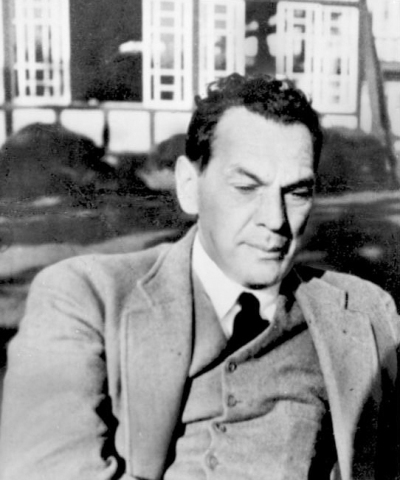
Master spy Richard Sorge repeatedly warned for the imminent German invasion Source: Bundesarchiv, Bild 183-1985-1003-020 / CC-BY-SA 3.0
General Zhukov’s plan
On May 15, nothing happened however and this only strengthened Stalin’s assumption that the British wanted to drag him into the war. Nonetheless, the moment of truth had come for the general staff. The same day, General Zhukov proposed to launch a pre-emptive strike with 152 Soviet divisions against the 100 German divisions assembling on the border. Stalin didn’t want any of it and when Zhukov subsequently requested to declare a general mobilization, Stalin didn’t agree either. This put the Red Army in an awkward position: it wasn't allowed to prepare for an offensive, nor a defensive strategy. Stalin strictly prohibited attacks by anti-aircraft guns and fighters against German reconnaissance aircraft.
On May 10, 1940, the Soviet dictator faced a new threat. Rudolph Hess, Hitler’s deputy flew to Scotland to negotiate with the Allies to divert the Soviets from the German threat and make Stalin believe the British were thinking of hatching a conspiracy against the Soviet Union. After this peculiar flight, Stalin took the earlier British warnings that Germany was to go to war against the Soviet Union for disinformation. Was the flight of Hess a signal of a German-British agreement to give Hitler a free hand in the East or was it the umpteenth effort by Great Britain to draw the Soviet Union into the war? The British, exploiting Hess’ flight to the full, only caused Stalin’s greatest fear to grow by this deliberately misleading information.
Partial mobilization
The political strategy to prevent war at all costs worked seriously to the detriment of the Soviet military preparations. The propaganda put the population at ease by saying there was no question of imminent war. This even misled the Red Army. As a result preparation for mobilization progressed only partially. Consequently the Soviet units were far below the required strength when the Germans invaded the Soviet Union. The undermanned formations lay far apart and there were numerous units that had to engage the Germans in battle without the necessary weapons and ammunition. In addition, the available vehicles had been sent to the border in order to expedite the completion of the fortified regions. This led to a shortage of transport means to move artillery pieces.
Early June 1941, the revised plans for mobilization were far from complete. Operational plans for the military districts hadn’t been worked out completely and no plans existed to bring all troops up to battle readiness. The plan of the general staff for the defense of the national borders entailed the deployment of troops but there were no complete operational plans. Moreover, in the organization of the defense a German surprise attack was not reckoned with. According to the intelligence services, a German attack would be preceded by a declaration of war and the initial attacks would be on a small scale, giving the Red Army time to mobilize. Stalin was well aware of the fact that the general mobilization of 1914 had triggered the war and he therefore banned total mobilization. So, MP 41 was partially set in motion as Stalin’ s only concession was he had called up 800,000 reservists for the annual summer maneuvers.
Silence before the storm
The Soviet diplomats stuck to their view that a new agreement with Berlin was possible, even in the near future. Stalin therefore insisted that the Soviet Union would strictly meet her economic obligations to Germany. Deliveries of raw materials to Germany were even accelerated. Berlin calculated it could make economic demands to the Soviet Union pursuant to the trade agreement of 1941. It was this issue that convinced many, including the British, that the German troop concentrations served to increase the pressure on the Soviet Union in order to obtain economic commitments. Moreover, Stalin was still firmly convinced Hitler would never make the mistake of waging a war on two fronts. Meanwhile, Berlin silently indicated that negotiations were still an option.
On June 14, 1941, Stalin had a communiqué published in the state paper Pravda. It said that the Soviet Union, just like Germany, would adhere to the non-aggression pact and that rumors about an intention to tear up the pact were unfounded as they came from ‘false friends.’ The recent German troops movements in the direction of the border after the operations on the Balkans had been completed, would have nothing to do with the German-Russian relations.
Stalin waited in vain for a reaction from Berlin. Hitler set the time for the German attack at B-Day, Y hours or June 22, 1941 at 03:15 hours. After June 18, troops had to move to their starting positions. Armored divisions would be directed to these positions by night. Distressed Soviet front commanders were very worried about the German build-up of troops on the borders and phoned Moscow, only to hear that there would be no war.
NKO Directive Nr. 1
Shortly before midnight on Saturday, June 21, the People’s Commissioner for Defense sent operational orders to the front commanders, warning them that in the hours ahead, the Red Army could expect a German attack. Due to German sabotage acts, many units didn't even receive these orders and the few that did were unable to organize an effective defense in the few hours they had before the German attack was launched.
The German army in the East kept radio silence. A total of 3,050,000 German soldiers stood poised for the attack on the Soviet Union, supported by 3,350 armored vehicles, 7,184 artillery pieces, 600,000 mechanized vehicles and over 600,000 horses. While the German artillery was taking aim at its Soviet targets, the infantry was watching the tail lights of German fighters and bombers disappear towards the east on their way to their targets. The date: Sunday morning, June 22, 1941 …….
Definitielijst
- Blitzkrieg
- The meaning of this word is “Lightning War”. Short and fast campaign. As opposed to a trench war the Blitzkrieg is very quick and agile. Air force and ground forces work closely together. First used against the Germans (September 1939 in Poland.
- collaboration
- Cooperation of the people with the occupying forces, more generally spoken the term for individuals who cooperate with the occupying force is collaborator.
- First World War
- Took place from 1914 till 1918 and is also named The Great War. The conflict started because of increased nationalism, militarism and neo-colonialism in Europe. Two alliances battled one another during the 4-year war, which after a dynamic start, resulted into static trench warfare. The belligerents were the Triple Alliance (consisting of Great-Britain, France, and Russia; later enlarged by Italy and the USA, amongst others) on the one hand and the Central Powers (consisting of Germany, Austria-Hungary, Bulgaria and the Ottoman empire) on the other hand. The war was characterized by the huge number of casualties and the use of many new weapons (flamethrowers, aircraft, poison gas, tanks). The war ended in 1918 when Germany and its allies surrendered unconditionally.
- infantry
- Foot soldiers of a given army.
- invasion
- Armed incursion.
- Kremlin
- Soviet administrative centre in Moscow.
- Marshal
- Highest military rank, Army commander.
- mobilization
- To make an army ready for war, actually the transition from a state of peace to a state of war. The Dutch army was mobilized on the 29 August 1939.
- Nazi
- Abbreviation of a national socialist.
- non-aggression pact
- Agreement wherein parties pledge not to attack each other.
- offensive
- Attack on a smaller or larger scale.
- propaganda
- Often misleading information used to gain support among supporters or to gain support. Often used to accomplish ideas and political goals.
- Red Army
- Army of the Soviet Union.
- Soviet Union
- Soviet Russia, alternative name for the USSR.
- strategy
- Art of warfare, the way in which war should be conducted in general.
Preliminary attacks
In the early morning hours of Sunday, June 22, 1941 German artillery opened fire on the Soviet border along a 1,120 mile front. Communication centers, fuel and ammunition depots, border posts and barracks were targeted and mercilessly razed to the ground. During this barrage, German bombers embarked on their first mission to the East in order to bomb Soviet airfields and cities. A few minutes later, the codeword Dortmund was sent out on radio, signaling to the 3,050,000 soldiers, 3,350 tanks and 600,000 horses to launch the largest military operation ever undertaken by an army. Operation Barbarossa had begun and with it the all destroying, long, exhausting and barbaric struggle on the Eastern Front.
For the majority of the Soviet defenders, the attack came as a total surprise, although it had become clear the previous night that an attack could be expected. Numerous frontline units hadn’t received Directive Nr. 1 and if it had been received at all, there had hardly been time to prepare for battle. Within a few hours almost all border posts had been overrun or destroyed by the Germans. At sunrise, the Luftwaffe launched a massive attack with 500 bombers, 270 dive-bombers and 500 fighters, targeting Soviet air fields in the vicinity of the border where fighters and bombers stood parked in the open air. During these attacks, no less than 1,200 aircraft of the Red Army had been destroyed, the majority of them before they even could take off. The obsolete aircraft that did take off were absolutely no match for the Messerschmitt Bf 109 which was far superior to the Polikarpov I-16 in speed as well as in armament. The largest air force in the world had been as good as annihilated in just a couple of days. As the Red Air Force in the west was practically eradicated, the Luftwaffe gained superiority over the battlefield so the Red Army and its supply lines could be bombed at will.
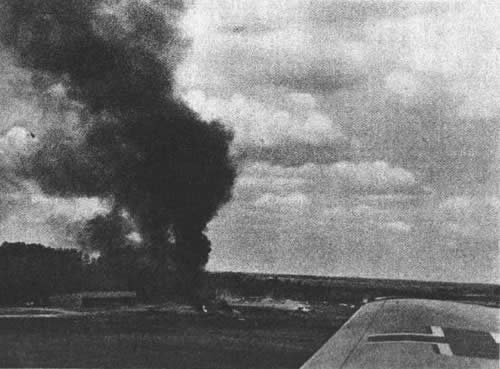
Aircraft of the Red Air Force were largely destroyed on the ground by the Luftwaffe Source: Public domain
In most places, the Wehrmacht met with little resistance during those early days. German shock troops overran the border posts, often before the border forces of the NKVD could be assembled. There were a few exceptions such as the fortress at Brest-Litovsk that courageously held out until it finally surrendered after three weeks. As the border posts were being overrun, the border forces of the Red Army made frantic efforts to man their allocated positions but on arrival , they often found them already occupied by German forward units.
Even before the Luftwaffe launched its first air attacks, specially trained Russian speaking commandoes of the Brandenburg Regiment were dropped in the rear of the Soviets by parachute. Dressed in Red Army uniforms, these troops sabotaged important communications and took possession of important bridges and traffic junctions. Next they created panic by giving misleading orders to passing Soviet military units and reporting great German successes. The Ukrainian nationalists, trained by the Germans during the months prior to Barbarossa, also participated in sabotage acts in the southern area of the front. Within a few hours all Soviet communications were as good as severed.
As the borders and areas in the rear were being bombed and strafed, Red Army commanders tried to interpret the instructions from Moscow. After all, prior to the invasion they had been ordered not to react to German provocations. The confusion was immense however and the commanders in the field had all but lost the overview on the battlefield as communication between the various units wasn't possible anymore. The result was that Soviet soldiers waited in vain for answers after they had asked their superiors by radio permission to return fire. After all, no one had told them the difference between a provocation and a targeted attack. In the ensuing chaos, orders were given, then countermanded and many units didn't receive orders at all owing to the sabotaged communication.
As the German armored columns were slicing through the Soviet armies, the high command in Moscow didn't have the slightest idea of what catastrophe had struck the Soviet Union. Owing to the centralized command structure, they were totally unable to take coordinated countermeasures. In the evening of the first day, at 19:15 People’s Commissioner of Defense Semyon K. Timoshenko, issued Directive Nr. 2, calling on the commanders of the military districts to launch a general counterattack but the old border with Germany was not to be crossed. Half a day later, he came up with a new directive, NKO Directive Nr. 3; he adapted the demands and this time, the border could be crossed. It was strictly forbidden though to cross the borders with Finland and Rumania as they hadn't (yet) launched the (expected) attack.
Timoshenko’s orders were an illusion: the reserves were far from being mobilized and detailed plans for attack were non-existent. As communication at the fronts was impossible, the depots on fire and the Luftwaffe ruling the airspace, these attacks were doomed to fail.
The opening day of Operation Barbarossa also meant the last day of diplomatic relations between the Third Reich and the Soviet Union. As early as 04:00, Dekanozov, the Soviet ambassador in Berlin met Joachim von Ribbentrop, the German Reichsaußenminister to demand an explanation for the German attack. Surprisingly, the Soviet ambassador was handed a completed declaration of war in writing without having his questions answered. This declaration stated: ‘the hostile policy of the Soviet Union towards the Third Reich’ as the main reason for Operation Barbarossa. When the ambassador returned to his embassy in order to forward the declaration to Moscow, the lines turned out to be dead. A few hours later, Reichspropagandaminister Joseph Goebbels read Hitler’s official declaration of war on German state radio.
Even before Joseph Goebbels delivered his speech on radio the German ambassador in Moscow, Schulenburg, asked for a talk with Vyacheslav M. Molotov, the People’s Commissioner for Foreign Affairs. He asked for an explanation to which Schulenburg responded: ‘Due to the unbearable pressure by Russian troops on the German troops on the demarcation line running through Poland, German troops have been ordered to enter Russian territory.‘ Not long after, Molotov delivered a speech on Soviet state radio, announcing the German invasion and calling on the Soviet population to assist the Red Army as much as possible.
At about the same time, the British Ministry of Foreign Affairs forwarded the news of the German invasion to Chequers, Winston Churchill’s country residence. Subsequently, the British Prime Minister spent the whole day writing a suitable speech which he delivered on radio at 21:00. Winston Churchill declared: ‘Every man and every country fighting Nazism can count on our support.’ He also declared: ‘We shall do everything in our power to support Russia and the Russian population.’
Definitielijst
- invasion
- Armed incursion.
- Luftwaffe
- German air force.
- Nazism
- Abbreviation of national socialism.
- Red Army
- Army of the Soviet Union.
- Regiment
- Part of a division. A division divided into a number of regiments. In the army traditionally the name of the major organised unit of one type of weapon.
- resistance
- Resistance against the enemy. Often also with armed resources.
- Soviet Union
- Soviet Russia, alternative name for the USSR.
- Wehrmacht
- German armed military forces, divided in ground forces, air force and navy.
Operations on the Baltic
Heeresgruppe Nord, commanded by Generaloberst Wilhelm Ritter von Leeb was the weakest of the three army groups as to equipment. Pursuant to the Barbarossa order of the OKH, issued on January 31, 1941, the army group was tasked with: ‘destroying the enemy formations on the Baltic, occupying the Baltic ports and subsequently Leningrad and Kronstadt, robbing the Russian fleet of its bases.’ To this end, the Heeresgruppe had two infantry armies and an armored group at its disposal.
Heeresgruppe Nord
18. Armee commanded by Generaloberst Georg von Küchler consisted of seven infantry divisions and was tasked with occupying the Baltic seaports. Von Küchler would fulfill this task by launching the main attack from Tilsit on his right flank in the direction of Riga in order to encircle and destroy the enemy forces southwest of Riga.
Panzergruppe 4 commanded by Generaloberst Erich Hoepner, was concentrated in the center of the frontline of Heeresgruppe Nord, in the north of Eastern-Prussia. In contrast to the habit of other army groups, Wilhelm Ritter von Leeb decided to keep this unit under his direct command. The group made up the spearhead of the attack and consisted of three armored divisions, three motorized infantry divisions and two infantry divisions, spread over two armored corps: XXXXI armored corps commanded by General der Panzertruppen Georg Reinhardt which made up the left flank of the attacking force and LVI Panzerkorps commanded by Generaloberst Erich von Manstein the right flank. Instructions for Panzergruppe 4 read as follows: ‘Panzergruppe 4 is to facilitate a broad and fast attack on Leningrad. In order to achieve the final goal, it is necessary to advance as far as possible, time and space permitting and in so doing, prevent the enemy from establishing new in-depth defensive positions.
Generaloberst Ernst Busch, in command of 16. Armee, consisting of eight infantry divisions, took up position on the right flank of Panzergruppe 4, protecting the right flank of Panzergruppe 4 and launching the main attack towards Kaunas (Kovno) and Daugavpils (Dvinsk). The reserves of the group consisted of three infantry divisions which were to follow in support of 16. Armee.
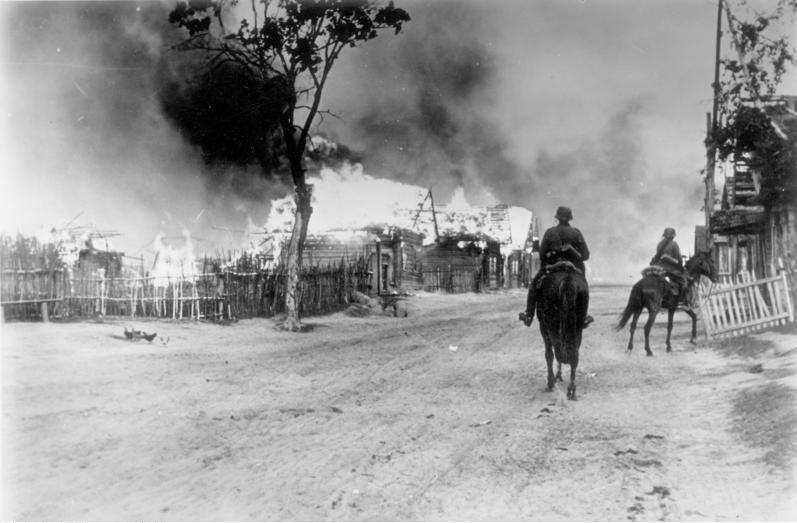
German soldiers in a burning Russian village. July 1941 Source: Bundesarchiv, Bild 101I-137-1032-14A / Kessler, Rudolf / CC-BY-SA 3.0
The first intermediate target for Heeresgruppe Nord was the river Dvina (Düna), 190 miles away; the second target was the region near Ostrov and Pskov on the river Velikaya, another 150 miles away. Air support to these operations was provided by Luftflotte 1 commanded by Generaloberst der Luftwaffe Alfred Keller.
The Special Baltic Military District
Facing Heeresgruppe Nord was the Special Baltic Military District commanded by Colonel-general F.I. Kutznetsov. This district, renamed the Northwestern Front on June 22 was the least equipped of these three special military districts. It was tasked with the defense of the northwestern axle and the roads leading to Leningrad. The first defensive echelon, deployed on the border, consisted of 8th Army commanded by Lieutenant-general P.P. Sobennikov and 11th Army commanded by Lieutenant-general V.I. Morozov. The frontline stretched from Libau to Grodno and was manned by eight Fuselier divisions consisting of on average 8,700 men. On the vulnerable dividing line between the Special Baltic Military District and the Special Western Military District, 11th Army had deployed only eight undermanned battalions to defend the roads leading to Vilno (Vilnius) These battalions took up positions along a frontline of no less than 50 miles.
8th Army was supported by Major-general N.M. Shestopalov’s 12th Mechanized Corps with some 750 outdated tanks at its disposal. 3rd Mechanized Corps commanded by Major-general A.V. Kurkin, supported 11th Army and was deployed around the city of Kaunas. This corps had 650 tanks at its disposal, of which 110 of the latest models of the KV-1, KV-2 and the T-34. Kurkin however faced the almost impossible task of defending the roads to Leningrad and Vilno simultaneously. Both corps were deployed some 60 miles inland and their units were widely dispersed.
The second echelon Kuznetsov had at his disposal was 27th Army commanded by Major-general M.W. Berzarin. This army had hardly been mobilized however and took up positions along the western Dvina.
The battle erupts
In the northwest, the first wave of German bombers attacked the naval bases at Riga and Kronstadt, airfields and communication centers in Kovno and Vilno but especially the forward bases of the Red Air Force. Not long after, Heeresgruppe Nord crossed the border into Eastern-Prussia. The Soviet divisions deployed on the frontline of Panzergruppe 4 were completely overwhelmed and driven back to the north, causing the border town of Tauruggen to fall in German hands. 1. and 6. Panzerdivision took advance of the breach in the Soviet defense and pushed on towards of Raseiniai. LVI Panzerkorps commanded by Erich von Manstein managed to capture the bridge at Airogola intact, enabling 8. Panzerdivision to advance no less than 40 miles in easterly direction to Kedainai on the first day of the invasion. Further to the southeast, 11th Army was routed by the advancing tanks of Generaloberst Hermann Hoth of 3. Panzergruppe, Heeresgruppe Mitte which succeeded in taking the bridges across the Nyemen unscathed.
There was much confusion at the headquarters of the Northwestern Front. Late in the evening of the first day, F.I. Kuznetsov ordered 12th and 3rd Mechanized Corps to prepare a counterattack on the flanks of Panzergruppe 4. Next day, the armored formations embarked on their advance across an area where the Luftwaffe enjoyed total air supremacy. The Soviet columns were plastered with phosphor grenades, knocking out the majority of the vehicles before they had even made contact with German ground forces.
On June 23, a massive engagement took place between tanks of 6. Panzergruppe and 2nd Tankdivision (3rd Mechanized Corps) east of Raseiniai. Two battalions, equipped with KV-1 and T-34 tanks overwhelmed reconnaissance units of 6. Panzerdivision and inflicted huge losses in men and material on the Germans. Initially, 6. Panzerdivision was driven back to the outskirts or Raseiniai but owing to the chaotic deployment of its tanks, the Soviets were unable to turn these successes to their advantage. Next day, 6. Panzerdivision was reinforced by units of 1. Panzerdivision and together they managed to encircle the units of 2. Tankdivision and in the end destroy them with the support of engineers.
Bridgeheads on the Dvina
This victory was exploited by LVI Panzerkorps. Late that afternoon, reconnaissance units reached the highway between Kauna and Daugavpils and advanced further without stopping. Hard on the heels of retreating Soviet formations, a special strike force fought its way to Daugavpils in the early morning of June 26 and captured both bridges against fierce resistance. Although in the course of the morning, the position of this group became critical due to repeated counterattacks, tanks of 8. Panzerdivision cane to the rescue quickly. Counterattacks were repulsed and towards the end of the day, the city itself was cleared of Soviet defenders.
Meanwhile 8th and 11th Army were in full retreat. 8th Army retreated to Riga while the remnants of 11th Army fled to the area east of Vilno. Panzergruppe 4 had managed to open a huge gap in the frontline of the Northwestern Front. On June 25, Marshal Semyon K. Timoshenko had already ordered Colonel-general K.I. Kuznetsov to establish a strong defensive line along the Dvina. The retreated units of 8th Army were to be deployed on the Dvina between Riga and Rivani while 11th Army was to take up positions between Livani and Kraslava. Thereupon Kuznetsov decided to have 27th Army join the battle while 2nd Mechanized Corps, commanded by Lieutenant-general D.D. Lelyuschenko was dispatched from Moscow to support 27th Army
The strong, natural barrier formed by the Dvina was quickly overcome however. Meanwhile, Generaloberst Erich Hoepner, correctly assuming that Soviet defense on the Dvina was only weak, had Reinhardt’s XLI Panzerkorps cross the Dvina along a broad front south of Daugavpils. Therewith the Germans beat the Soviets to it. Yet, D.D. Lelyuschenko managed to launch an attack against the bridgehead at Daugavpils in the early morning of June 28 with his 21st Mechanized Corps. With exactly 98 tanks, the majority made up of the outdated T-26, this corps was sent into battle. After a few critical moments the tanks were knocked out one by one and Erich von Manstein’s LVI Panzerkorps headed for Ostrov.
Reinhardt’s troops managed to cross the Dvina near Livani and Jekabpils (Jakobstadt) as well on June 29 and towards the evening of July 1 a wide bridgehead, 20 miles in depth was in German hands after weak Soviet resistance. Despite counterattacks near Daugavpils by 21st Mechanized Corps, on July 2 Panzergruppe 4 was ready to advance on the second target of the offensive, the area around Ostrov and Pskov, the location of important crossings of the river Velikaya.
The Stalin line breached
On June 29, Marshal Semyon K. Timoshenko had given orders to the effect that in case the defensive line along the Dvina was breached, new fortifications had to be erected on the Velikaya, the location of parts of the Stalin line. Subsequently, Colonel-general Kuznetsov was relieved of his function and replaced by the commander of 8th Army, Lieutenant-general P.P. Sobennikov. He faced an almost impossible task. The chaos among the defenders was enormous and he hardly had any reserves to man a new line.
In the morning of July 2, Panzergruppe 4 resumed its advance to the northwest along a broad front. On July 4, 8. Panzerdivision, 3. Infanteriedivision (Motorisiert) and SS-Division Totenkopf had reached the old border on the south flank between Latvia and the Russian Soviet Republic in many places. They were held up by fortifications of the partly dismantled Stalin line. The same day, 1. Panzerdivision captured Ostrov on the northern flank and after heavy fighting, units of 6. Panzerdivision penetrated the strong fortifications of the Stalin line on both sides of the road between Daugavpils and Ostrov, 20 miles south of Ostrov.
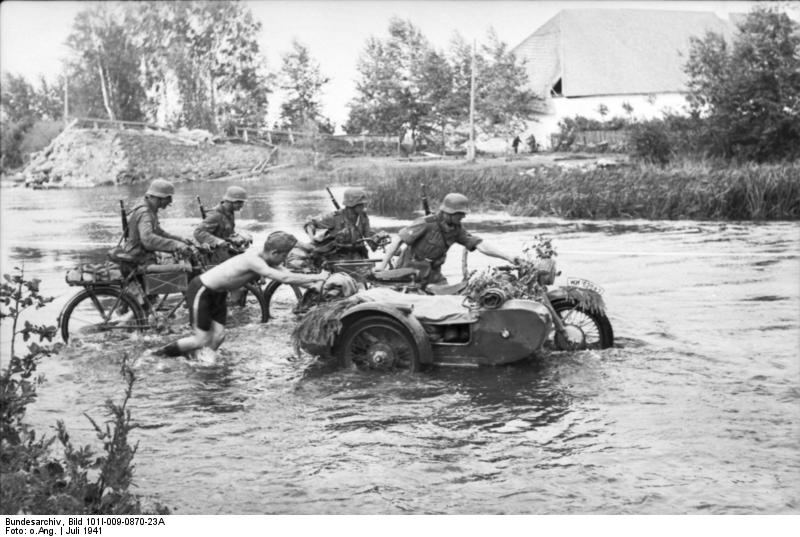
German soldiers during the advance through Latvia Source: Bundesarchiv, Bild 101I-009-0870-23A / CC-BY-SA
On July 7, the most important question at headquarters of Heeresgruppe Nord was how the unexpected fast advance of Panzergruppe 4 to the area around Pskov could be exploited best. Since the morning of July 4, the main body of the infantry had begun crossing the Dvina on a broad front, but if Panzergruppe 4 would continue its advance at the same speed, it would have to depend on its own fighting power as the further the advance progressed, the less protected the flanks would be. The Soviet forces retreated in disarray however and Generaloberst Erich Hoepner felt that the speedy advance could be maintained all the way to Leningrad. He was hoping that his own fighting power would be sufficient to launch a surprise attack on the outskirts of the city bearing Lenin’s name.
That same day, both armored corps struck further along both roads in the direction of Leningrad (the only roads in this vast territory). On the right, LVI Panzerkorps advanced from Ostrov to Porkhov while on the left flank, XIL Panzerkorps headed from Pskov to Luga. The terrain however became increasingly unsuitable for tank warfare. The wooded and marshy terrain the Germans were now entering, caused delays for Von Manstein’s advance. Meanwhile, Von Küchler’s 18. Armee drove the remnants of 8th Army through Latvia in the north. These severely battered formations had to prevent the Narva isthmus from falling into German hands.
Situation report
The first three weeks of battle in the northwestern sector on the Eastern Front had resulted in unexpected successes for Heeresgruppe Nord. Von Leeb’s troops had advanced no less than 280 miles and the Baltic states had almost completely fallen into German hands. The ultimate goal, Leningrad was just 150 miles away from his leading units and it seemed very likely that this distance could be covered in a short time. The Northwestern Front had been broken up and had lost some 90.000 men, over 1,000 tanks, 4,000 guns and mortars and 1,000 fighter aircraft. Moreover, the retreating remnants of 8th and 11th Army hadn't been able to establish a new defensive line, creating an acute threat to the troops of the Northern Front (the former Military District Leningrad) which in the meantime attempted to repulse a Finnish attack on the Karelian isthmus with everything in its power. The commander of this front, Lieutenant-general M.M. Popov, saw as early as June 25 that Leningrad was threatened from the south and therefore he decided to establish a defensive line at 30 to 60 miles south of the city on the banks of the river Luga.
Popov managed to withdraw a number of divisions from his frontline to the west and north of the city and deploy them on the Luga line. Over 50,000 inhabitants of Leningrad were called upon to dig trenches, tank ditches, fox holes and erect barbed wire fences while meanwhile factory workers and students reported voluntarily to serve in militia divisions, DNO= Divizy Narodnovo Opolchenia. which were also deployed on the Luga line. The battle of Leningrad would soon erupt and the outlook for the defenders was anything but favorable.
Definitielijst
- Fuselier
- In World War 2 the name of an infantry man armed with a rifle in, among others, the Dutch and Belgian armies. The soldiers of the Dutch guards regiment “Prinses Irene” are still called fusiliers.
- Heeresgruppe
- The largest German ground formation and was directly subordinate to the OKH. Mainly consisting of a number of “Armeen” with few directly subordinate other units. A Heeresgruppe operated in a large area and could number several 100,000 men.
- infantry
- Foot soldiers of a given army.
- invasion
- Armed incursion.
- Luftwaffe
- German air force.
- Marshal
- Highest military rank, Army commander.
- offensive
- Attack on a smaller or larger scale.
- OKH
- “Oberkommando des Heeres”. German supreme command of the army.
- resistance
- Resistance against the enemy. Often also with armed resources.
- Soviet Republic
- Regime based on the principle of the council system. Selected representatives have direct executive power. Regime was established after World War 1, also for some time in Bavaria and Hungary.
- Totenkopf
- “Death’s head”. Symbol that was used by the SS. Also the name of an SS Division.
Double encirclement at Byalistok and Minsk
Destruction was nowhere as massive as in the area north of the Pripjat marshes where Heeresgruppe Mitte started its advance eastwards. The unit was tasked with penetrating the Soviet line on both sides of the Bialystok salient and then advance along the highway to Minsk and Smolensk in the direction of Moscow. These actions would result in the encirclement and subsequent destruction of the Soviet divisions west of the Dniepr. The unit was ultimately ordered to destroy the enemy forces in the Baltic states and the region to the west in cooperation with Heeresgruppe Nord and then embark on the advance towards Moscow.
Heeresgruppe Mitte
Generalfeldmarschall Fedor von Bock was in command of the operations by Heeresgruppe Mitte. The unit consisted of 9. Armee, commanded by Generaloberst Adolf Strauß, 4. Armee commanded by Generalfeldmarschall Günther von Kluge, Generaloberst Hermann Hoth's Panzergruppe 3 (Ruoff's III. Armeekorps, Förster's VI. Armeekorps, Schmidt's XXXIX. Armeekorps (Motorisiert) and Kuntzen's LVII. Armeekorps) and Panzergruppe 2 (Schroth's XII. Armeekorps, Von Schweppenburg's XXIV. Armeekorps, Von Vietinghoff-Scheel's XXXVI. Panzerkorps and Lemelsen's XXXXVII. Panzerkorps), commanded by Generaloberst Heinz Guderian. Hermann Hoth was ordered to penetrate the Bialystok salient in the north with Panzergruppe 3 and head for Minsk via Vilno (Vilnius). Heinz Guderian’s Panzergruppe 2 was to cross the river Bug near Brest-Litovsk and also advance towards Minsk to join Hoth’s Panzergruppe 3. It was intended to encircle the Soviet troops west of Minsk and both infantry units would then see to the destruction of these forces. Air support for the operations of Heeresgruppe Mitte would be provided by Luftflotte 2 commanded by Generalfeldmarschall Albert Kesselring.
The Special Western Military District
Facing Heeresgruppe Mitte were four Soviet armies; from north to south 11th, 3rd, 4th and 10th Army respectively. 11th Army commanded by Lieutenant-general V.I. Morosov was supported by 3rd Mechanized Corps of the Special Baltic Military District. The other three armies were part of the Special Western Military District commanded by Colonel-general Dimitry G. Pavlov. In his rear, 13th Army commanded by Lieutenant-general P.M. Filatov also stood at his disposal. This unit had only established its headquarters but was in the process of mobilization. In the tip of the Bialystok salient, 10th Army commanded by Lieutenant-general K.D. Golubev was deployed, supported by the well-equipped 6th Mechanized Corps and 13th Mechanized Corps, operating almost without tanks. On the left flank of 10th Army, 4th Army commanded by Major-general A.A. Korobkov, took up defensive positions, supported by 14th Mechanized Corps. On the right flank of 10th Army, Lieutenant-general V.I. Kuznetsov’s 3rd Army was deployed, supported by 11th Mechanized Corps.
The German breakthrough
Following the opening artillery barrage on the defensive positions of 4th Army, Guderian and his Panzergruppe 2 struck towards the river Bug near Brest-Litovsk in the early morning of June 22, 1941. On arrival and to his great surprise he found the two bridges undefended and intact. North of Brest-Litovsk, 18. Panzerdivision managed to cross the Bug using the PzKpfw III Tauchpanzer (water proof tanks especially constructed for Operation Seelöwe) and strike towards the river Lesna where the bridges were found intact as well. Because there were too few bridges across the Bug (the most important were in Brest-Litovsk where strong resistance was encountered) to get the massive number of men and amounts of equipment across the river, traffic bogged down. In order to get it moving again, pontoon bridges were laid out south of Brest-Litovsk in order to allow the motorized formations to continue their advance east. The only fierce resistance, mentioned earlier, encountered by Guderian was in Brest-Litovsk itself. Opposition was so strong, Guderian risked getting behind his schedule. Therefore he asked the commander of 4. Armee if his infantry could take over the capture of the fortress Brest-Litovsk, allowing Panzergruppe 2 to continue its advance to the east in force. Generalfeldmarschall Günther von Kluge consented, provided that Heinz Guderian place his Panzergruppe 2 under direct command of 4. Armee, that is to say of himself. After Von Kluge had ordered 45. Infanteriedivision to capture Brest-Litovsk, Guderian’s motorized infantry was released and could continue its advance east, capturing Pruzhany the next day, June 23.
The first day had progressed extremely well for Hoth’s Panzergruppe 3. Following the preliminary barrage, the unit had penetrated the vulnerable line on the left flank of Heeresgruppe Mitte, which formed the dividing line between the armies of the Western Front (V.I. Kuznetsov’s 3rd Army) and the Northwestern Front (Morosov’s 11th Army). There were four bridges across the Nyemen in Hoth’s sector, the most important being located 28 to 44 miles inland. The Soviet 126th Division and 5th Tankdivision blocked the crossing at Otila though. Hermann Hoth requested additional air support and the Luftwaffe made short work of the Soviet defenders. The Soviets had more than enough time to blow the bridges but as the commander of 4th Bridging Regiment received no answer to his request to blow the bridges, they remained undamaged and fell into German hands. This allowed Hoth to rapidly establish a strong bridgehead on the eastern bank of the Nyemen. Meanwhile, 11th Army had drawn back in disarray and 3rd Army was driven south. The gap between 11th and 3rd Army had widened to 94 miles with the result that the road to Vilno lay entirely open and undefended.
Soviet countermeasures
Pavlov had no idea whatsoever what dire situation the Western Front had gotten into; communication with 4th Army headquarters had been severed by sabotage for instance. On the first day, Korobkov’s 4th Army had been hit hard by the German invasion on the first day, forcing him to move his headquarters from Kobrin to Pruzhany after heavy bombing by the Luftwaffe. Moreover, his communication lines to 10th Army had been broken by Guderian’s breakthrough. As described earlier, the defenders of Brest-Litovsk were isolated from 4th Army. Korobkov intended to relieve Brest-Litovsk in the afternoon of June 22 by launching a counterattack in cooperation with 10th Army but because there was no communication, he was on his own and only had 14th Mechanized Corps, stationed northeast of Brest-Litovsk, at his disposal. After a few hours of preparation, German dive-bombers appeared over the region where the corps was taking up positions; as a result, the counterattack never materialized. Thereafter, the remnants of Korobkov’s 4th Army were driven back to the east.
Pavlov did have intermittent contact with 10th and 3rd Army. Pursuant to NKO Directive Nr. 3, Pavlov had his deputy, Lieutenant-general Ivan V. Boldin fly to headquarters of 10th Army near Bialystok to set up a counterattack. Gobulev informed Boldin that his infantry had been severely battered by the German attacks and that in addition, his anti-aircraft guns had been destroyed. Gobulev had the reserves of his army assemble for the counterattack that was to be launched by the few remaining troops in the early morning of June 23. The intention was to attack from the line Bialystok – Grodno to prevent a German breakthrough to Volkovysk. Boldin and Gobulev had only few troops available.
Among these troops was incompletely equipped 13th Mechanized Corps, unfortunately consisting of outdated light T-26 tanks. Furthermore, Boldin and Gobulev had 3 Cavalry division at their disposal. Both formations merged into a strike force which assembled in the early morning of June 23 to launch the attack. A few moments after the advance had begun, the group was attacked by the Luftwaffe. Due to a shortage of anti-aircraft guns, the engagement turned into a blood bath and within a very short time, the improvised strike force had ceased to exist. The remnants of 10th Army would offer desperate resistance for a few days but in the end no longer existed as an organized strike force, apart from some hastily assembled troops desperately trying to break the German encirclement.
In Moscow, general confusion ran wild during those first disastrous days of Operation Barbarossa. Information on the situation at the front was hardly available and even if it was, it usually was outdated. As soon as the general staff in Moscow had some idea what catastrophe was unfolding at the front, it dispatched staff officers on patrol who informed Moscow each night about the actual situation at the front. Members of the Communist Party in the areas captured by the Germans, were also called upon to gather data about German strength and troop movements and forward it to Moscow.
Meanwhile, the two German infantry armies had started encircling movements in order to surround the troops near Bialystok. Generalfeldmarschall Günther von Kluge advanced from the south with his 4. Armee to an area east of Bialystok in order to make contact with 9. Armee commanded by Generaloberst Adolf Strauß which would arrive from the north. On June 23, XX. Armeekorps (9. Armee) had driven 56th, 85th and 27th division from Grodno to the right bank of the Nyemen, despite bitter resistance. Pavlov again dispatched his deputy to organize a counterattack with the intention to recapture Grodno (to prevent the troops near Bialystok from being surrounded) and, so Pavlov assumed, to launch an attack on the right flank of Panzergruppe 3. In reality, Hoth’s unit had advanced much farther to the east, had captured Vilno in the morning of June 24 and meanwhile was heading towards Molodechno.
The battle of Grodno
On June 24, I.V. Boldin went to the east of Bialystok where he was given command of 6th and 11th Mechanized Corps. Furthermore, he had 6th Cavalry Corps at his disposal. 6th Mechanized Corps was one of the best equipped of the Red Army. Commander Khatskilevich had 1,022 tanks at his disposal, 352 of which were the latest types of the KV-1 and T-34, while Mostovenko’s 11th Mechanized Corps had to make do with outdated vehicles. Supplies of fuel and ammunition were limited as the Luftwaffe had heavily bombed the depots.
Boldin sent his battered forces into battle nonetheless. 11th Mechanized Corps went in first, nearing Grodno from the south, followed by 6th Mechanized Corps which advanced from northeast of Bialystok to the southeast of Grodno. The attack began slowly. 11th Mechanized Corps had to cover 30 and 6th Mechanized Corps 44 miles to their jumping off points across terrain where the Luftwaffe reigned supreme. Consequently, the majority of the tanks never reached their starting positions. Lack of fuel and mechanical problems were other causes for this. Nonetheless, some 200 tanks managed to make contact with German infantry that initially didn't stand a chance. The shells of the 37mm anti-tank guns couldn’t possibly penetrate the thick armor of the modern Soviet tanks. Others desperately tried to stop the heavy KV-1 and the medium T-34 with hand grenades but these efforts failed as well. The Germans were pushed back from the southwest of Grodno to the north with Colonel N.P. Studnev’s 26th Tankdivision in the lead. General der Infanterie Friedrich Materna, commander of XX. Armeekorps requested additional air support and it was General der Flieger Wolfram Freiherr von Richthofen’ s VIII. Fliegerkorps that put an end to the Soviet advance of 4.5 miles. The STUKA‘s, using phosphorus bombs in some cases, proved highly effective in destroying the long columns of tanks and so, the Soviet counterattack petered out slowly.
Soviet losses rose to over 50 % and Boldin had no other choice than turn and run. The remnants of the Soviet formations withdrew into the woods east of Bialystok. Boldin’s counterattack hadn't yielded the desired result but as the German advance was being delayed, numerous Soviet military could withdraw from the region around Bialystok and retreat to the east in order to evade the pincer movement of 9. and 4. Armee, although this escape turned out to be only temporary.
The Soviet retreat
On June 25, Marshal Semyon K. Timoshenko ordered Pavlov to withdraw his troops from the Bialystok salient in order to establish a defensive position along the line Lida-Slonim-Pinsk. With these formations and severely undermanned 13th Army, Pavlov was to defend the fortified districts Slutsk and Minsk. The intended retreat was to start in the night of June 25 to 26. This proved impossible however as 4th Army was trapped on the western bank of the Shchara and 10th and 3rd Army were desperately trying to withdraw to the east where there was still a gap of 30 miles wide between Volkovysk and Skydel. After having assessed the impossible situation, Pavlov issued orders to the commanders nonetheless. 13th Army was to take up defensive positions at Molodechno, 3rd Army near Lida, 10th Army near Slonim (which meanwhile had been overrun by the Germans) and 4th Army in the south in the region of Pinsk. Next morning, Pavlov evacuated his headquarters to Mogilev.
XXIV Panzerkorps, part of Generaloberst Heinz Guderian’s Panzergruppe 2 pushed through to the river Shchara after having captured Pruzhany. The river was crossed and the unit headed for Slonim, blocking the escape route of Korobkov’s 4th Army. He responded by transferring two divisions (55th and 121st) from Slutsk and Bobruisk to the region around Slonim and Baranovich. Meanwhile Heinz Guderian had captured Baranovich and he dispatched 17. and 18. Panzerdivision in the direction of Minsk. In order to keep the ring closed and so prevent Soviet forces to break out to the east, 29. Infanteriedivision (Motorisiert) had taken position northwest of Slonim. A random array of Soviet tanks and infantry of 47 Fusiliers Korps and 17 Mechanized Corps launched the counterattack on the columns of 29. Infanteriedivision. Losses on both sides were high and the German anti-tank weapons again didn't stand a chance against the Soviet tanks. Engineers had to take action once more to knock out the tanks with heavy explosives.
Meanwhile on the left flank of Heeresgruppe Mitte, Hoth’s Panzergruppe 3 had advanced in the direction of Molodechno. The road however was blocked by 100th Division but this unit was also destroyed by the armored forces, although the Germans suffered considerable losses as well. 13th Army commanded by Lieutenant-general Filatov was made up of the remnants of five divisions and 5th Tankdivision. After Pavlov’s order of June 25 to take up defensive positions near Lida, 13th Army drove towards its positions. That same night however, Filatov’s headquarters were overrun and as a result, the Germans laid their hands on detailed Soviet defensive plans. Hoth’s armored units captured Molodechno the next day.
On the right flank of Heeresgruppe, units of 1. Kavaleriedivision and 4. Panzerdivision, both part of Guderian’s Panzergruppe 2, had advanced along the northern tip of the Pripjat marshes. On June 27, they arrived in the vicinity of Slutsk. Pavlov however had ordered units of 20 Mechanized Corps and 4 Airlandingkorps to launch a last counterattack. 20 Mechanized Corps only had 94 outdated tanks at its disposal and struck from Minsk in the direction of Slutsk. The two airborne brigades (7th and 8th) were to be dropped near Slutsk but owing to a shortage of transport aircraft, they were sent to Slutsk on foot. There they encountered units of 1. Kavaleriedivision and Walter Model’s 3. Panzerdivision, resulting in a massive blood bath with high losses on Soviet side. After having repulsed the counterattack, Model’s forces captured the town of Bobruisk that same evening and headed for the river Berezina.
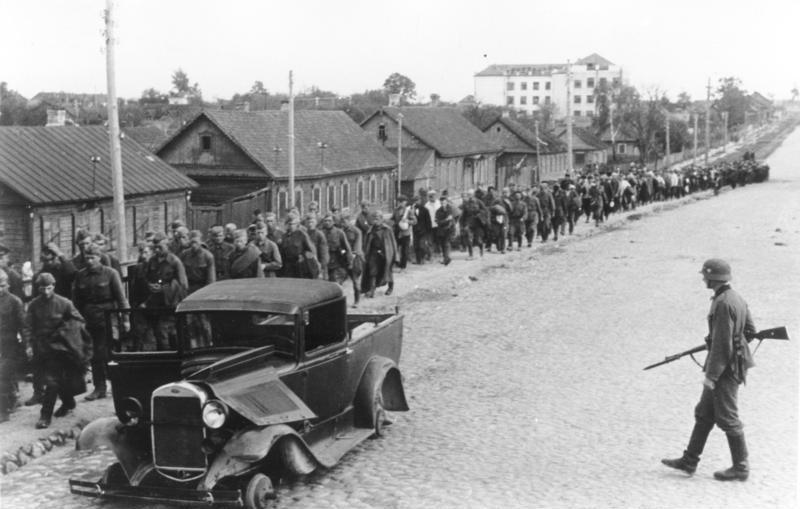
Prisoners-of-War of the Red Army, Minsk July 2, 1941 Source: Bundesarchiv, Bild 146-1982-077-11 / CC-BY-SA 3.0
The trap snaps shut
Despite Pavlov’s frantic efforts, the ring to trap the remnants of 10th, 3rd, 4th and parts of 13th Army was closed on June 30 when Hermann Hoth’s Panzergruppe 3 and Heinz Guderian’s Panzergruppe 2 met each other a little west of Minsk. In fact, the Western Front ceased to exist as an organized fighting force. 9. and 4. Armee were ordered to finish the job but the unorganized Soviet forces offered fierce resistance. As Heeresgruppe Mitte didn't have sufficient troops to completely close the ring around the Soviet armies, Hitler ordered the commanders of Heeresgruppe Mitte to stop their advance east. Very much against the will of Fedor von Bock, Heinz Guderian and Hermann Hoth, the mobile formations on the eastern side of the Minsk salient took up defensive positions. In addition, the OKH allocated 2. Armee commanded by Generalfeldmarschall Maximilian Freiherr von Weichs to Heeresgruppe Mitte to clear up the nests of resistance. Nonetheless, Guderian and Hoth dispatched units of 3., 17. and 18. Panzerdivision in the direction of the Berezina to establish bridgeheads, resulting in a fierce argument between Günther von Kluge and Heinz Guderian. This meant Operation Barbarossa had entered a new phase: the battle of Smolensk.
As late as July 9, the encircled forces surrendered after their supplies of ammunition had run out. The German claimed to have taken 287,704 Soviet prisoners-of-war and captured 2,585 tanks. According to the Soviets, losses at the Western Front amounted to 417,790 victims, of 341,073 soldiers killed, taken POW or missing. The Western Front also lost 4,799 tanks, 9,427 artillery pieces and 1,777 fighter aircraft. But as the Germans didn't have sufficient troops to completely close the ring, large numbers of Soviet soldiers managed to escape through the gaps and retreat across the right bank of the Berezina. Boldin for instance managed to break out eastwards with 1,654 soldiers and joined the main body of the Red Army. Others, like for instance Colonel Nikiporovich managed to escape capture and set up partisan units which were to make things very difficult for the Germans in the years ahead. Pavlov, having escaped from the encirclement was succeeded by Lieutenant-general Andrei I. Yeremenko who was given the near impossible task to prevent the Germans from breaking out towards Smolensk. He held this position for only two days as Stalin decided to put his most experienced commander, Marshal Semyon K. Timoshenko, in charge of the important Western Front. Unfortunate Pavlov was recalled to Moscow to account for the catastrophe this front had suffered. One month later, Colonel-general D.G. Pavlov was executed on Stalin’s personal order, along with some members of his staff.
Definitielijst
- Cavalry
- Originally the designation for mounted troops. During World War 2 the term was used for armoured units. Main tasks are reconnaissance, attack and support of infantry.
- Heeresgruppe
- The largest German ground formation and was directly subordinate to the OKH. Mainly consisting of a number of “Armeen” with few directly subordinate other units. A Heeresgruppe operated in a large area and could number several 100,000 men.
- infantry
- Foot soldiers of a given army.
- invasion
- Armed incursion.
- Luftwaffe
- German air force.
- Marshal
- Highest military rank, Army commander.
- mobilization
- To make an army ready for war, actually the transition from a state of peace to a state of war. The Dutch army was mobilized on the 29 August 1939.
- OKH
- “Oberkommando des Heeres”. German supreme command of the army.
- POW
- Prisoner of War.
- Red Army
- Army of the Soviet Union.
- Regiment
- Part of a division. A division divided into a number of regiments. In the army traditionally the name of the major organised unit of one type of weapon.
- resistance
- Resistance against the enemy. Often also with armed resources.
Fighting in the Ukraine
Generalfeldmarschall Gerd von Rundstedt, commanding Heeresgruppe Süd had been given the most ambitious task. The unit operated to the south of the Pripiat marshes while the main concentrated power (Heeresgruppe Nord and Mitte) was deployed to the north with three out of the four armored groups. Von Rundstedt’s unit was split into two wings. The north wing, operating from the southeast of the Generalgouvernement (the part of Poland occupied by Germany in 1939), consisted of two armies and an armored group, a total of 34 divisions. The southern wing, stretching from the Karpathians to the Black Sea consisted of just 11. Armee, commanded by Generaloberst Eugen Ritter von Schobert (eight divisions).There were two Rumanian armies as well but they were poorly equipped and incomparable to a German field army as to fighting quality. The southern wing was named Heeresgruppe Antonescu as it was commanded by Rumanian dictator Marshal Ion Antonescu.
The tasks were allocated as follows: 6. Armee commanded by i>Generalfeldmarschall Walther von Reichenau was to open a corridor in the Soviet line of defense, allowing Panzergruppe 1 commanded by Generaloberst Ewald von Kleist to advance at speed, initially towards the river Dniepr south of Kiev and subsequently southwards along the bank of the river behind the Russian Southwestern Front to the Black Sea. 17. Armee commanded by General der Infanterie Carl-Heinrich von Stülpnagel was to advance on Vinnitsa and continue east or southeastwards to meet up with Panzergruppe 1. The expected result was the annihilation of the entire Southwestern Front west of the Dniepr and the capture of the northwestern part of the Ukraine up to the river.
In the south, Heeresgruppe Antonescu was to protect the Ploesti oilfields and protect the northern wing against a possible effort by the Soviets to circumvent it. Furthermore to assist in exploiting the expected result by advancing eastwards, annihilate the Southern Front and capture the southwestern part of the Ukraine. This way, the entire Ukraine west of the Dniepr (the area known in Eastern-Europe as right-bank Ukraine), would fall into German hands.
The military districts Kiev and Odessa
The Military District Kiev, renamed Southwestern Front on the day of the German invasion, was the most powerful Soviet force on the western border. Commander Colonel-general Mikhail P. Kirponos had four armies, eight mechanized corps and an airlandingkorps at his disposal. Deployed on the border from north to south were: 5th Army commanded by Lieutenant-general M.I. Potapov, 6th Army commanded by Lieutenant-general N.I. Musichenko, 26th Army commanded by Lieutenant-general F.I. Kostenko and 12th Army commanded by Lieutenant-general Ponedelin. These armies made up the first defensive echelon. 5th Army was supported by Major-general Konstantin K. Rokossovsky’s 9th Mechanized Corps and 22nd Mechanized Corps commanded by Major-general S. I. Kondrusev. 6th Army was supported by well-equipped 4th Mechanized Corps commanded by Major-general Andrei A. Vlasov and 15th Mechanized Corps commanded by Major-general I.I. Karpezo. 26th and 12th Army were allocated 16th Mechanized Corps commanded by
The general staff had allocated considerable reserves to Colonel-general Kirponos including 19th Mechanized Corps commanded by Major-general N.V. Feklenko and 24th Mechanized Corps commanded by Major-general V.I. Chistiakov. A few days before the start of Operation Barbarossa, the first units of Lieutenant-general M.F. Lukin’s 16th Army and Lieutenant-general Ivan S Konev’s 19th Army began arriving on the banks of the Dniepr.These units were being transferred from the hinterland and at the time of the German attack, they were far from being completely mobilized. These forces were to form the second defensive echelon.
In contrast to the Baltic and Western Military Districts Mikhail P. Kirponos had created an in-depth defensive echelon in his northern sector. In the week prior to the German invasion, he had, on his own initiave, seen to it that his troops were particularly alert by entering into a cooperation with the NKVD. Moreover, his communications were far better than elsewhere at the front. On the eve of the German invasion, the attentive Kirponos was at his command post, ready to respond to the enemy attack.
South of the Military District Kiev the Military District Odessa was located which was responsible for the defense of the Rumanian border. Although Heeresgruppe Antonescu didn't attack on June 22, the Military District Odessa was on full alert, just like its neighbor in the north, thanks to the attentive conduct of the chief of staff Major-general M.V. Zhakarov, despite Commander Colonel-general I.V. Tyulenev being in Moscow that weekend. The Military District Odessa was activated on June 25 as the Southern Front and consisted of 9th Army, commanded by Colonel-general I.T. Cherevichenko and 18th Army commanded by Lieutenant-general A.K. Smirnov. These two armies were supported by 2nd Mechanized Corps, commanded by Lieutenant-general I.V. Novoselsky.
The German invasion
In the early morning of June 22, the forward units of Ewald von Kleist’s Panzergruppe 1 sped eastwards and managed to capture some crossings on the Bug intact. Although the border posts were better manned than in the area to the north of the Pripiat marshes, the Germans managed to encircle them but it did take three days before they were completely destroyed. Panzergruppe 1 struck mercilessly at the dividing line between 5th and 6th Army. Pursuant to NOK Directive Nr. 3 Kirponos finalized the plans for a gargantuan counteroffensive. The chief of the general staff, general Gheorghy K. Zhukov was sent from Moscow to the headquarters of the Southwestern Front to assist Kirponos in coordinating the attack. The mechanized corps in the rear area were ordered to man their allocated start positions and prepare for the counteroffensive.
Meanwhile on the second day of the invasion, Panzergruppe 1 and Walther von Reichenau’s 6. Armee had opened a gap of more than 30 miles in the Soviet defense allowing Eberhard von Mackensen’s III. Armeekorps (13. and 14. Panzerdivision) and Werner Kempf’s XLVIII. Panzerkorps to advance in the direction of Dubno at speed. South of them, Von Stülpnagel and his 17. Armee encountered a resolute Soviet defense west of Lvov (Lemberg) but managed to drive a wedge between 6th and 26th Army. Kirponos decided to throw 15th Mechanized Corps into battle in order to bring the German forward units to a halt. As there hadn't been sufficient time to prepare, the corps was compelled to deploy its troops piece meal on June 23. This meant counterattacks could be more easily repulsed by the German infantry. 11. Panzerdivision, the spearhead of XLVIII. Panzerkorps managed to penetrate the Soviet defense up to a distance of 37 miles. One day later, 22nd Mechanized Corps launched a counterattack. East of Vladimir-Volynsky, fighting broke out between the spearhead of Von Mackesen’s III. Korps (units of 13. and 14. Panzerdivision), 215th Motorized Division and 19th Tankdivision. 22nd Mechanized Corps was decimated with help from the Luftwaffe and the Germans managed to reach the outskirts of Lutsk. Here, heavy fighting broke out again and it took until June 26 before Lutsk was entirely in German hands while 11. Panzerdivision captured Dubno without any resistance worth speaking of.
On June 26, Panzergruppe 1 found itself in an ideal position to push through to Kiev, the political and industrial heart of the Ukraine. Meanwhile, Kirponos had assembled sufficient troops to launch a strong counteroffensive. Urged by the chief of the general staff, General Gheorghy Zhukov, Kirponos ordered 19th and 9th Mechanized Corps to attack the German spearhead at Dubno and Lutsk. Both corps however were seriously undermanned. Lieutenant-general M.I. Potapov, commander of 5th Army, was given supervision over the counterattack which was to be launched from Rovno to the west. His staff however was inexperienced, communications were partly severed and air support was hardly available. Further south, 15th and 8th Mechanized Corps were to attack the Germans on their right flank, also in the direction of Dubno. These two corps were equally undermanned. Powerful 4th Mechanized Corps, commanded by Andrei A. Vlasov, was still too far away to the east to arrive in time to join the counteroffensive.
The tank battle at Dubno
On June 26, notwithstanding all problems, the counterattack was launched to the north and south of Dubno resulting in a tank battle on a scale hitherto unknown in which over 2,000 tanks were involved. Initially, 8th and 15th Mechanized Corps gained some successes by attacking 57. Infanteriedivision in its flank, throwing it back over 6 miles. The same night, General Zhukov ordered 8th Mechanized Corps to push through to Dubno where the unit encountered a resolute defensive shield by 16. Panzerdivison. Next day, 34th Tankdivision tried again but without the desired results. German artillery and dive-bombers could attack 8th Mechanized Corps at will and owing to the superior German tactics, the unit was surrounded and destroyed. 15th Mechanized Corps was pulverised likewise by fierce attacks from the air and during an evasive action, the unit got stuck in a swamp causing the majority of vehicles and tanks to be abandoned.
North of Dubno, 19th Mechanized Corps also tried to advance on the town on June 26. 11. and 13. Panzerdivision launched a counterattack and pushed 40th and 43rd Tankdivision back to Rovno. Further south, Major-general Konstantin K. Rokossovsky's 9th Mechanized Corps attacked in the direction of Dubno as well. Communication with 19th Mechanized Corps was severed hoewever and losses among the light tanks (T-26 and BT-7) were extremely high. After this failed counterattack, the next day, Rokossovsky was ordered to resume his counterattack but instead he opted for defensive positions, ambushing 13. Panzerdivision nearing Dubno. For the first time in the war, the Germans were plastered on a large scale by Soviet artillery and suffered severe losses. Rokossovsky’s losses had increased through actions by the Luftwaffe and the next day the young commander was ordered to withdraw. The severely battered units of 5th Army withdrew to the north to the outliers of the Pripiat marshes. Generalfeldmarschall Gerd von Rundstedt decided not give his subordinates permission to pursuit. His caution did have consequences for the further progress of the operations. The commander of 6. Armee was therefore obliged to keep units in reserve to defend his left flank.
The Soviet retreat
The Soviet counteroffensives delayed Heeresgruppe Mitte for at least a week. The resolute and fierce resistance made Hitler’s later decision easier to have Generaloberst Heinz Guderian’s Panzergruppe 2 turn south in order to clear the Ukraine of Soviet resistance. Nonetheless, the German victories near Dubno and Brodno compelled M.P. Kirponos to give up his defense south of Lvov. 6th Army retreated to the north back to Lvov but had to cede the city to the Germans after three days in order to escape from the encirclement. That same day, July 9, Kirponos was ordered by Moscow to withdraw the remnants of 6th Army to the Stalin line. Further south, 26th and 12th Army were also ordered to withdraw to the south.
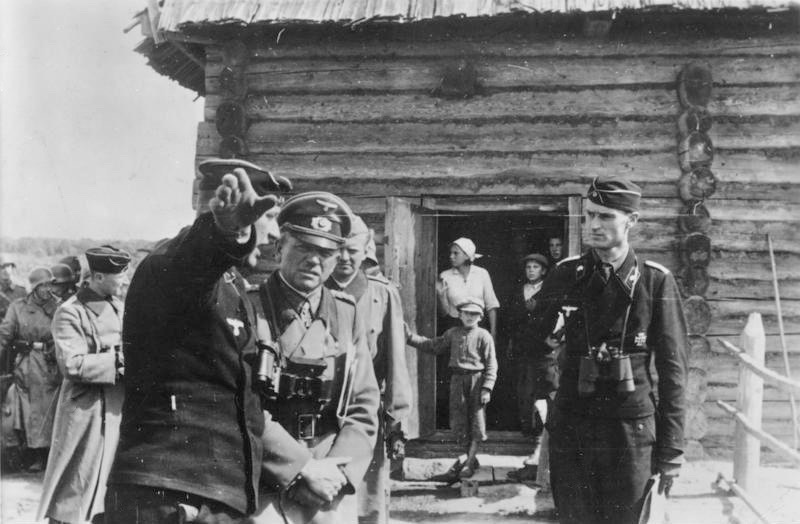
Generaloberst Guderian visits an armored regiment, August 1941 Source: Bundesarchiv, Bild 183-L19885 / Huschke / CC-BY-SA 3.0
During their withdrawal, 6th, 26th and 12th Army were continuously chased by Panzergruppe 1 and 17. Armee. Early July, Mackensen’s III korps advanced relentlessly from Rovno to the Dniepr. South of this advance, Kempf’s XLVIII Panzerkorps pushed through to Shepetovka. This threatened the retreating Soviet forces with encirclement. Kirponos responded by having 5th Army, which had been driven back to the Pripiat marshes, launch an attack against MacKensen’s left flank. Although these counterattacks failed, Mackensen was delayed for two days, allowing Kirponos enough time to withdraw his troops to new defensive lines.
Panic among Soviet units intensified though. Thereupon, Kirponos decided to establish so-called ‘blockade’ detachments that were ordered to execute every soldier who had escaped without having been ordered to. While the retreat continued, Mackensen’s III. Korps and Kempf’s XLVIII Panzerkorps managed to push through further south and capture Berdichev and Zhitomir. As Berdichev had been overrun by the Germans, the left flank of the Southwestern Front was in danger of being surrounded again. In order to prevent this, Kirponos ordered 6th Army, reinforced by 16th Mechanized Corps and the remnants of 15th Mechanized Corps, to hold the positions south of Berdichev at all costs. At the same time, peoples’ militia were established in Kharkov and Kiev to take up positions in the fortified District Kiev.
Offensive in Moldavia
On July 2, the southern wing of Heeresgruppe Süd (Heeresgruppe Antonescu) went into the attack against Soviet troops along the Moldavian border. The Southern Front, commanded by Colonel-general I.V. Tyulenev had set up a well though of defense and wouldn't let itself be surprised by the German-Rumanian troops. Generalfeldmarschall Von Rundstedt wanted 11. Armee to make an encircling movemnet in order to join 17. Armee on the right flank of the southern wing, intending to surround the Soviet troops btween the Karpathians and 11. Armee. The Rumanian 3rd and 4th Army were to clear the coast of the Black Sea and capture the important port of Odessa.
On the first day of the attack in the south, 11. Armee made spectacular progress. The Soviets however executed a tactical retreat, keeping their losses to a minimum. Von Schobert managed to reach the banks of the river Prut and capture Iassy but endured strong counterattacks by Cherevichenko’s 9th Army and Lieutenant-general I.V. Novoselsky’s 2nd Mechanized Corps. Tyulenev however overestimated the strength of the German attack and he submitted a request to Soviet high command to withdraw his troops to a defensive line along the Dniestr. High command approved but a few days later it came to the conclusion that the strength of the German offensive was limited. Hence it ordered Tyulenev to recapture the area lost and once again take up defensive positions on the banks of the Prut. The Soviet counterattack wasn't a success though and they were stopped between the Prut and the Dniestr, stabilizing the frontline. Smirnov’s 8th Army dug in, blocking the German advance in the extreme south.
The battles on the border in the Ukraine made it clear that German armored forces were definitively not invincible but despite the relatively successful defensive battles, losses of the Southwestern Front were high. Including the losses of 18th Army, these amounted to 241,594 men, of which 172,324 dead, missing or made pow. Material losses were also considerable. In the Ukraine, the Red Army lost no less than 4,381 tanks, 5,086 artillery pieces and mortars and 1,218 fighter aircraft. It was far more disturbing though that Heeresgruppe Süd had reached an ideal starting position to strike south into the rear of the Southwestern and the Southern Front.
Definitielijst
- Generalgouvernement
- That part of Polish territory occupied by the Germans in 1939. It was an autonomous part of Greater Germany. In August 1941 Eastern Galicia was added to the Generalgouvernement. It was governed solely by Germans under direction of Generalgouverneur Hans Frank. It was to become a full German province inhabited only by German colonists.
- Heeresgruppe
- The largest German ground formation and was directly subordinate to the OKH. Mainly consisting of a number of “Armeen” with few directly subordinate other units. A Heeresgruppe operated in a large area and could number several 100,000 men.
- infantry
- Foot soldiers of a given army.
- invasion
- Armed incursion.
- Luftwaffe
- German air force.
- Marshal
- Highest military rank, Army commander.
- Odessa
- Organisation of Former SS-members. Secret organization of and for former SS-members. Organised new identities and housing abroad after the war.
- offensive
- Attack on a smaller or larger scale.
- pow
- Prisoner of War.
- Red Army
- Army of the Soviet Union.
- resistance
- Resistance against the enemy. Often also with armed resources.
Epilogue
Hitler’s ‘crusade against Bolshevism’ enjoyed an extremely favorable start. By applying Blitzkrieg tactics during the first three weeks of Operation Barbarossa, the Germans had penetrated no less than 370 miles into Soviet territory. Belorussia was all but captured and vast areas of the Baltic states and the Ukraine had been overrun as well. The Wehrmacht had managed to pulverize the first defense echelon of the Red Army. The better part of the Western Front had been surrounded west of Minsk and meanwhile leading units of Heeresgruppe Mitte had reached the banks of the Dniepr. During the desperate defensive battles, the Red Army had lost at least 747,870 men, including 588,598 dead, injured or missing. Moreover, 10,180 tanks and 3,995 fighter aircraft had been lost.
Incomplete victory
Despite the extremely successful openings stages, the first doubts arose in German high command. Although a considerable number of Soviet military had been made pow, others literally fought to the death. The Wehrmacht hadn't experienced this before. During the campaign in the west against the western-European democracies a year earlier, the Germans had fought an enemy who had lost the will to resist until the end. Now it fought an enemy who was compelled by Communism to fight until death.
Secondly, after three weeks of battle, the Wehrmacht lagged behind its timetable, especially in the Ukraine. Neither had the majority of the Red Army been defeated as had been foreseen. The German intelligence services hadn't managed to paint a clear picture of Soviet troop concentrations. As the Germans penetrated deeper into the Soviet rear, time and again new Soviet formations appeared. The German high command had seriously miscalculated the number of troops the Soviet Union was able to deploy.
Thirdly, the advance of the three army groups didn't proceed at equal pace. Heeresgruppe Nord and Mitte had advanced much farther than Heeresgruppe Süd and in the Pripiat marshes, considered impassable by the Germans, 5th Army began to strike out against the flanks of Fedor von Bock’s Heeresgruppe Mitte and Gerd von Rundstedt’s Heeresgruppe Süd. Should this situation continue, then Adolf Hitler’s intended strategy to advance directly on Leningrad and Moscow could very well go up in smoke and the plans of attack should have to be adapted.
Finally, the first logistic problems emerged. The Soviet infrastructure was far less developed than that in France a year earlier and as a result, the leading Panzer formations couldn't be resupplied in time. Moreover, supply lines were vulnerable to raids by escaped Soviet soldiers. The railway gauge differed from the European, causing the Germans to rely on captured Soviet rail equipment. These problems would later evolve into a real nightmare for the German supply forces but for the time being, they were relatively easy to overcome.
German policy of occupation
The Einsatzgruppen, the murder squads of the Third Reich, followed close on the heels of the regular fighting formations. These units created blood baths among the Jewish population in the areas overrun by the Germans. Soviet prisoners-of-war were closely questioned and put under pressure to point out political Kommissars and members of the Communist Party in their ranks. The Wehrmacht handed these people over to the SS for summary execution. The other prisoners-of-war were also left to their own devices in the crowded pow camps. In its planning, the German high command had hardly taken the numbers of prisoners of war into account or not at all, resulting in them hardly being cared for or not at all. In the sweltering heat of the summer of 1941, large numbers of imprisoned Soviet soldiers perished from hunger and thirst while untreated injuries and diseases soon took their toll, raising the number of deaths to monstrous proportions.
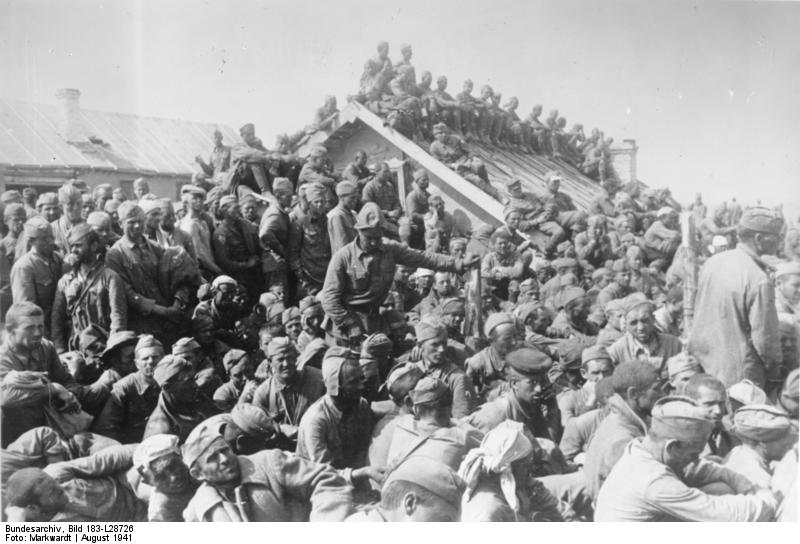
Soviet prisoners-of-war in a crowded camp near Smolensk, August 1941 0 Source: Bundesarchiv, Bild 183-L28726 / Markwardt / CC-BY-SA 3.
The German occupiers also created death and destruction among the civilian population. Although in the Ukraine and the Baltic states the Germans were initially welcomed as liberators from the yoke of Stalinism, the true nature of the occupiers soon unveiled itself. Hitler regarded not only the Jews as inferior people, the Slavic population was also labeled with the Nazi term Untermensch (subhuman). However, not only the Nazis were guilty of war crimes. The Soviets tortured and executed German military and pilots taken prisoner. The fact that the Soviets had no facilities to house prisoners of war, partly because the frontline rapidly moved to the east, makes it slightly more understandable but it cannot be used as an excuse. It became clear gradually that the German-Russian war was a collision between ideologies with both belligerents committing unimaginable cruelties.
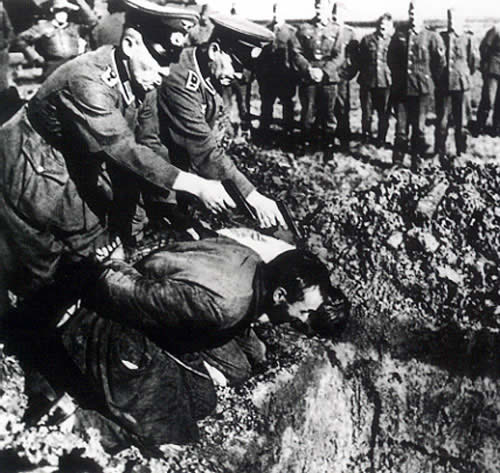
The death squads follow hard on the heels of the German armies; targeting Communist People’s Commissioners but mainly Jews Source: Public domain
Measures by the Soviet regime
Operation Barbarossa hit Stalin and his cronies like a sledgehammer. The one thing the Soviet dictator had hoped to avoid, had become horrifying reality. When it had become clear the plans for defense had failed, Stalin began taking drastic measures.
On June 23, 1941, Stavka SGK= Stavka Glavnokogo Komandovania was established, the headquarters of the high command; a council that became the highest authority of the Soviet armed forces and which was given responsibility to take important strategic decisions. The members of Stavka consisted of a military section (Gheorghy K. Zhukov, Kliment E. Voroshilov, Semyon M. Budenny, N.G. Kuznetsov) and a political section (Joseph V. Stalin and Vyacheslav M. Molotov), chaired by the former People’s Commissioner of Defense, Marshal Semyon M.Timoshenko. The general staff was made subordinate to Stavka, giving advice to Stavka.
The most far-reaching measure that was taken, was the formation of a war cabinet, the so-called State Defense Committee GKO= Gosudarstvenny Komitet Oboroni) on June 30, 1941. The GKO was authorized to coordinate all activities of all government departments, including Stavka and the general staff. The first members of the GKO, apart from Joseph V. Stalin were: Vyacheslav M. Molotov, Lavrenty P. Beria and G.M. Malenkov.
As the Germans had opened a gigantic breach in Soviet defense, the main industrial areas were endangered. In these areas, weapons were also being produced and the GKO decided that the factories, including their work force, be evacuated to the Ural and Siberia, well beyond reach of the Luftwaffe. Simultaneously, reservists were called up all across the Soviet Union to establish new units. In contrast to Hitler, Stalin understood at an early stage that this was total war, demanding the utmost from military as well as civilians.
The GKO decided to decentralize the high command in a certain sense by splitting the enormous front in three main sectors, each with its own command. Marshal Kliment E. Voroshilov was put in charge of the Northwestern Sector, including the Baltic and the Northern Fleet. Marshal Semyon K. Timoshenko became chief of the Western Sector and Marshal Semyon M. Budenny of the Southwestern Sector, including the Black Sea Fleet. Preparations were also made for a transition to a system of smaller armies, consisting of no more than five divisions. Once these measures had been taken, the response time decreased sharply, mainly because the command at corps level, between division and army, was canceled.
Because of the large number of Soviet soldiers that had surrendered, Stalin decided to extend the authority of the political Kommissars as well. These commissioners, the majority without any military training, was given the same authority again as military commanders. The terror reached a new low when Soviet soldiers, having escaped from encirclement, were arrested, questioned and in some cases executed by the NKVD for not having resisted to the end.
Stalin’s speech on radio
On July 3, 1941, Stalin delivered a short speech to his nation on radio for the first time. He appealed to the patriotism of the population of the Soviet Union and hardly mentioned the Communist ideals. Stalin called for merciless measures against deserters and panic mongers. Courts-martial were to immediately sentence anyone who thwarted the defense of the Soviet state by panic or cowardice, regardless of position or rank. Next, Stalin gave instruction for the application of the scorched earth policy. Not a single locomotive, not a single wagon, not as pound of bread or a liter of oil was to be left behind. All articles of value had to be transferred to the hinterland and possessions that could not be moved were to be destroyed. Finally he appealed to the inhabitants of the regions already overrun by the Germans. Stalin called for a merciless partisan war. Stalin’s speech had a huge influence on the nervous and mostly frightened and bewildered population of the Soviet Union.
Meanwhile, Great Britain and the Soviet Union were looking for rapprochement. Winston Churchill wrote a letter to Stalin and the British ambassador in Moscow conducted negotiations with Stalin and Molotov, laying the foundation of the Allied-Russian alliance. In contrast, the number of German allies increased. In the extreme north, the Finns attempted to recapture the territory lost during the Winter War while Rumania advanced through Moldavia from the south. Hungary declared war on the Soviet Union as well while Benito Mussolini wanted to play his part too in the ‘Crusade against Bolshevism.’ The Hungarians dispatched three poorly equipped divisions to the Eastern Front and the Italians sent an entire expeditionary force. All these troops were added to Heeresgruppe Süd.
As the Germans penetrated deeper into the Russian hinterland, the frontline increased in length. New fighting erupted when the Germans engaged the second defensive echelon of the Red Army. Heeresgruppe Nord advanced steadily on Leningrad (see Battle of Leningrad), Heeresgruppe Mitte was heading for Smolensk (see Battle of Smolensk) with the intention to strike towards Moscow while Heeresgruppe Süd encountered fierce resistance from the Southwestern Front, which ultimately would lead to a change in the German plan of attack (see Battle of Kiev). For the time being, it looked like nothing and nobody could stop the German war juggernaut but the question was for how long.
Definitielijst
- Blitzkrieg
- The meaning of this word is “Lightning War”. Short and fast campaign. As opposed to a trench war the Blitzkrieg is very quick and agile. Air force and ground forces work closely together. First used against the Germans (September 1939 in Poland.
- Communism
- Political ideology originating from the work of Karl Marx “Das Kapital” written in 1848 as a reaction to the so-called class struggle between the proletariat (labourers) and the bourgeoisie. According to Marx the proletariat would take over power from the well-to-do classes though a revolution. The communist movement aspires an ideal situation where the means of production and the means of consumption are common property of all citizens. This should end poverty and inequality (communis = common).
- heat
- High-explosive anti-tank warhead. Shaped charge projectile to punch through armour. Used in e.g. bazooka or in the Panzerfaust.
- Heeresgruppe
- The largest German ground formation and was directly subordinate to the OKH. Mainly consisting of a number of “Armeen” with few directly subordinate other units. A Heeresgruppe operated in a large area and could number several 100,000 men.
- Jews
- Middle Eastern people with own religion that lived in Palestine. They distinguished themselves by their strong monotheism and the strict observance of the Law and tradition. During World War 2 the Jewish people were ruthlessly persecuted and annihilated by the German Nazis. . An estimated 6,000,000 Jews were exterminated.
- Luftwaffe
- German air force.
- Marshal
- Highest military rank, Army commander.
- Nazi
- Abbreviation of a national socialist.
- pow
- Prisoner of War.
- Red Army
- Army of the Soviet Union.
- resistance
- Resistance against the enemy. Often also with armed resources.
- Soviet Union
- Soviet Russia, alternative name for the USSR.
- Stalinism
- Period in history of the Soviet-Union during which Stalin was the undisputed leader. The regime was totalitarian. Personality cult, terror of the secret police, cleansing, liquidations and an exaggerated chauvinism were characteristics of Stalinism. Many Eastern European countries adopted this form of dictatorship after the war.
- Stavka
- The high command of the Russian military forces in World War 2, chaired by Stalin.
- strategy
- Art of warfare, the way in which war should be conducted in general.
- war crimes
- Crimes committed in wartime. Often concerning crimes committed by soldiers against civilians.
- Wehrmacht
- German armed military forces, divided in ground forces, air force and navy.
Information
- Article by:
- Tom Notten
- Published by:
- Arnold Palthe
- Published on:
- 23-07-2022
- Last edit on:
- 30-09-2024
- Feedback?
- Send it!
Related sights
Sources
- Bagramian, Ivan K. Tak Nachinalas' Voina. Moskou: Voenizdat: 1971
- Barrett R.W. & Jackson W.E. (red.), Nazi Conspiracy & Aggression Volume 1. Washington D.C.: United States Government Printing Office, 1946
- Barrett R.W. & Jackson W.E. (red.), Nazi Conspiracy & Aggression Volume 2. Washington D.C.: United States Government Printing Office, 1946
- Blau G.E., The German Campaign in Russia: Planning and Operations (1940-1942). Washington D.C.: US Government Printing Office (Pamphlet no. 20-291), 1955
- Blau G.E., The German Campaigns in the Balkans (Spring 1941). Washington D.C.: US Government Printing Office (Pamphlet no. 20-260), 1953
- Boldin, Ivan V. Stranitsy Zhizni. Moskou: Voenizdat, 1961
- Boog, Horst (red). Das Deutsche Reich und der Zweite Weltkrieg. Band 4: Die Angriff auf die Sowjetunion. Stuttgart: Deutsche Verlags-Anstalt, 1987
- Bullock, Alan. Hitler and Stalin: Parallel lives, Londen: HarperCollins Publishers, 1992
- Burdick, Charles & Jacobsen, Hans-Adolf (red). The Halder War Diary, 1939-1942. Londen: Greenhill, 1988
- Carell, Paul. Unternehmen Barbarossa: Der Marsch nach Rußland. Frankfurt am Main: Ulstein Verlag, 1976
- Charles de Beaulieu, A.D.W. Der Vorstoß der Panzergruppe 4 auf Leningrad. Neckargemund: Kurt Vowinckel Verlag, 1961
- Churchill, Winston. De Tweede Wereldoorlog (12 delen). Amsterdam: Elsevier, 1979
- Erickson, John. The Soviet High-Command 1918-1941: A Military-Political History. Londen: MacMillan, 1962
- Erickson, John. The Road to Stalingrad: Stalin's War with Germany Volume 1. New Haven: Yale University Press, 1999
- Freidin, S. & Richardson, W. (red.). Fatal Decisions. New York: William Sloane Associates, 1956
- Glantz, David M. Stumbling Colossus: the Red Army on the Eve of World War. Lawrence KS: University Press of Kansas, 1998
- Glantz, David M. (red.), The Initial Period of War on the Eastern Front 22 June-August 1941. Londen: Frank Cass, 1999
- Glantz, David M. The Soviet Airborne Experience (Research Survey No. 4). Fort Leavenworth: Combat Studies Institute, 1984
- Glantz, David M. & House, Jonathan. When Titans Clashed: How the Red Army Stopped Hitler. Lawrence KS: University Press of Kansas, 1996
- Gorodetsky, Gabriel. Grand Delusion: Stalin and the German Invasion of Russia. New Haven: Yale University Press, 1999
- Hitler, Adolf. Mein Kampf. München: Zentralverlag der NSDAP, 1940
- Hoek, K.A. van den. Veldtocht tegen Rusland. Rotterdam: Lecturama, 1978
- Hoth, Hermann. Panzer-Operationen: Die Panzergruppe 3 und die operative Gedanke der deutsche Führung. Sommer 1941. Heidelberg: Kurt Vowinckel Verlag, 1956
- Hubatsch, Walter (red). Hitlers Weisungen für die Kriegführung: Documente des Oberkommando der Wehrmacht. Frankfurt am Main: Bernhard & Graefe Verlag, 1962
- Irving, David. Hitler's war and the war path. Londen: Focal Point Publications, 2002
- Irving, David. The Rise and Fall of the Luftwaffe. Londen: Focal Point Publications, 2002
- Kipp, Jacob W. Barbarossa: Soviet Covering Forces and the Initial Period of War. Fort Leavenworth: Foreign Military Studies Office, 1989
- Kipp, Jacob W. Mass, Mobility, And The Red Army's Road To Operational Art 1918-1936. Fort Leavenworth: Foreign Military Studies Office, 1988
- Klaus, Gerbert (red). Generalfeldmarschall Fedor Von Bock: The War Diary 1939-1945. Atlgen PA: Schiffer Publishing, 1996
- Krivosheev, G.F., Soviet Casualties and Combat Losses in the Twentieth Century. Moskou: Voenizdat, 1997
- Leach, Barry. German Strategy Against Russia 1939-1941. Londen: Oxford University Press, 1973
- Liddell Hart, Basill H., German Generals Talk. New York: William Morrow, 1968
- Mackensen, Eberhard von. Vom Bug zum Kaukasus: Das III. Panzerkorps im Feldzug gegen Sowjetrussland 1941/42. Neckargemünd: Scharnhorst Buchkameradschaft, 1967
- Mackintosh, Malcolm. Juggernaut: A History of the Soviet Armed Forces. Londen: Secker & Warburg, 1967
- Manstein, Erich von. Verlorene Siege. Bonn: Athenäum Verlag, 1955
- Maslov A.A., How Were Soviet Blocking Detachments Employed?. Fort Leavenworth: Foreign Military Studies Office
- Moskalenko, Kirill S., Na Iugo-zapadnom Napravleni 1941-1943 kniga 1. Moskou: Nauka, 1969
- Moynahan, Brian. The Claws of the Bear: A History of the Soviet Armed Forces from 1917 to the Present. Londen: Hutchinson, 1989
- Overy, Richard. Russia's War. Londen: Penguin books, 1998
- Philippi, Alfred & Heim, Ferdinand. Der Feldzug gegen Sowjetrußland 1941-1945: Ein operativer Überblick. Stuttgart: Kohlhammer Verlag, 1962
- Ratley L., A lesson of history: the Luftwaffe and Barbarossa. Air University Review 34 no. 3: 50-65, 1983
- Reinhardt, Klaus. Die Wende vor Moskau: Das Scheitern der Strategie Hitlers im Winter 1941/42 (Beiträge zur Militär- und Kriegsgeschichte). Stuttgart,1972
- Rokossovski, Konstantin K., Soldatskii Dog. Moskou: Voenizdat, 1988
- Salisbury, Harrison E. 900 Dagen: het beleg van Leningrad 1941-1944. Zwolle: Uitgeverij Erven J.J. Tijl, 1969
- Schramm, Percy E. (red.). Kriegstagebuch des Oberkommando der Wehrmacht 1939-1945 (8 delen). Frankfurt am Main: Bernhard & Graefe Verlag, 1965
- Seaton, Albert. The Russo-German War 1941-45. Londen: Arthur Barker, 1971
- Segbers, Klaus. Die Sowjetunion im Zweiten Weltkrieg. Die Mobilisierung von Verwaltung, Wirtschaft und Gesellschaft im "großen Vaterländischen Krieg" 1941-1943 (Studien zur Zeitgeschichte Band 32). München: Oldenbourg Verlag, 1987
- Shirer, William L. Opkomst en ondergang van het Derde Rijk. Amsterdam: H.J.W. Becht uitgeversmaatschappij
- Shtemenko, Sergei M. The Soviet General Staff at War 1941-1945. Moskou: Progress Publishers, 1970
- Sontag R.J. & Beddie J.S. (red.), Nazi-Soviet relations: Documents from the archives of the German Foreign Office. Washington: Department of State, 1948
- Stalin, Joseph V. On the Great Patriotic War of the Soviet Union. Moskou: Foreign Languages Publishing House, 1946
- Tippelskirch, Kurt von. Geschichte des Zweiten Weltkriegs. Bonn: Athenäum Verlag, 1954
- Vasilevski, Alexander M. Delo vsei Zhizni. Moskou: Politizdat, 1978
- Verkijk, Dick. Operatie Barbarossa: De Duitse inval in Rusland 1941. Amsterdam: Moussault, 1966
- Vladimirski, A.V. Na Kievskom Napravleni. Moskou: Voenizdat, 1989
- Volkogonov, Dimitri A. Triomf en tragedie: Een politiek portret van Josef Stalin. Houten: De Haan, 1990
- Warlimont, Walter. Im Hauptquartier der Deutschen Wehrmacht 1939-1945. Frankfurt am Main: Bernard & Graefe Verlag, 1962
- Werth, Alexander. Rusland in Oorlog 1941-1945. Amsterdam: Omega, 1979
- Whaley, Barton. Codeword Barbarossa. Cambridge MA: MIT Press, 1973
- Wray, Timothy A. Standing Fast: German Defensive Doctrine on the Russian Front During World War II. Research Surveys (Combat Studies Institute) no. 5, 1986
Thanks to Marcel Kuster for the maps
